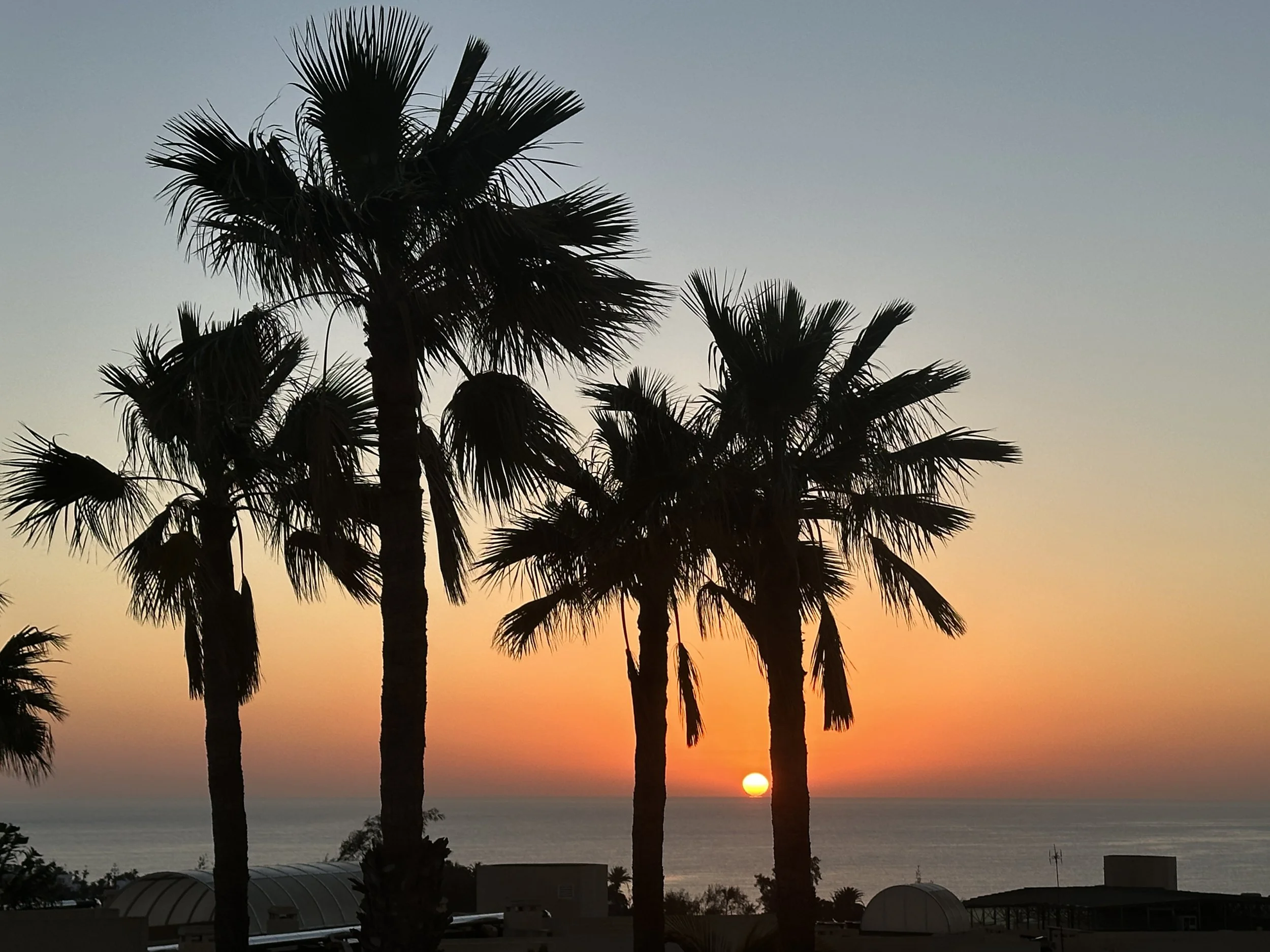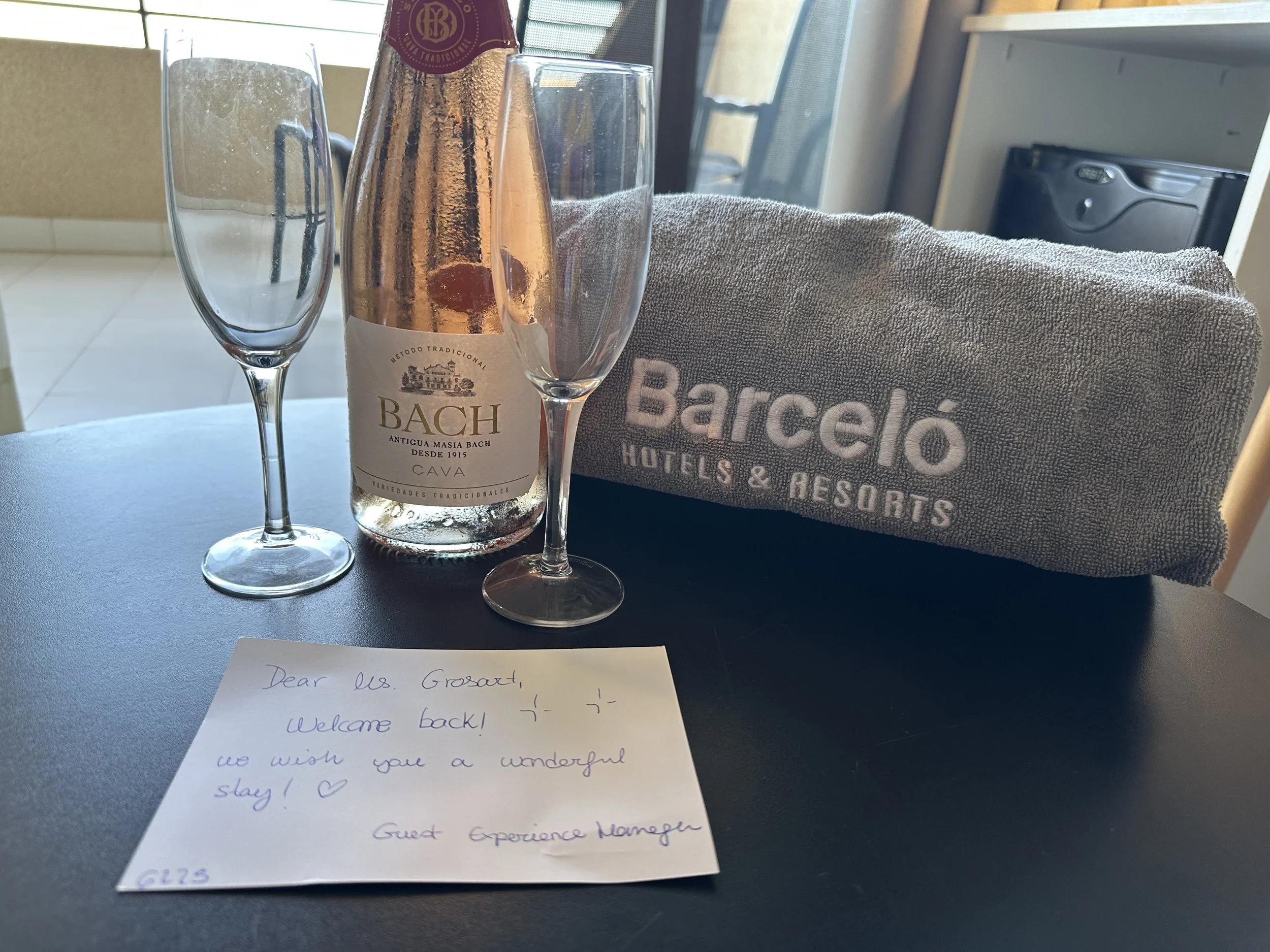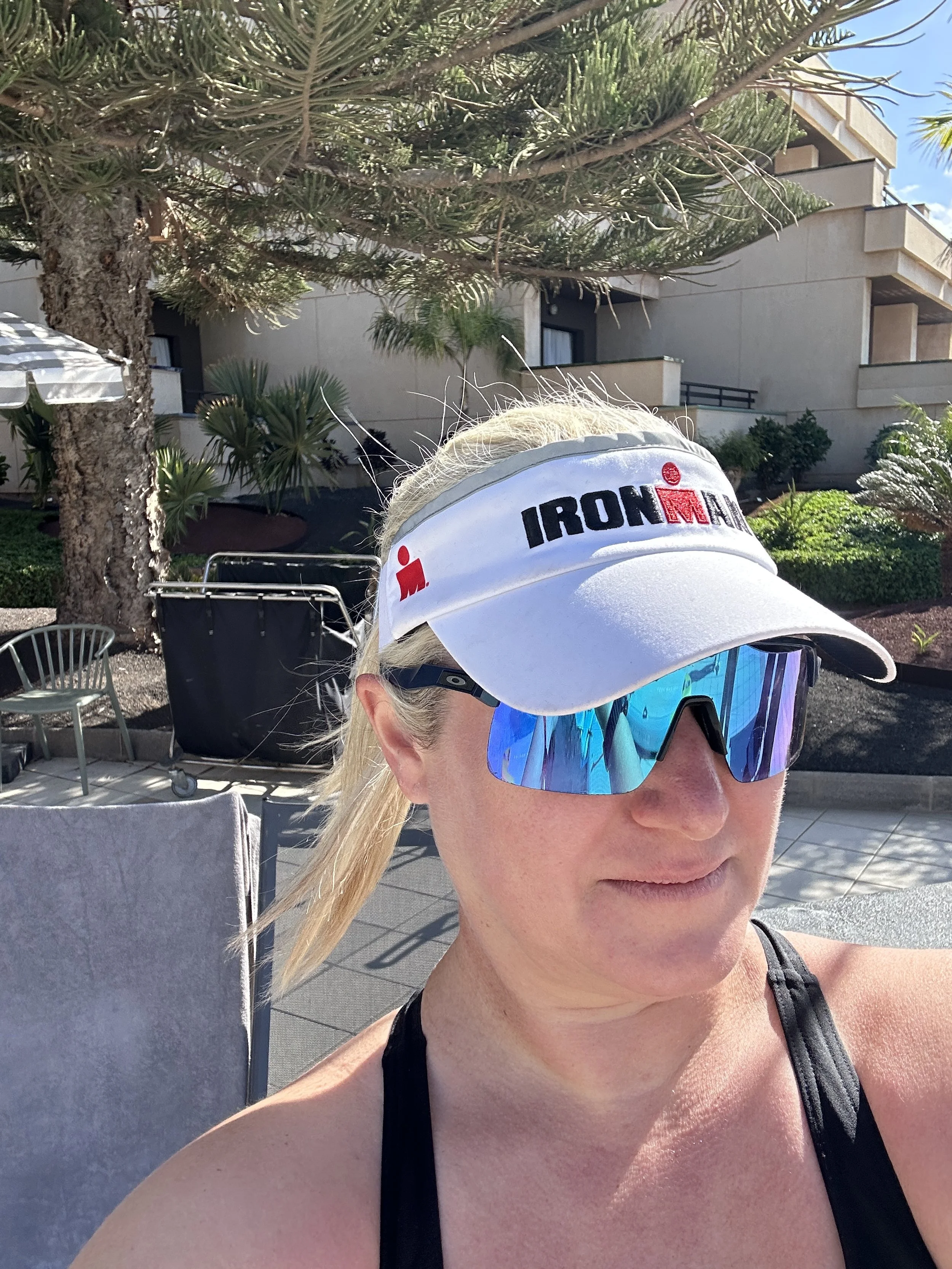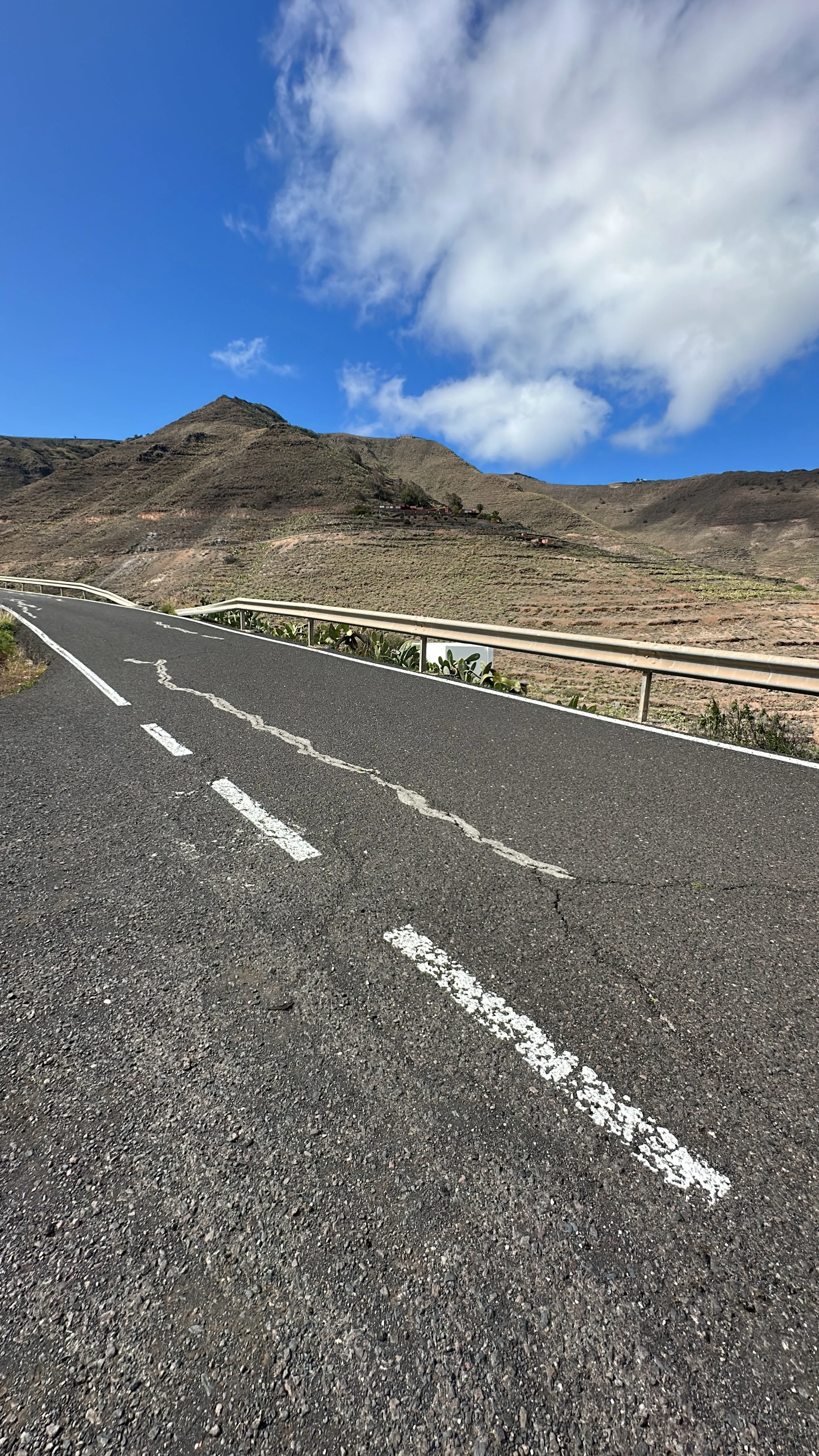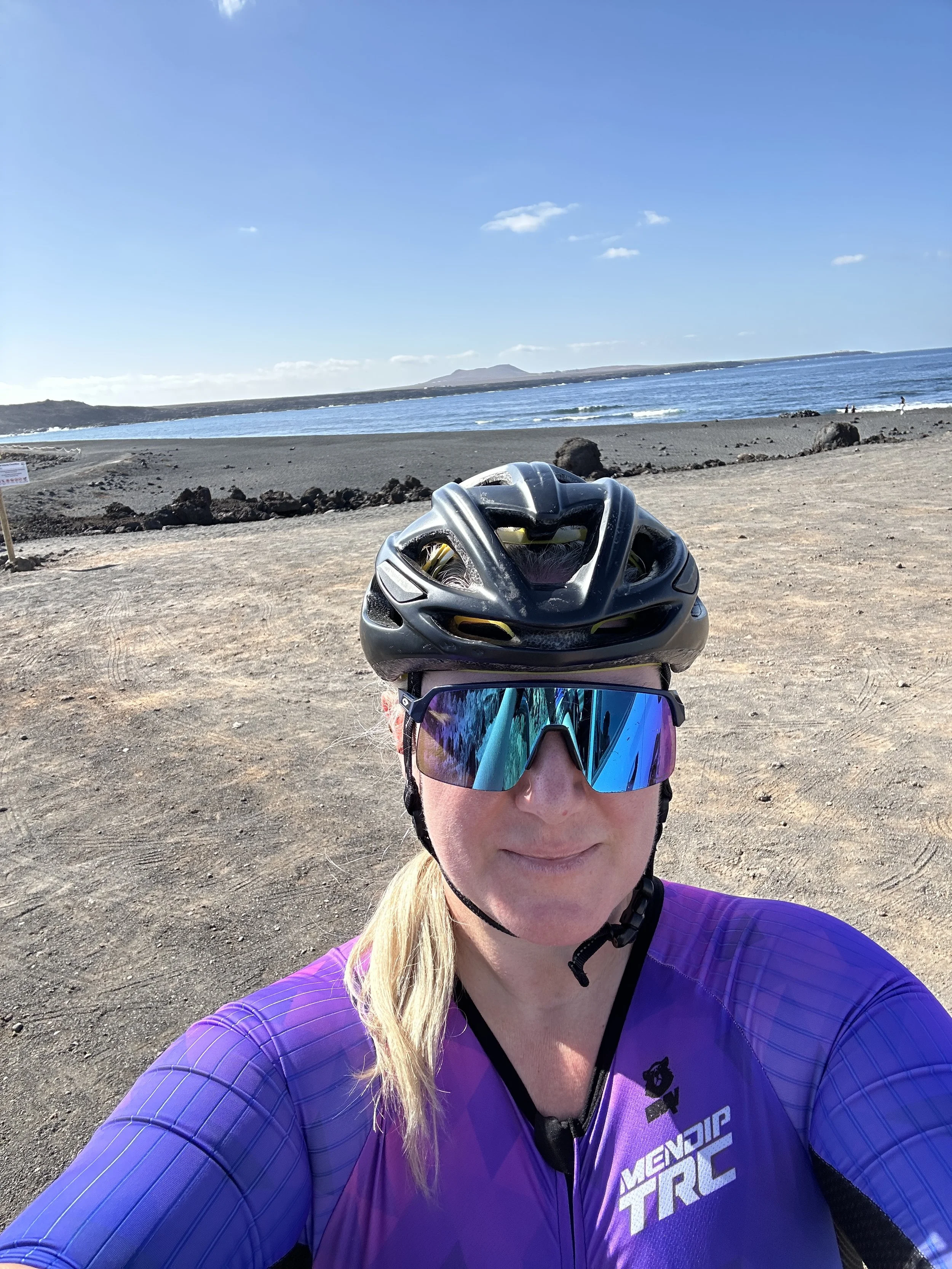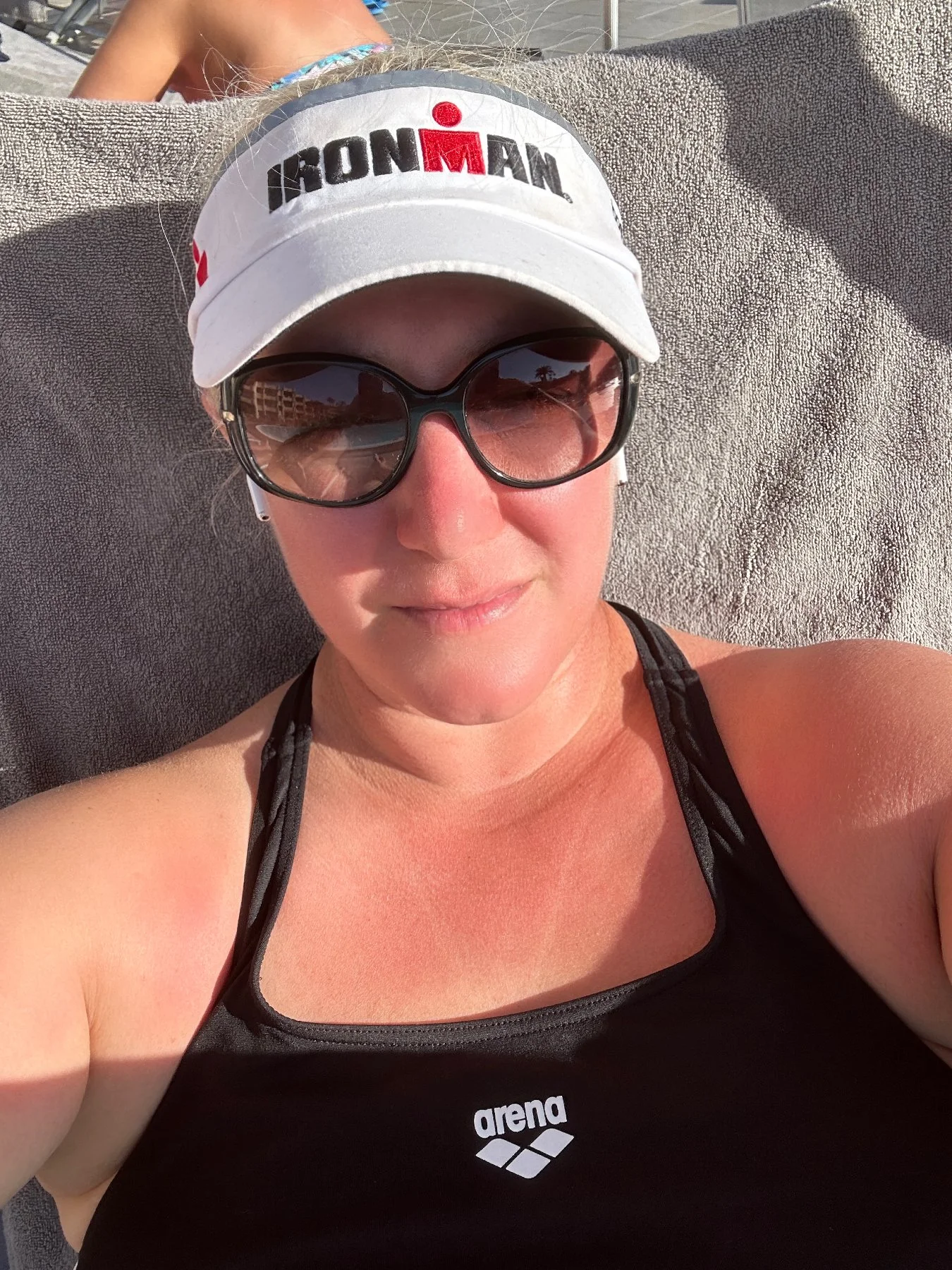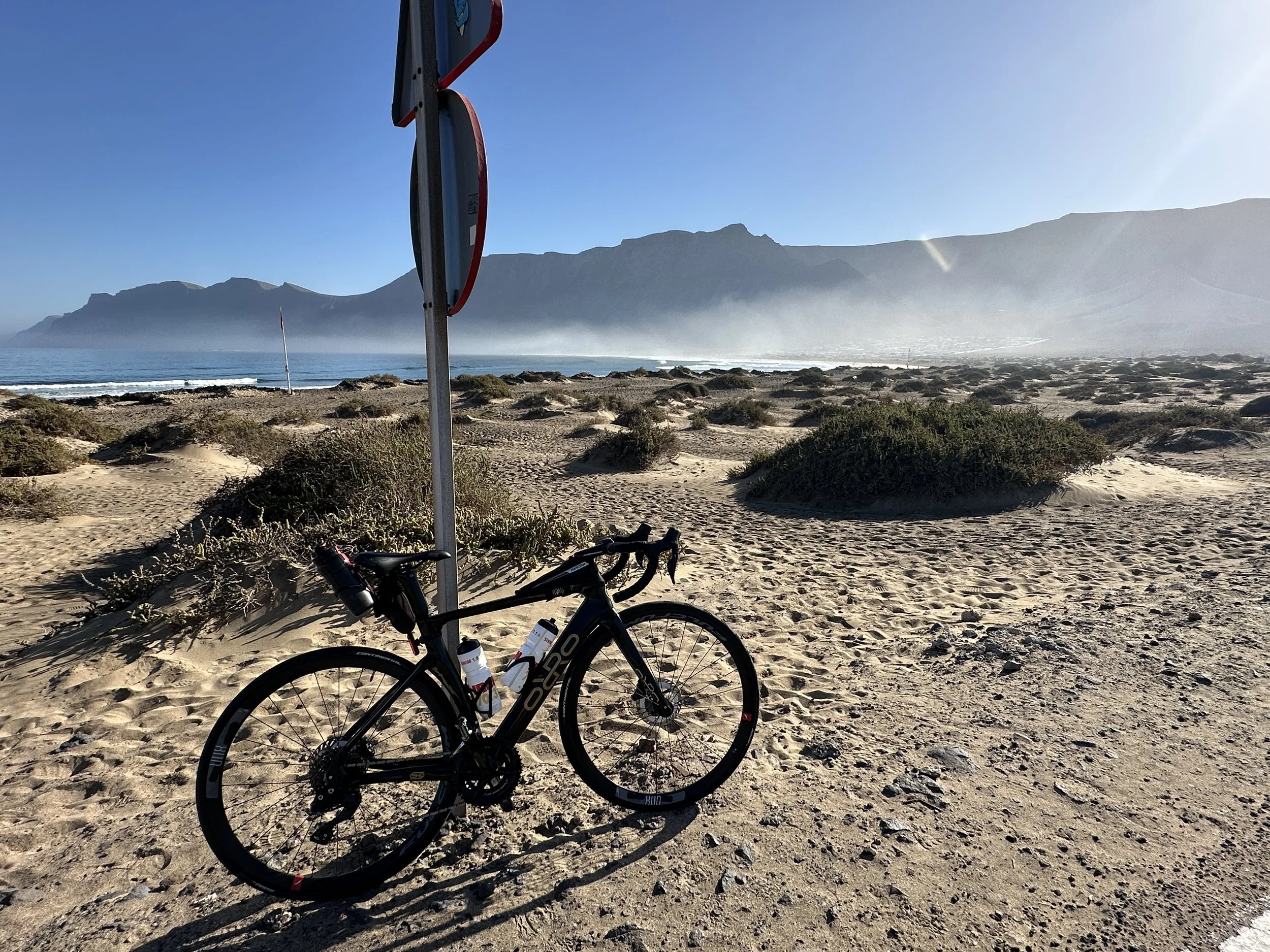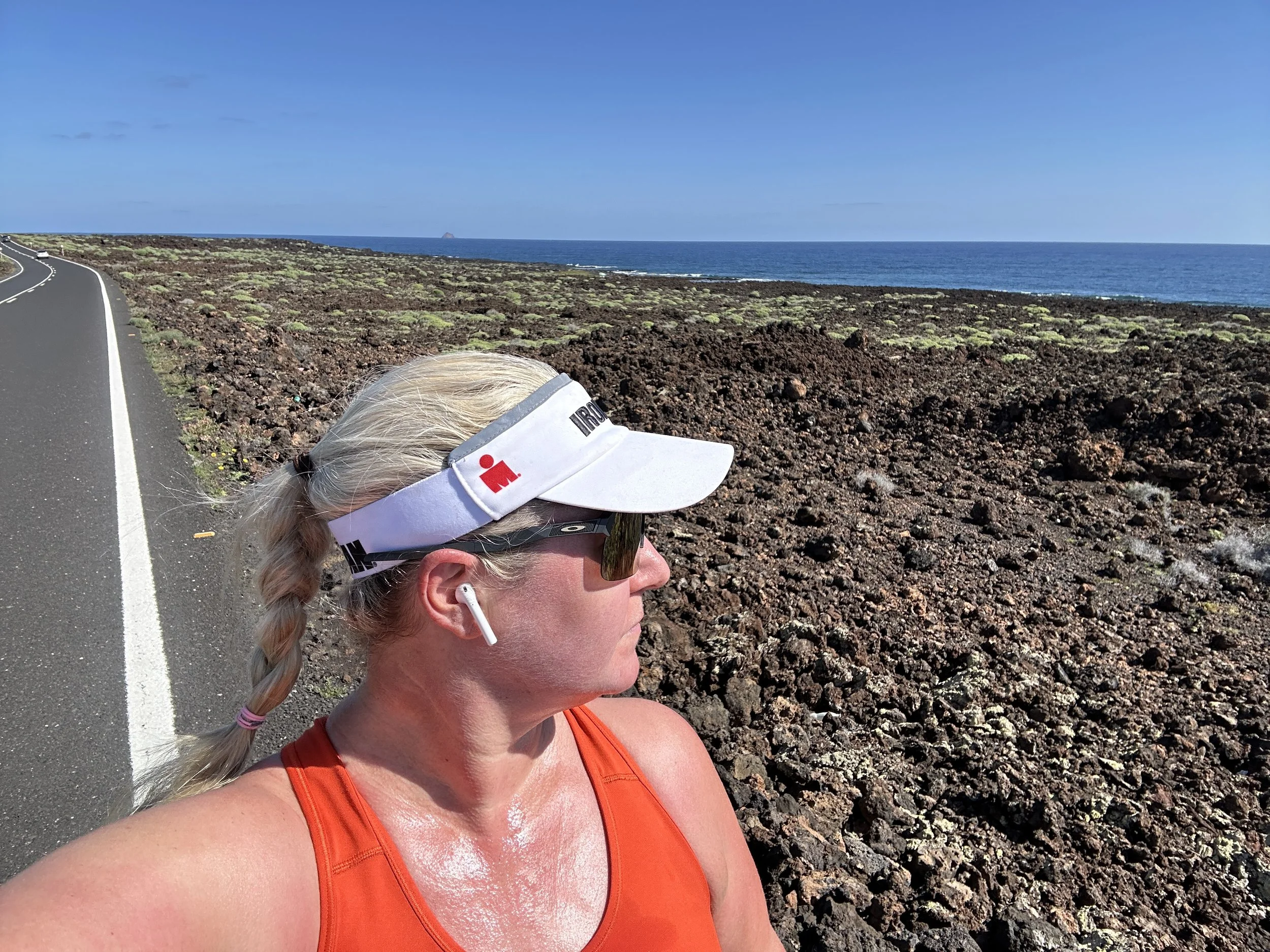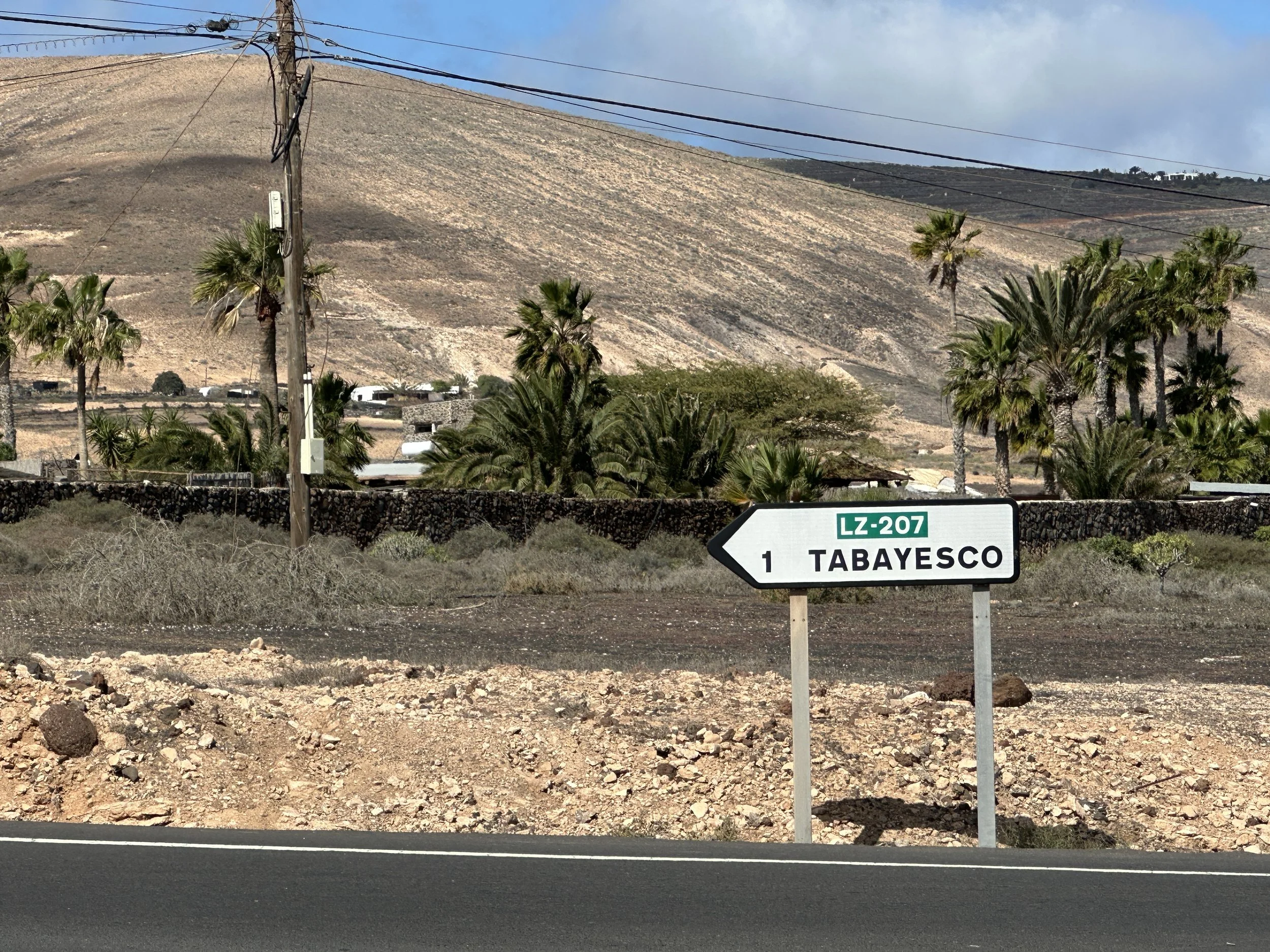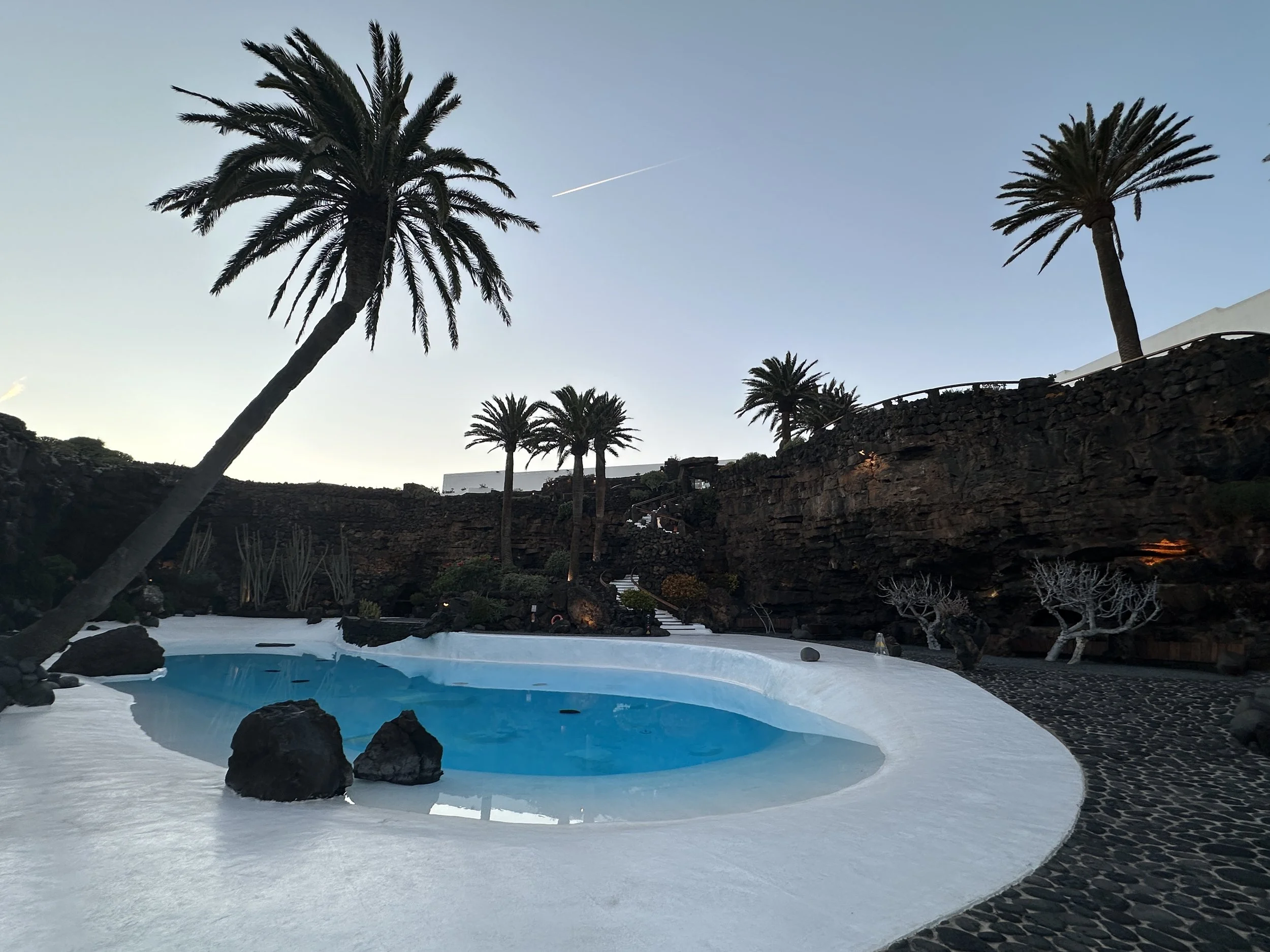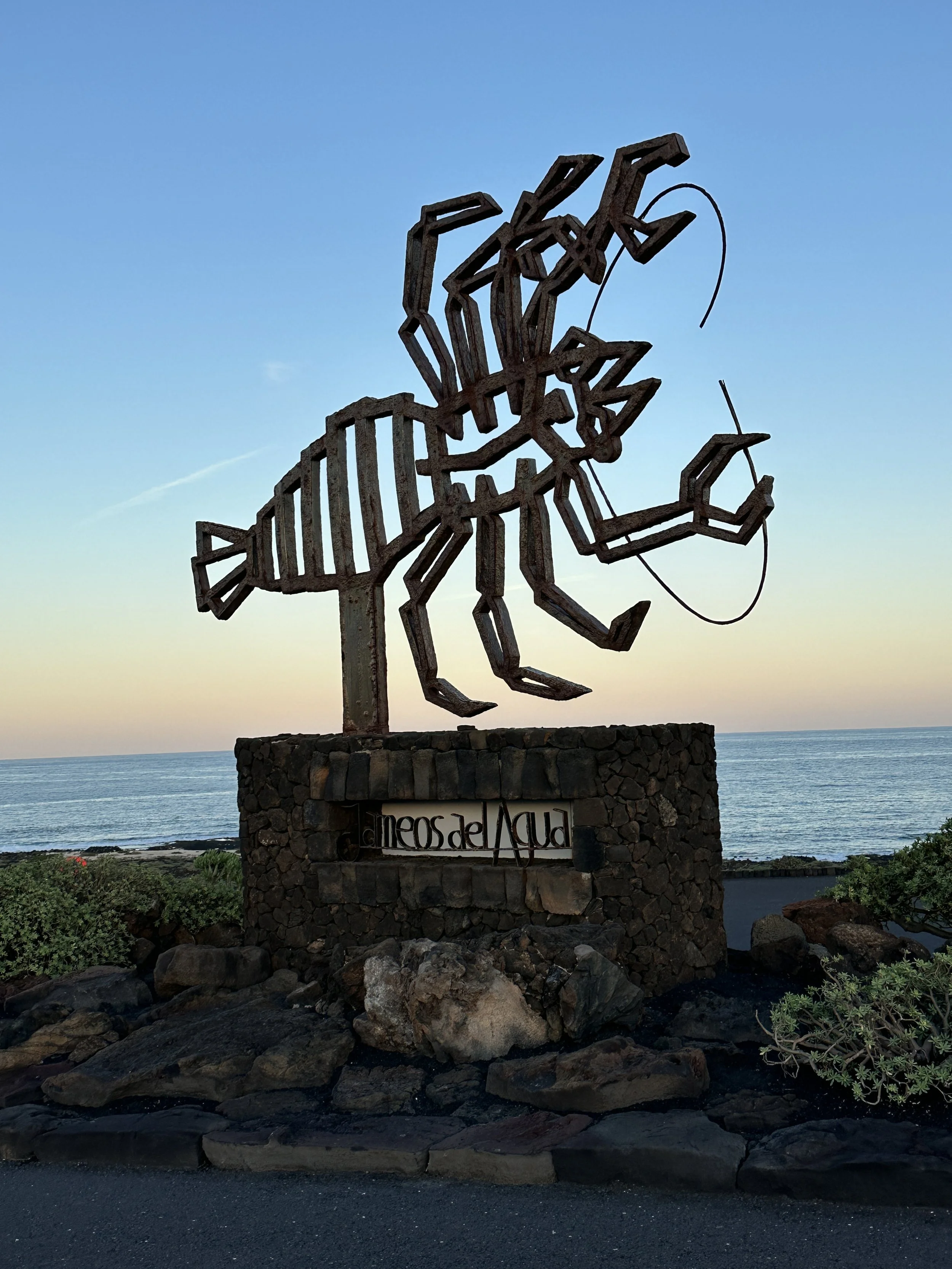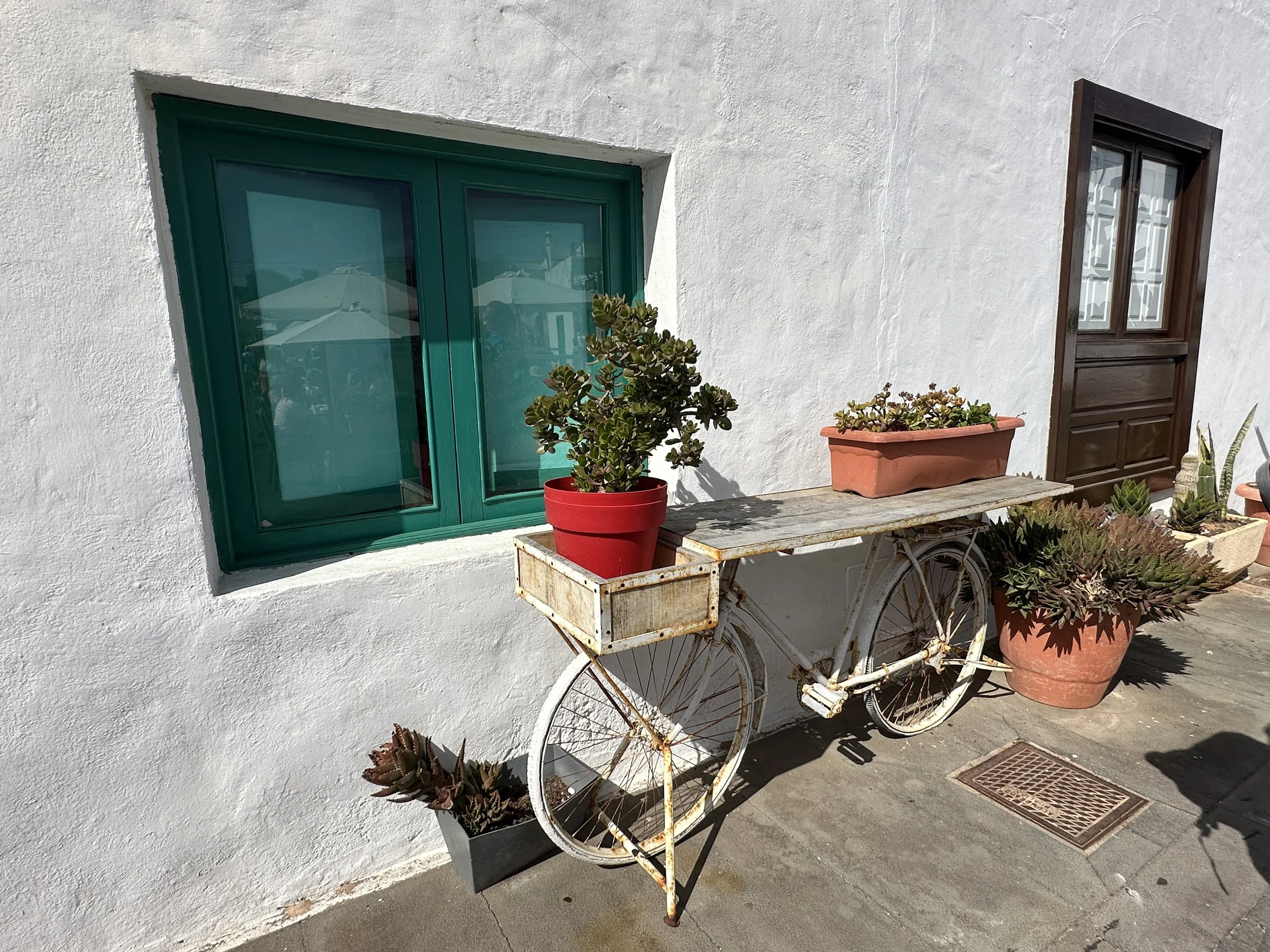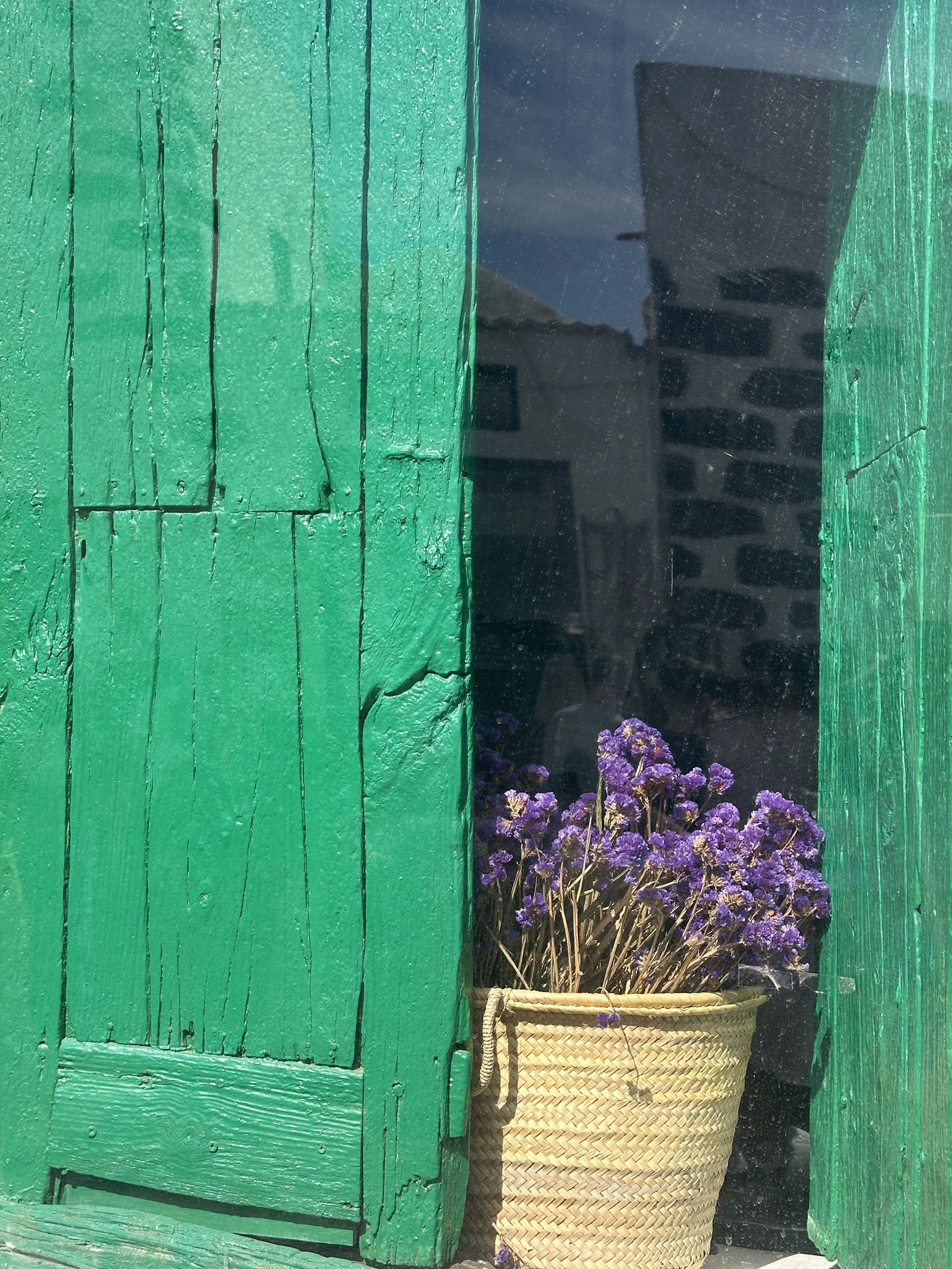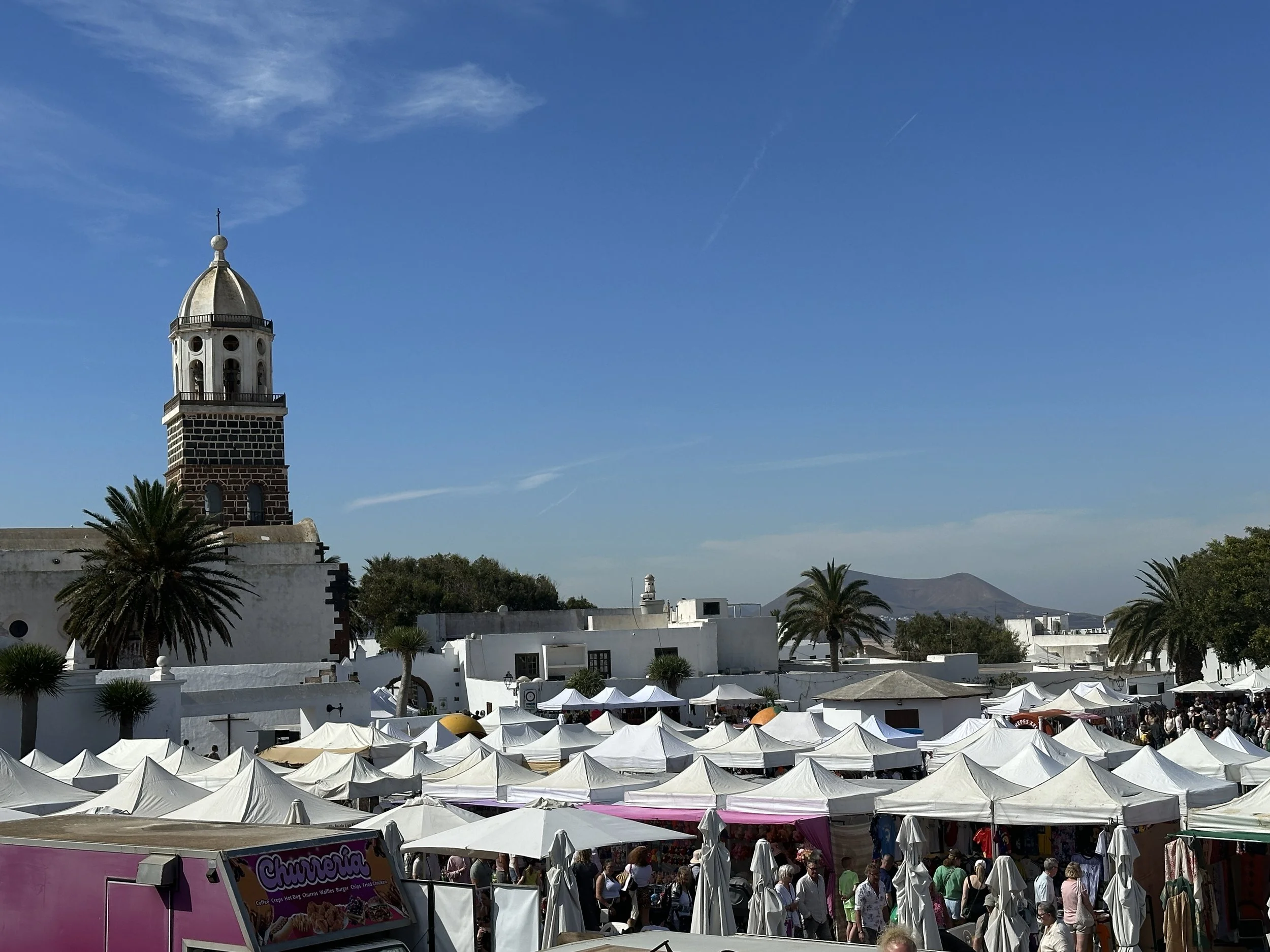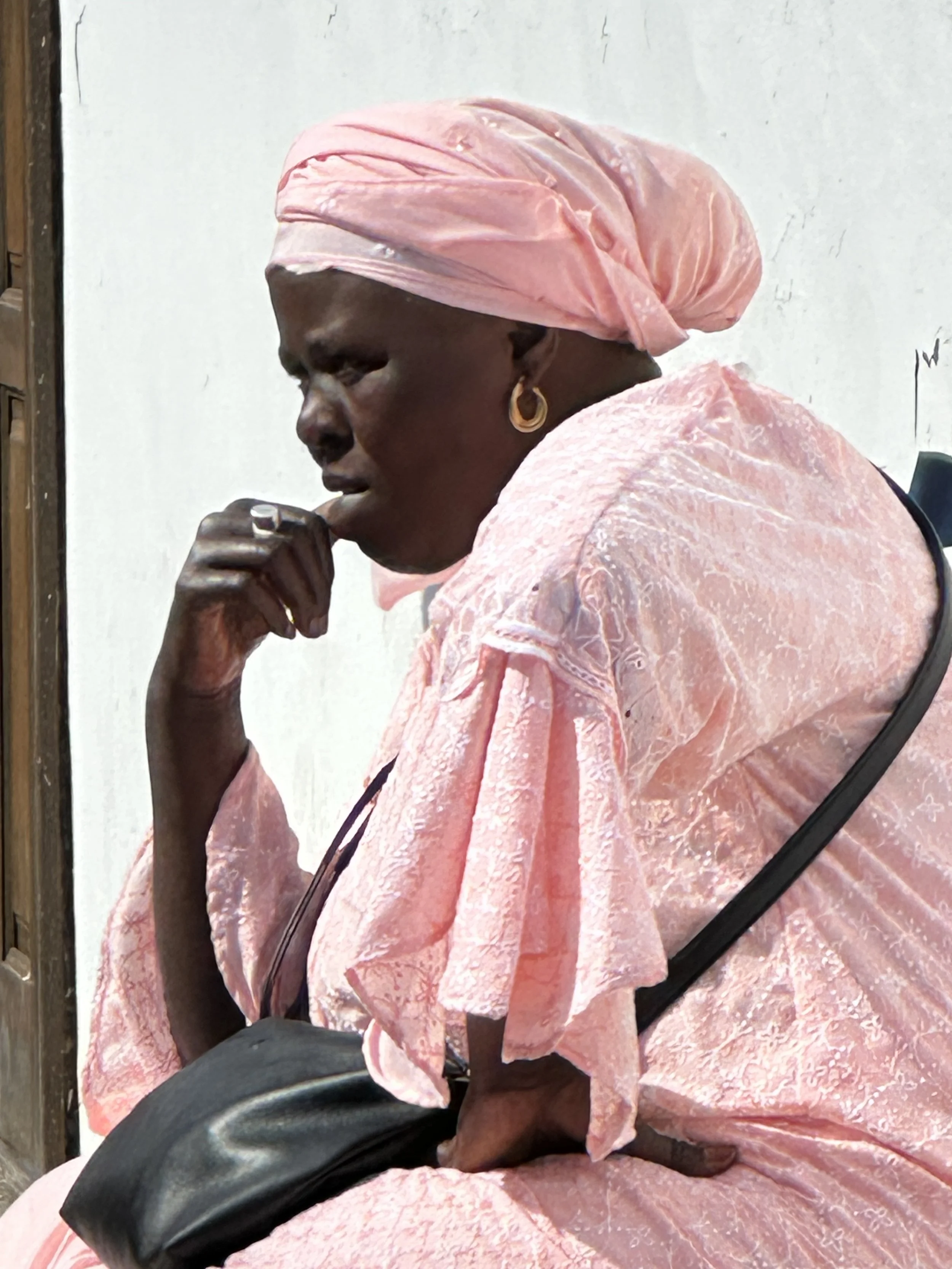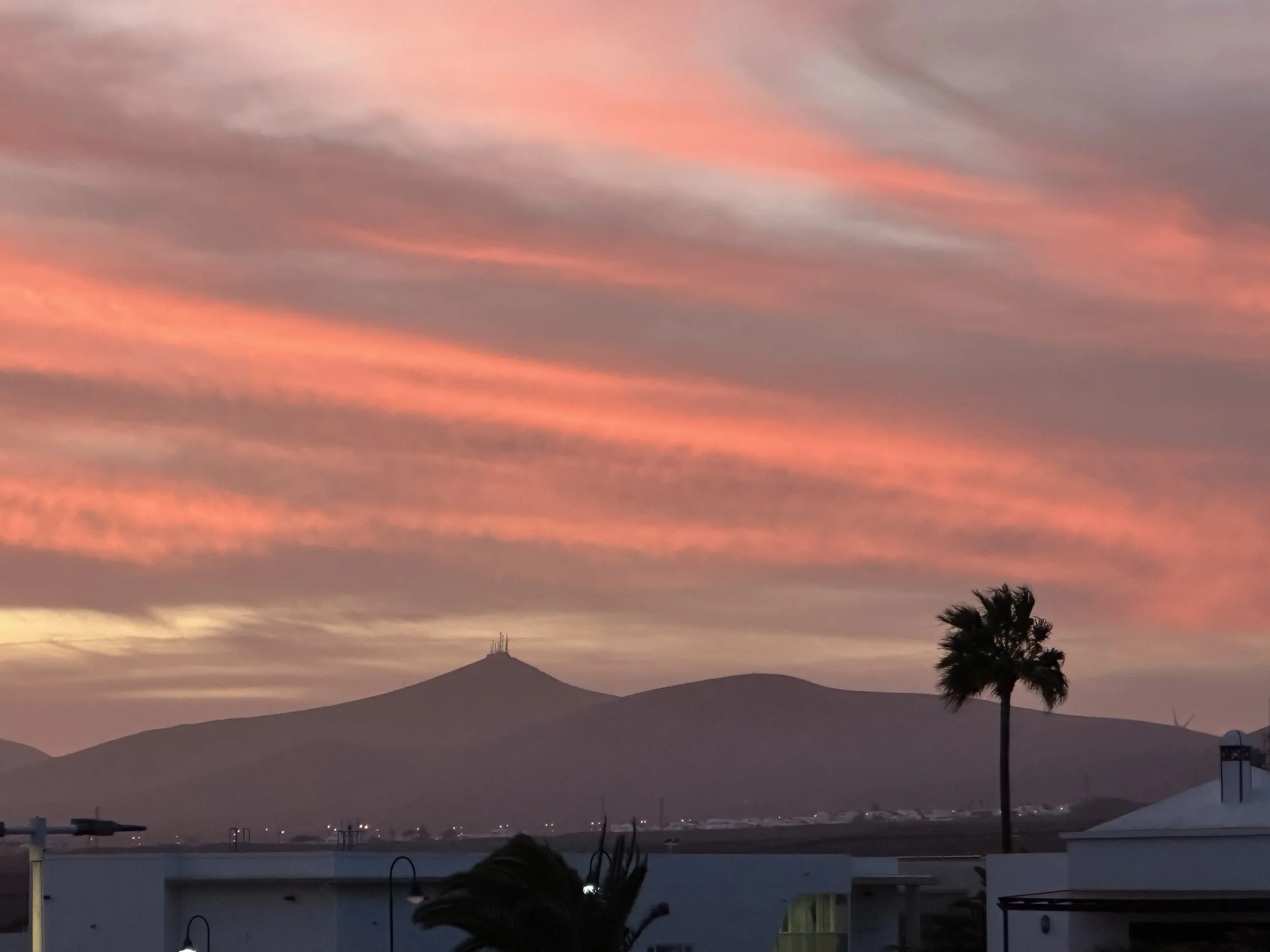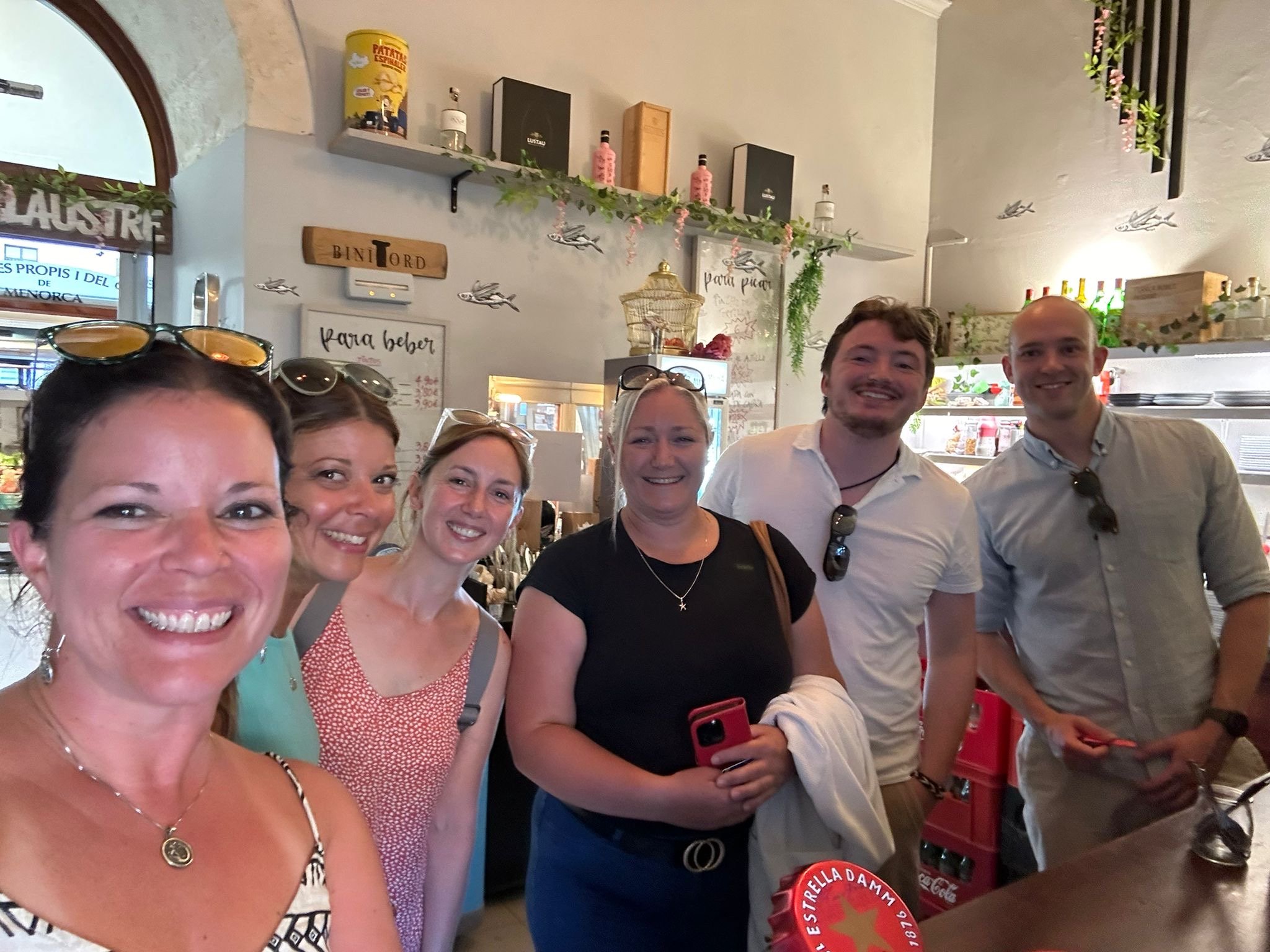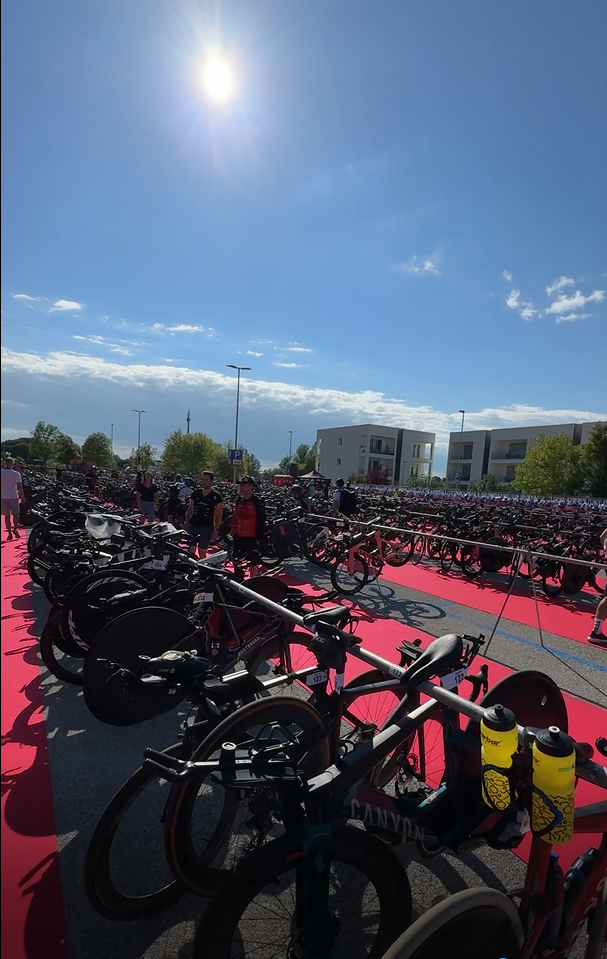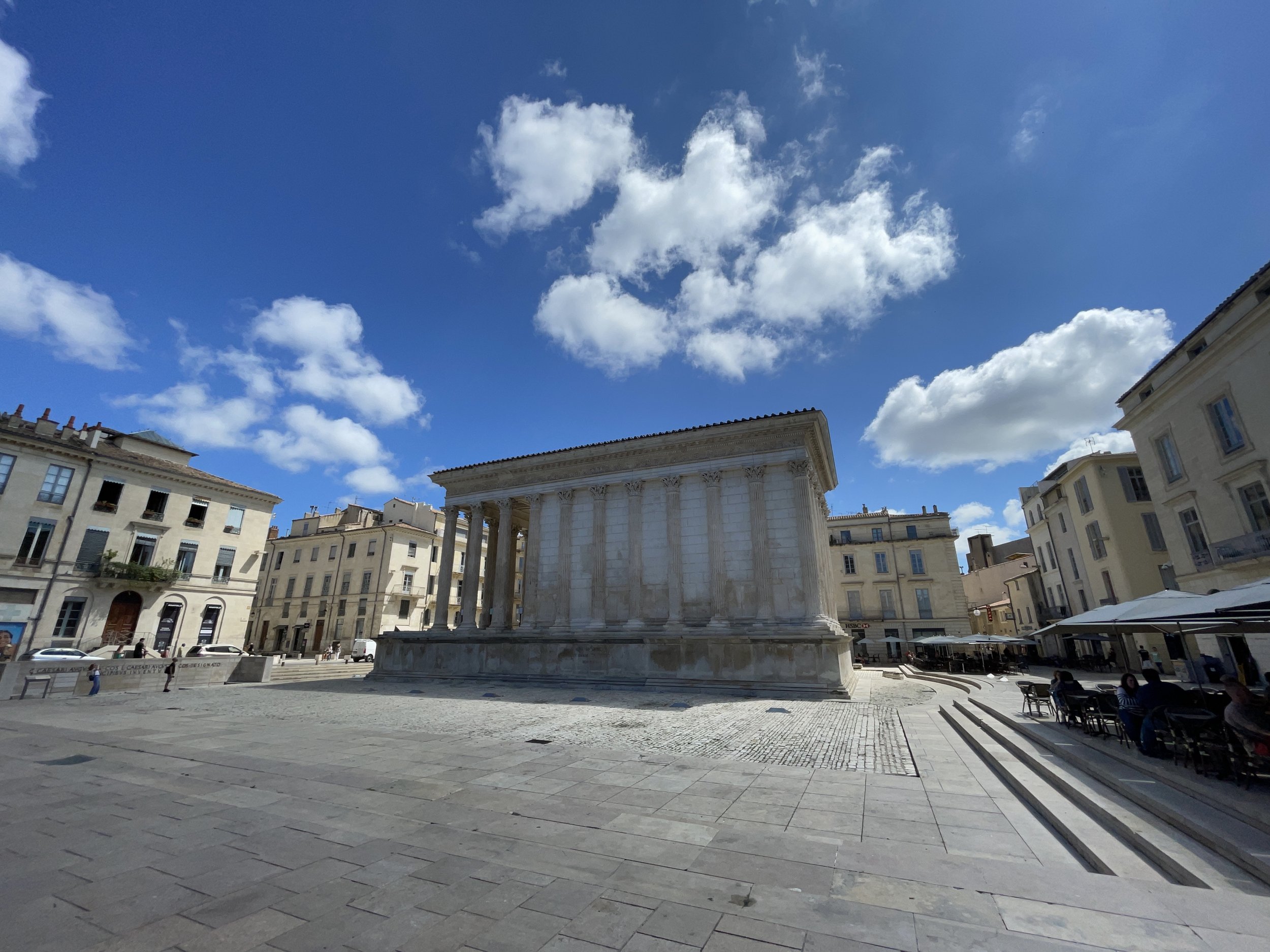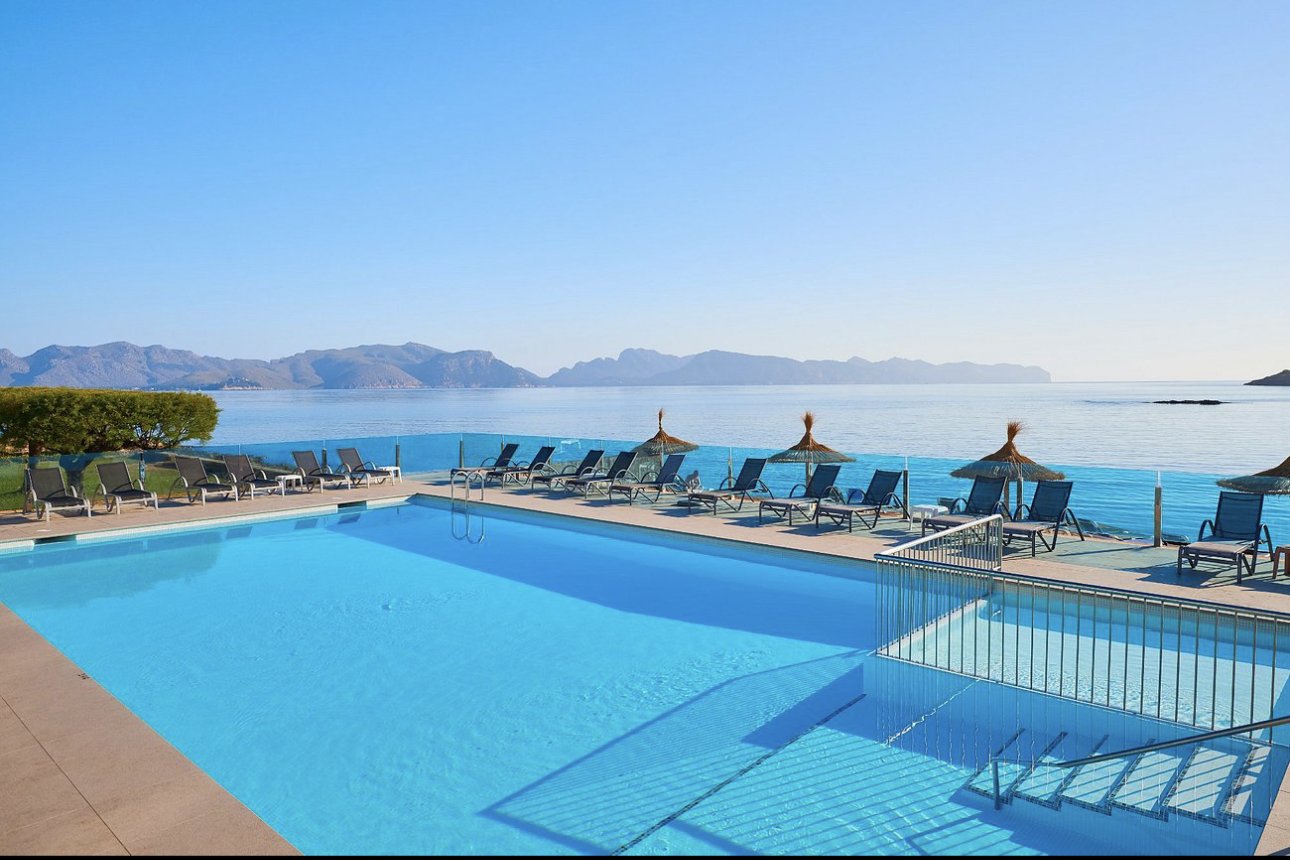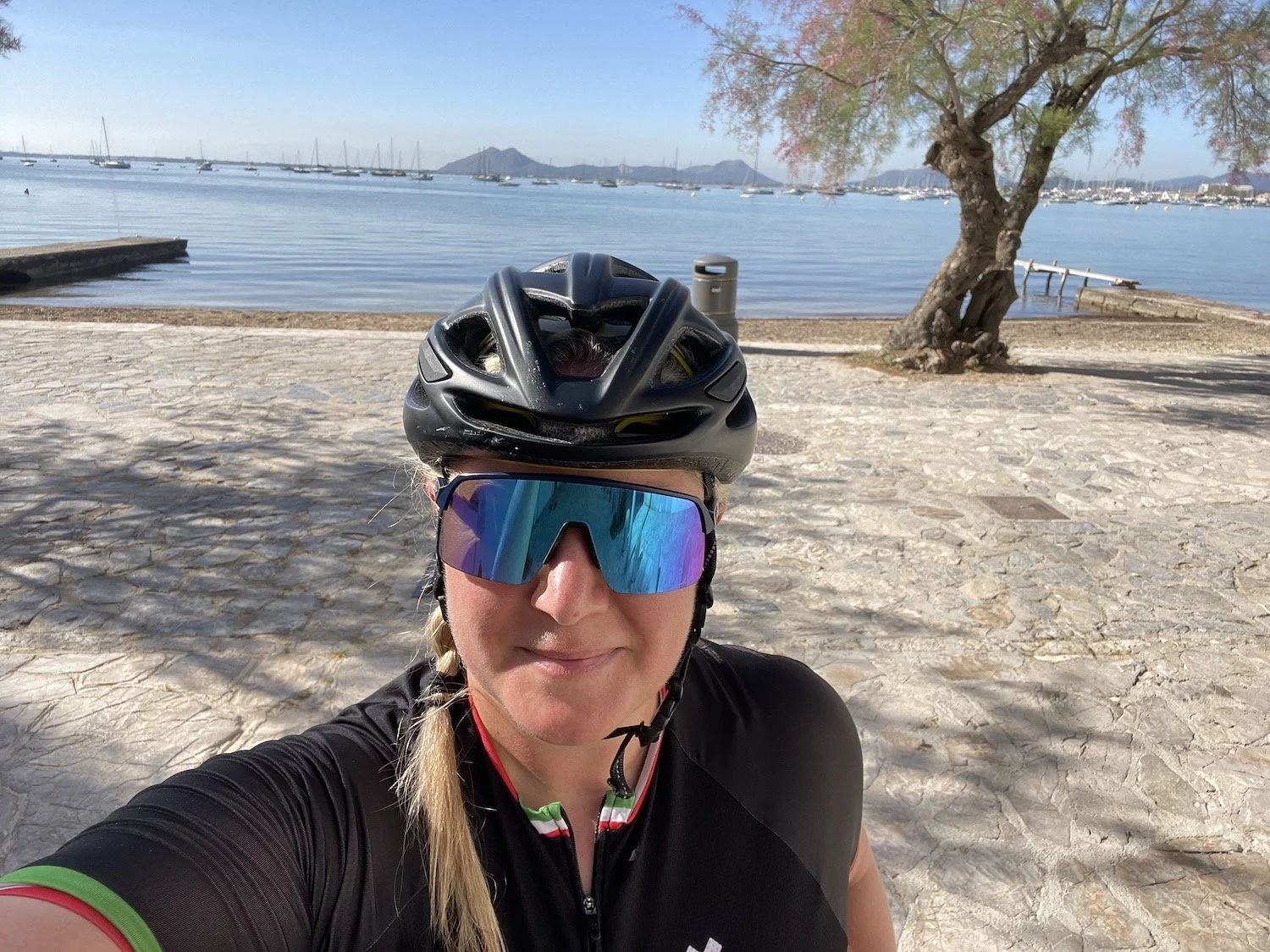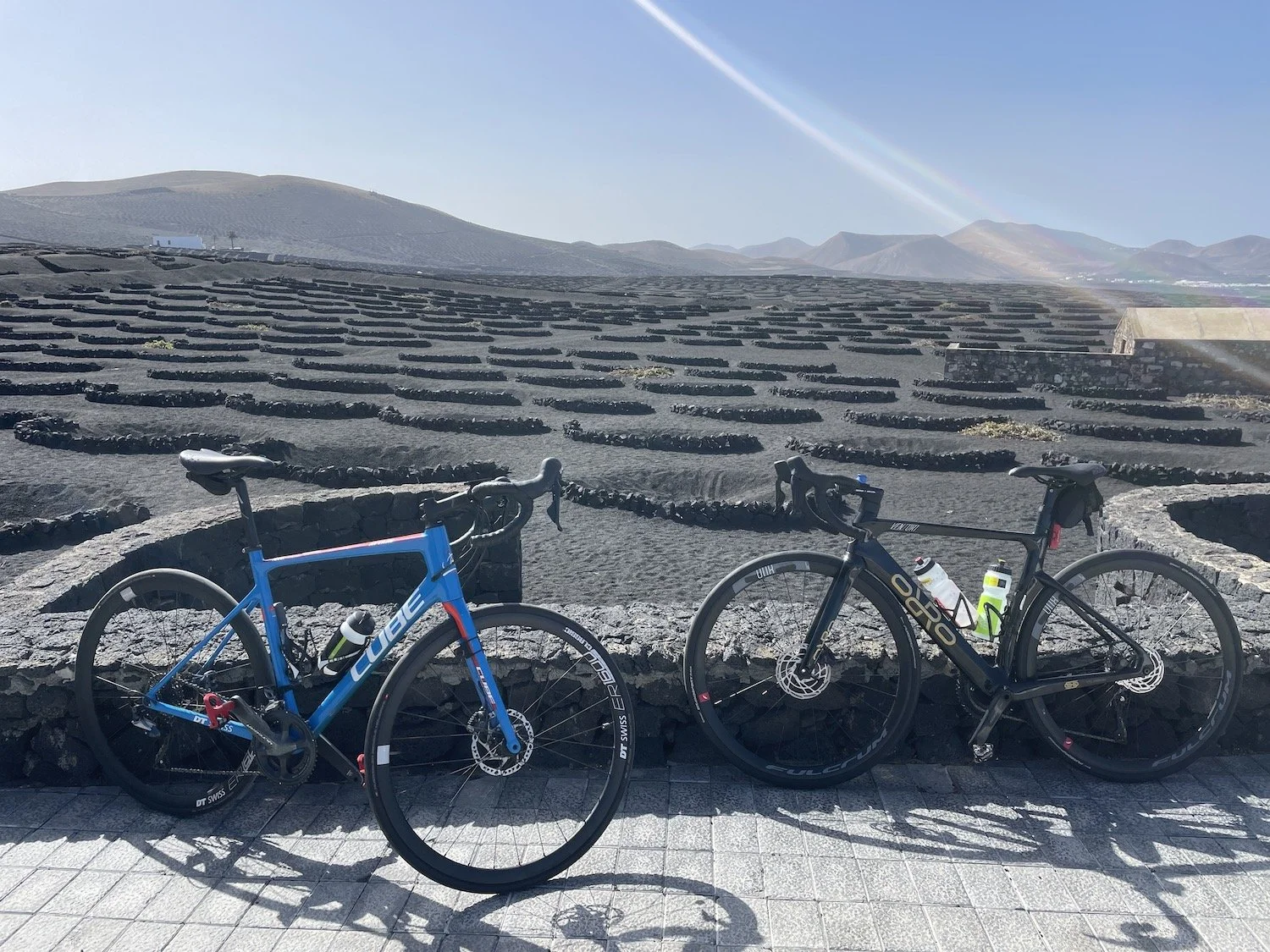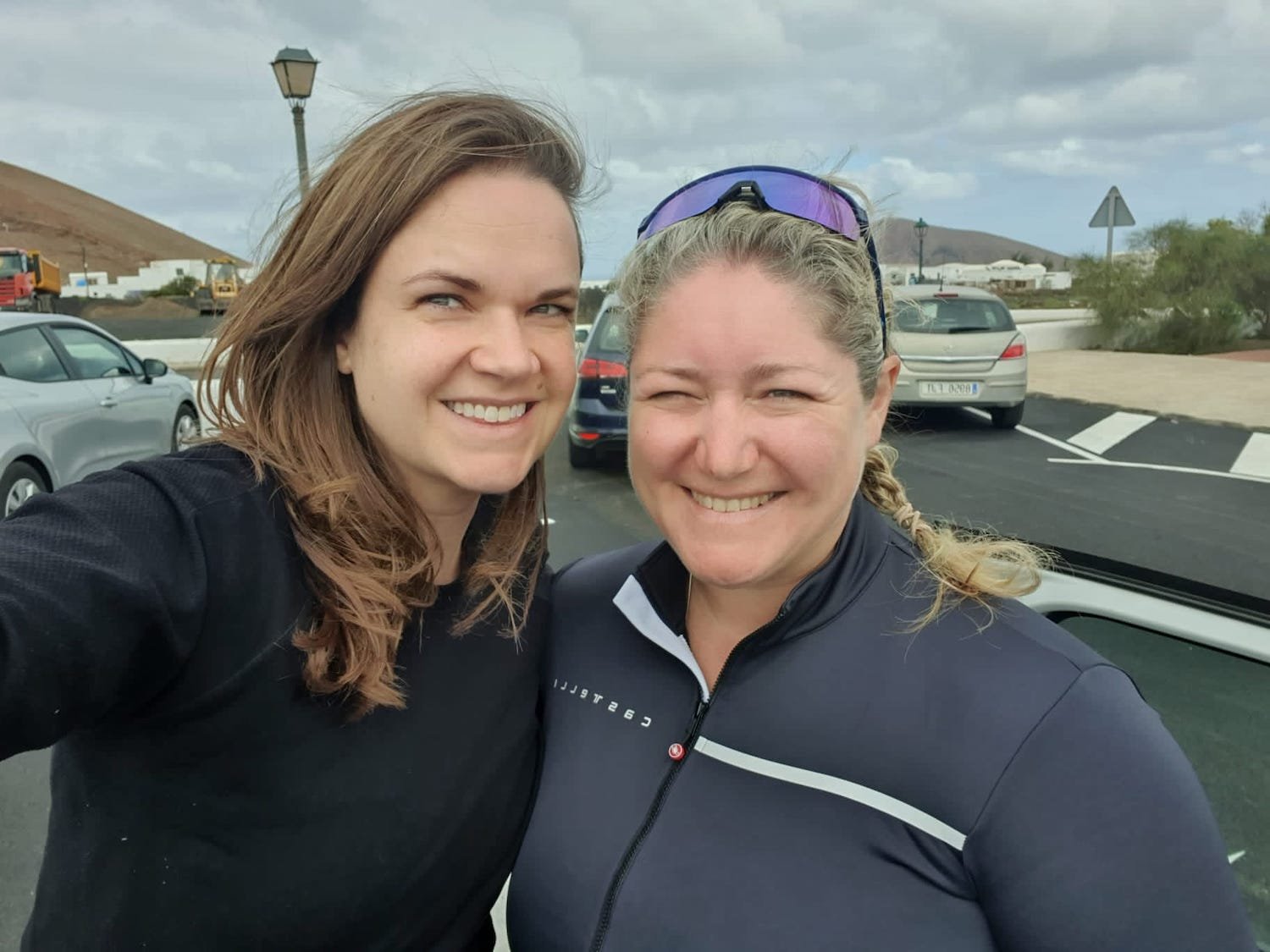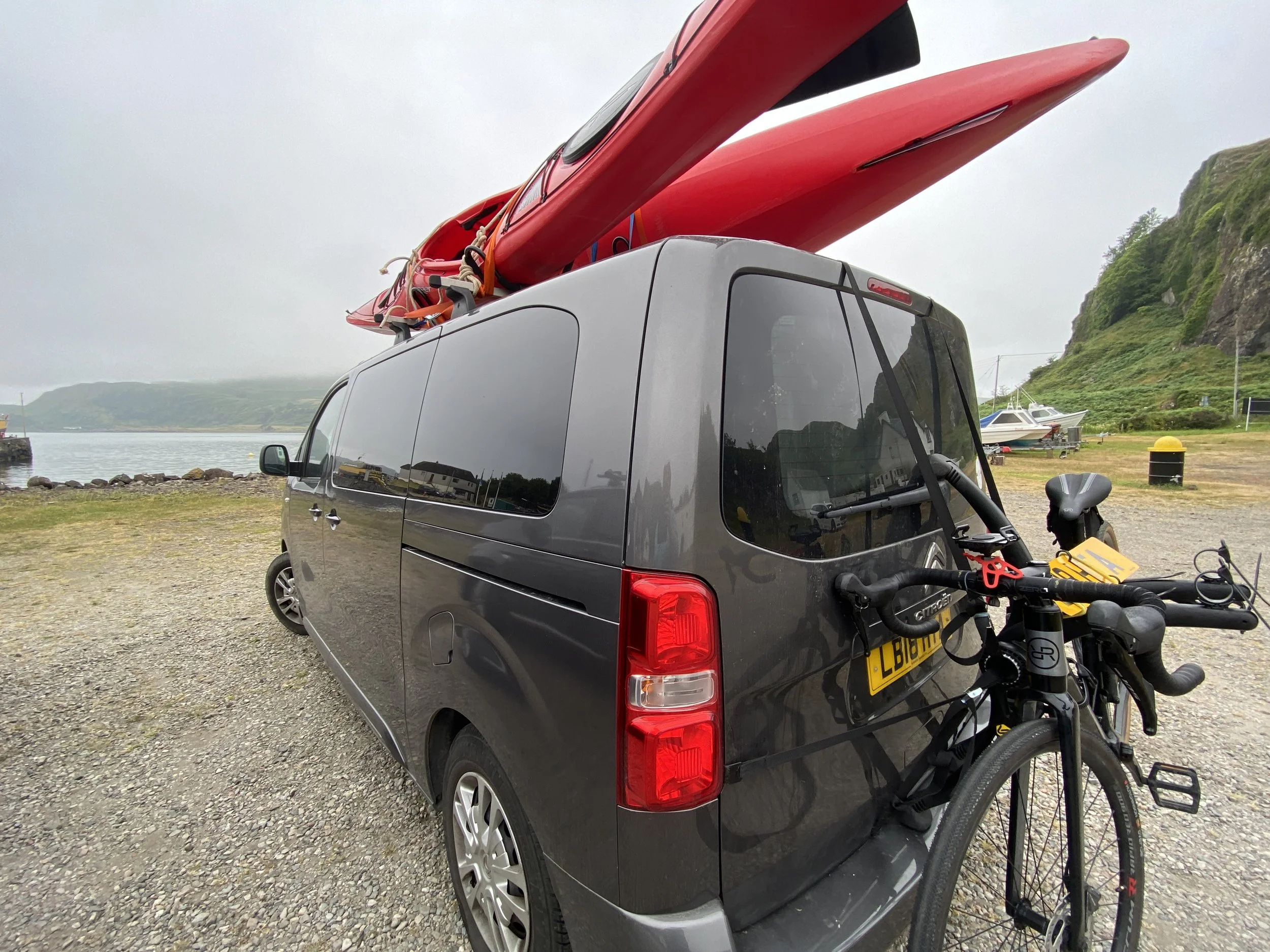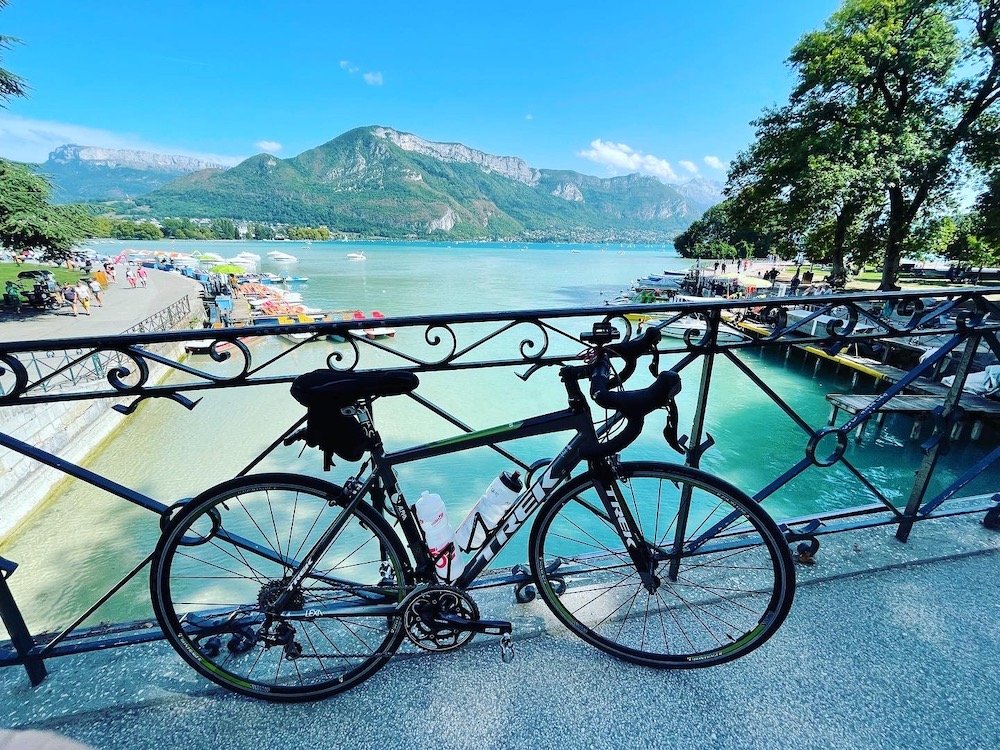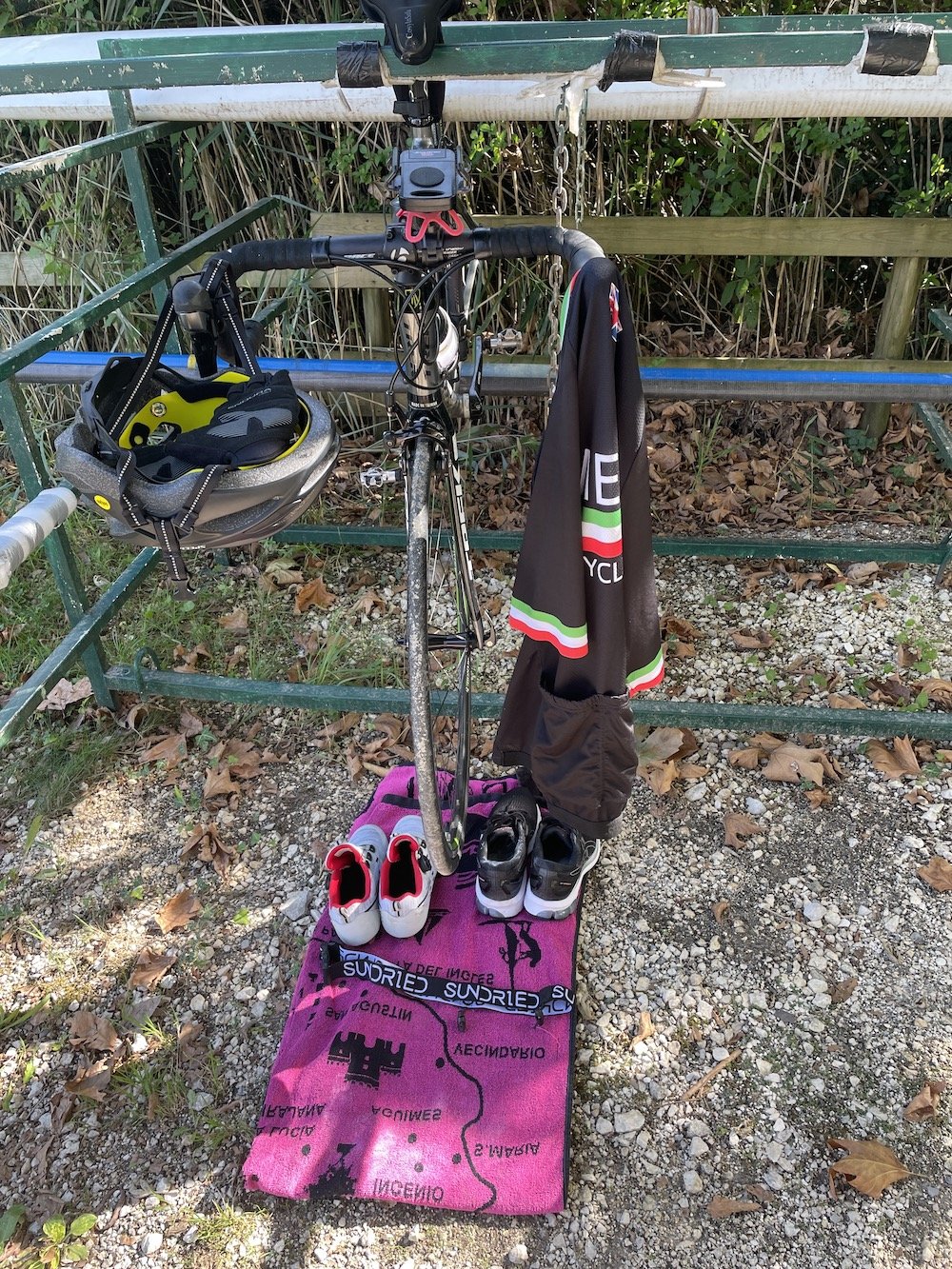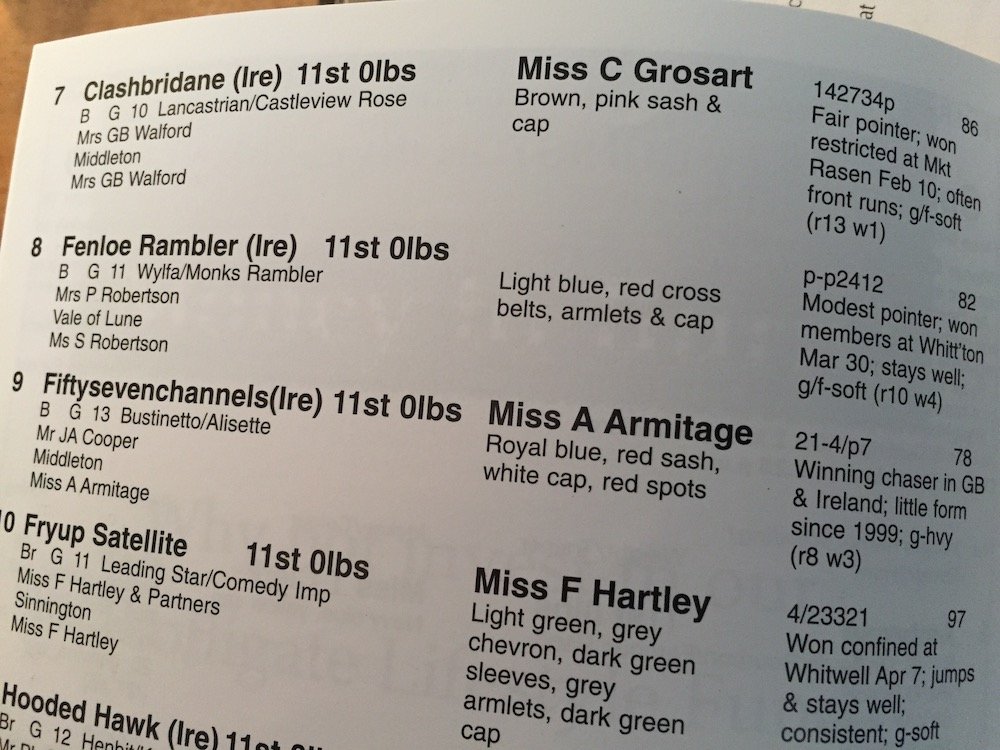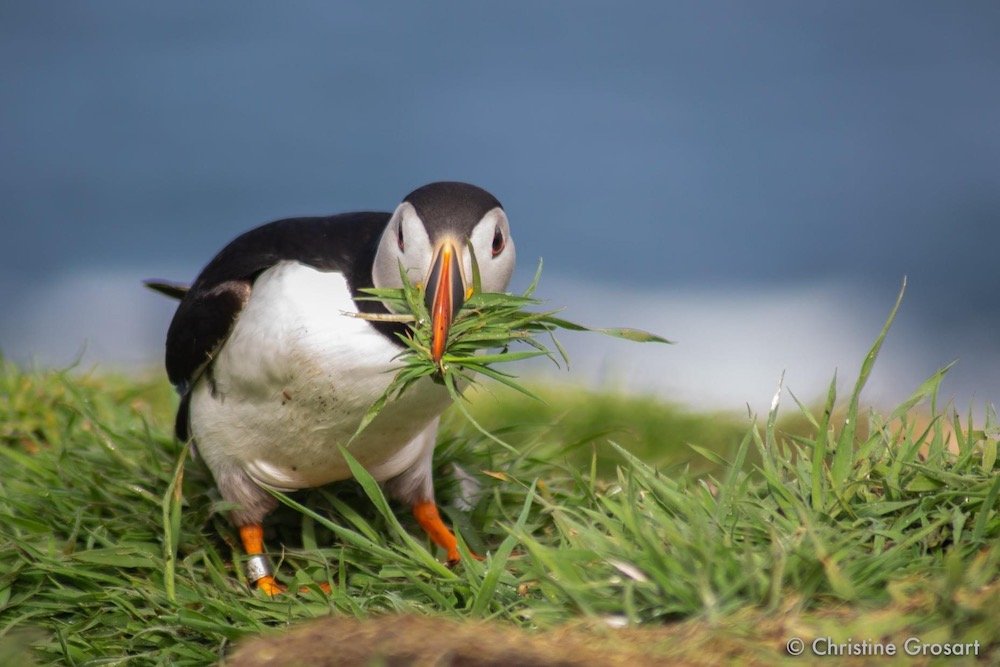Imposter Syndrome
Sunrise Barcelo Lanzarote
Going to Lanzarote for Ironman training is always mixed emotions. I'm usually out there by myself, as nobody seems to have the time, money or the inclination to join me for two weeks training on the volcanic island so early in the year.
I entered two Ironman 70.3 races in 2025. The first being a new one in France, down in the Loire valley in Tours Metropole. This has a river swim and both a flat bike and running course, so I figured this would suit me well.
However, I learned from catching Covid in the days before Ironman Venice that all my training would come to nothing if I didn't have a backup plan. So, on a whim and given that it matched my work rota, I booked Weymouth 70.3 as well.
This one however worried me because the bike course was ‘rolling’ and even though my weight was coming down, it wasn't coming down fast enough to make me competitive on hills on the bike.
In fact, I was seriously concerned that I might not finish and miss all the cut offs. Added to the fact that my swim was desperate after my rotator cuff injury in December, I wasn't leaving myself much room for manoeuvre.
So, off I went to Lanzarote to really kick start my training for the year.
My coach, Russell Carter, sets me a loose training plan depending on the weather and how I'm feeling and availability of the pool etc.
I generally choose to stay at the Barcelo hotel, as it has a 50-metre outdoor pool, it is all inclusive, so I don't have to think about where the next meal is coming from and it has easy access onto the best bike routes on Lanzarote. It is also close enough to the sea for decent sea swim.
La Santa, on the northern part of the island, is the classic training ground for the professionals. An increasing number of athletes now use the Barcelo. It's cheaper and less restrictive over which activities you can choose you don't have to subscribe to any kind of system.
Even so, a 10-day trip at the Barcelo is not cheap, so I have to make the best of every moment there.
The first job is to pick up the hire car, shoehorn my bike bag into the boot and get to the hotel to get the bike built. This usually involves a bit of faff as my hydraulic brake system often has bubbles in it following the flight.
I always get a bit of impostor syndrome when I wheel out my bike for the first time out the front of the hotel, which is riddled with triathletes who are all faster and thinner than I am.
The first time I went to Lanzarote was when I was brand new to using clipless pedals and I sat outside the front of the foyer pretending to be on my phone, until everybody who looked remotely like a cyclist had disappeared. There was no way I was going to have a clip-in fail in front of the semi-professional triathletes!
Several years on, I still get a notion of anxiety and wonder if I deserve to be there or if I fit in with these people. The good news is, I'm not on holiday with these people. Besides, since I had now completed an Ironman 70.3, I had earned my place there. After all I have a coach and everything!
The best way to shake off imposter syndrome I have found is to ‘just do you’. These other people do not matter, they don’t know me and the only person of concern is my coach – and me I guess. It’s hard and takes some practise, but life feels much calmer when you stop comparing. If you want to feel shit about yourself, at least wait until race day results before you do!
I usually have a shortish shakedown ride to test out the bike, tri bars and to get used to riding again in the wind and the heat.
Next, I ventured to the 50-metre pool. It was extremely busy and really intimidating, not least because my left arm wasn't really working. I could just about manage to get to the end of the 50 metres doing a very slow and deliberate crawl. But I knew whatever my injury was, this was too soon. I couldn't even hold a basic yoga move or keep my left arm out to my side by itself. Warrior II pose was more of a dying swan.
Swimming would just have to wait. I concentrated on my cycling and running, all the while trying to ignore my shoulder.
14km run
One thing on my list that I'd yet to try was the classic climb up Tabayesco. I've reached the observatory from the other side of the island but never the classic climb from the East Coast. It was fairly shallow but prolonged and I thoroughly enjoyed it.
As I neared the top with the cafe almost in sight, I caught up with the lady who had been dropped by her cycling group and was now walking the final section, pushing her bike, in tears.
I knew exactly how she felt and I reduced my cadence, trying really hard not to catch up with her and pass her, as I know from experience that this would have completely destroyed her.
She reached the top, where a member of her group was waiting for her. She looked absolutely finished so I pulled up behind her and gave her a big hug and a ‘well done ma’am’.
She burst into tears again, trembling with exhaustion. It looked to me that she was on the same journey that I had been on, and I was only too happy to pay forward some kindness.
The section of coastal road, just southeast of Órzola, is one of My most favourite parts of Lanzarote. To one side you have the azure ocean, only separated from the road by the crumbles of lava. On the other side, a huge lava field truncated by the odd volcano. The road passes by Jameos del Agua, which I visited on this occasion. I was spoiled with a fantastic five course meal and ended up having to get a taxi home because the waiters seemed to have a never-ending supply of wine.
The evening was finished off with some traditional life Spanish music in the acoustics of the huge lava tube chamber.
Despite my malfunctioning shoulder, I hit an awful lot of personal records on the bike and even managed my fastest 10 kilometre run to date. But swimming was still painfully slow and it was still a mystery as to what I had actually done.
The crash.
I lay crumpled on the tarmac, waiting for the inevitable flood of pain to come over me.
My bike lay some 20 metres or so further down the road, having carried on under its own steam.
As I hit the ground, I heard a rib crack and thought to myself “Don’t worry, just a rib...they don’t take too long…could have been worse…”.
My head and neck was fine as I tucked and rolled, just how I had learned on racehorses. But I had never come off on unforgiving tarmac before.
It really hurt. I didn’t bounce or slide. Just bang, smack, straight into the middle of the road.
I couldn’t move.
I looked frantically round behind me. I was relieved that I wasn’t on a sharp bend and just prayed that anyone coming along behind me could see me in time and wouldn’t finish me off.
---------------
I wasn’t entirely sure how to follow 2024….but on 15th December I made sure that I wouldn’t be able to.
Last year was a whirlwind of training camps in Lanzarote, Mallorca and France. I did my first Ironman triathlon in Venice, then an Olympic distance triathlon in Annecy. I went paragliding, climbed Sa Calobra and Alpe D’Huez, had a week’s kayak camping in Menorca, circumnavigated Portland by kayak, dived with seals on Lundy, saw the Peatbog Faeries live, rode in a velodrome for the first time and loved it!
Devastatingly, I lost my beloved Uncle Phil and was heartbroken, but it taught me as if I needed telling, to make the best of every day and make every moment count.
How right I was to do all that because, on 15th December, it all changed.
How it started….
A landrover soon came along with an elderly gentleman who got out to see if I was Ok. He didn’t say much and didn’t really know what to do. I told him not to try and get me up as I was still very much winded but nodded in the direction of my bike. He walked over to pick up Orro and place it on the side of the road.
He stood over me not really knowing what to say or do. It really sucks being a Paramedic on the wrong side of needing help.
Soon afterwards, a car coming the other way slowed down and stopped. A couple got out of the car. Their names were Mike and Andrea. They had been Christmas shopping and their car boot was full of swag. They were both extremely kind and made sure that nobody else ran me over while Andrea tried desperately to get me up off the floor. She managed it and I got myself over to the side of the road.
It was then that my breathing became more and more difficult. I concentrated on making sure I exhaled so that I didn't build up CO2 but I could already feel the panic rising. What the hell had I done?
Sensing that I was no longer in control of my own injury, Mike did absolutely the right thing and called an ambulance. Unfortunately, he didn't have the insight that I did of the ambulance service and the crumbling NHS at wintertime. I already knew there would be no vehicles available and guess what - there weren't. The irony wasn't lost on me. I had spent 20 years as a Frontline Paramedic for the NHS and when I needed them for once in my life, I was left literally on the side of the road struggling for breath.
Mike didn't have space in the car for my bike, so he jogged up and down the road looking for somewhere to leave it and eventually found a kind lady from a local stable yard who said she would take it for me and look after it. Something for which I'll be internally grateful. Mike and Andrea then insisted on taking me to hospital themselves.
I sat in the front seat for the short journey to Dorchester hospital trying to make light conversation, but all the while struggling for breath and clutching my left arm.
They dropped me at A&E and I was very quickly seen by a Doctor and sent for an X-ray. I didn't know who to call, but it made sense to call my coach Russell Carter, as he knew I was practising on the Weymouth Ironman bike course and would soon be wondering why I hadn't finished.
How it ended…
I had two Ironman races in my sights this year; one in France, a lovely flat course in the Loire valley. The other was in my home country, just down the road in Weymouth, Dorset. This one was worrying me as the bike was a so-called ‘rolling’ course. Weight is a huge disadvantage when it comes to climbing on a bike and I was still heavy, so even making the cut-offs would be a huge challenge. But it was one that I was determined to meet.
In preparation, I decided to go out on the course and practise it to see how long it would take me. Riding on British roads in the winter is always a risk. I wasn't speeding. I wasn't going fast at all, but fast enough for it to do some serious damage when I clipped some mud at the side of the road and went hurtling down the tarmac.
Russell was far more organized than I was. Straight away he told me to call Dave Brock. He is the secretary of the Cave Diving Group. He lives in Dorchester and Russell was in no doubt that he would help me. I rang Dave somewhat incoherently and, being a cyclist himself, he didn't really need me to finish my sentence. “Get your X-ray, tell me where your bike is, I'll go and get your bike and then I'll come and get you”.
Several hours later, I was given a pain patch that fell off; some paracetamol and ibuprofen and was dismissed from the hospital with a broken rib, query punctured lung (they weren’t sure) and nobody checked my arm.
Dave was waiting for me and drove me and my bike back to my car which was parked in Weymouth. Of course, he was concerned about me driving home but I just wanted to get home before I stiffened up and was unable to. My breathing had improved but the biggest problem seemed to be my left arm.
Determined to continue training, I mostly ignored the pain and carried on working through it. I figured with time it would get better by itself and it did gradually improve. The only thing that seemed to aggravate it was swimming.
Several months later the pain on the outside of my humerus wasn't getting any better. I had it X-rayed and it was clear, so then I went for an MRI. This showed quite a significant tear of the supraspinatus tendon, part of the rotator cuff. I mulled over my options, but despite a very slow and gradual improvement, my full range of movement still evaded me. I became extremely picky about the activities I undertook and was very cautious about sticking my neck out too far. Cycling and running seemed to be fine but swimming was painful and I didn't trust my arm enough to do any significant caving trips. In fact, I only managed one very small trip surrounded by friends who could help.
I had to accept the fact that at some point I would need to have this tendon surgically repaired - something I dreaded and was actually terrified of.
As I write this in September 2025, my left arm is in a sling five days post surgery, which went really well. It will be a long road to recovery but with the hope that I will get full movement back in my arm, or at least, the best part of it.
While waiting for surgery, along with all the pitfalls that come with arranging dates around my work, I made the best of my summer despite the limited movement in my arm. Many people would have had me sit on the sofa doing nothing all year, but as you would have gathered by now, that is just not me. I'm not here to sit there and do nothing. People who would have me do that are not my friends. What friends wish me to be miserable?
So, I dug deep and made the best of it.
2024 Mash Up
2024 left me gobsmacked. So many things I’ve always wanted to do, a bucket list of joy and so devastatingly interrupted by the passing of my Uncle Phil. I needed sport more than ever to keep me going.
Sitting around doing nothing is not a good way to recover from loss.
Not for me, anyway.
I trained in #lanzarote and #mallorca , climbed #sacalobra (again) completed my first #ironman 70.3 in Venice (when sick!) raced #annecy #triathlon olympic distance, went paragliding over #lakeannecy climbed #alpedhuez for real, learned to fly a drone @djiglobal sea kayaked the length of #menorca camping on sandy beaches with just the best people @muchbetteradventures raced Weymouth 10k, circumnavigated #portland by kayak with @channeleventsuk and saw a dolphin, learned to roll my kayak (work in progress) Dived with #lundy seals and bought some shares in racehorses!! I don’t think I’ve been caving or cave diving once, but there is more to life and I’ll get back to it when the mood takes me.
People keep trying to get me to slow down. Why would you do that? I like my life how it is. Why would I want to slow down? Life is too short, so make the best of it now. It’s not a dress rehearsal....
The beach
Paddling the south coast of Menorca. Image: Karetta Expeditions.
I love sea kayaking.
I really only got into paddle sport properly when I was persuaded to race the Devizes Westminster marathon in 2009. I trained solid for 2 years in a racing K2, burning up the canals and waterways of Dorset and Wiltshire. We were finishing mid division in the warmup races and doing really well. Then disaster struck. 4 weeks before the race I suffered a herniated disc in my back, which rendered me unable to walk, or even sit in a car. It was almost career ending. I sold all my kayaks (I had 5 in my garden at one point!) and vowed never to set foot in one ever again.
Racing K2 in 2008
Time passes and after almost a decade, my back started to heal. I was still nervous of it but missed being in a kayak.
I didn’t think I could ever cope with a tippy racing boat again, but during covid I needed a new passion to get into the outdoors. I watched a video on social media of a friend of mine and his wife, paddling in Scotland with crystal waters and surrounded by peace and serenity.
The beauty of sea kayaking is that it is not competitive, so you can take it at your own pace and as much or as little as you choose. I figured if my back wasn’t feeling it, I just wouldn’t need to go. I bought 2 second hand, barely used Dagger Stratos kayaks for little over £1000 and have had nothing but fun and adventures with them ever since.
I’ve paddled in Dorset, Cornwall and the Outer Hebrides – but never anywhere particularly warm
Circumnavigating Mull, Scotland, in my Dagger Stratos.
I kept seeing adverts popping up on social media for ‘Much Better Adventures’. I generally ignored them. I was quite capable of organising and running my own kayaking adventures and was loathe to use a guide.
The thing is, I very often end up going alone. I bought two sea kayaks so I could take my friends out, but they lacked the time to progress their skills and experience, so I couldn’t take them very far.
My mates just don’t have the spare time, cash or freedom to just drop everything, up sticks when the weather comes good and set off to any corner of the UK for an adventure.
With no ties and 6 months of the year off, I could do this. But inevitably it means it is a solo venture.
I missed company of like-minded people. So, I signed up for a 4-day camping and kayaking trip in Menorca. It promised a leisurely few days on the water, camping on sandy beaches, sunsets and excellent guides who make your food and take care of the housekeeping.
It sounded a bit easy compared to the sort of thing I’m used to, but I decided that, given the tough few years I’d had, I’d give myself a break and let someone else take the weight off for a change.
Going on holiday with strangers is not really my cup of tea, but I figured a good guide would keep everyone in check and if anyone annoyed me, I’d just go and get in the sea and swim or paddle away from them.
I need not have had any of these worries at all.
From the outset we created a WhatsApp group and on the first night, having checked into our own hotels, a gang of us met up in Mahon, Menorca, for supper and some wine. We mooched around the bustling market as dusk fell and the vibe was good.
It was a mix of people, some from as far away as America, some with kayaking experience and some with none. It didn’t matter, we’d be well looked after.
In the morning the minibus picked us up and took us to the depot, where we would be given dry bags and set about packing. Travel light and go minimal was the order of the day.
I was seizing the opportunity to try out stuff I hadn’t had the opportunity to until now, such as dry shampoo and seeing of my solar panelled power bank actually worked…
Packing seemed to take ages, and it was well past lunchtime when we finally made our way to the kayaks that were waiting for us at the eastern, southerly end of the island.
There we met our guides Lucas and Jan, who walked everyone through a lengthy explanation of how to paddle a sea kayak. We had decent boats and paddles and loads of storage space, mainly owing to the ginormous double kayak which acted as the ‘hospital’ boat. It also contained lots of food, water and camping equipment and weighed a tonne. It turned out to be a godsend for one lady who was terribly seasick. Once in the more stable boat and plied with a cocktail of drugs, she overcame it and enjoyed the rest of the trip, much to our relief.
We finally got out on the water and very soon we were forced to settle into Menorca time. Nothing was hurried and dinner time wasn’t until around 9:30pm.
We paddled gently for around an hour in glassy, calm conditions before stopping for a late lunch at a busy, sandy beach. We had ample opportunity to lay about, swim, and eat lunch. It was a lesson in slowing down and enjoying the vibe, but it took several of us a day or two to adjust to this new pace of life.
The plan each night was to put our tarpaulins up as dusk fell. The beaches were therefore cleared of people, and we would have them to ourselves.
We arrived at our first overnight stop of the trip, a secluded sandy cove, and set up our tarpaulin wigwams and groundsheets. Thermarests were provided but most of us brought our own sleeping bags.
Sand. It just gets everywhere. There is nothing more irritating than gritty sand in the bottom of your sleeping bag. The humidity overnight added to the issue, to ensure that the sand stuck to everything, and our bags never really dried out throughout the whole trip.
This aside, we were treated to some super starry nights from under our canvas, complete with shooting stars and arguments about whether or not it was Orion.
“That’s Orion, there…”
“No that’s Ursula major. Or is it minor…?”
“That’s the Scorpion isn’t it?”
“No, it’s the saucepan, look there’s the handle”
“I’ll get my app”
“What’s that noise?”
“It’s my app….it plays music when you use it…I can’t turn it off”
“Look, I told you that was Orion…”
“Oh look a shooting star!”
“Make a wish…”
It was like being on a school camp again. And we loved it! We woke early to a cool sunrise. It took some adjustment to realise we were not against any tides or the clock. We could have a leisurely wake up, without being hurried. I did some yoga on the beach at sunrise, which frankly is something you only ever see on Instagram and never do for real!
We were starting to live the dream.
Each day, we made our way along the south coast of Menorca, stopping for long, leisurely lunches with sea swimming, sunny snoozes and bobbing about, chatting in the water. We went snorkelling, I had a chance to practise my self-rescue skills and on the odd occasion we snuck off to a beach bar in the evening, feeling guilty, but not for long, for making the expedition less of an expedition by joining civilisation.
We worked out that we were all on a well-deserved break and opted to make it easy, rather than harder than it needed to be.
I managed to sneak some early morning drone shots of the camp one day and these really did the trip justice. We were treated to warm, clear waters, rocky cliffs, sea caves and pine forests as we made our way along the entire length of Menorca.
The sea state picked up over the last few days, but the gang coped with it really well and nobody took a dunking. We were starting to get the hang of things and eating simply, enjoying the local produce that Lucas fed us from the never-ending Tardis of the giant double kayak.
All too soon it was over. We pulled into a rocky beach with swanky beach bar and emptied the boats, piling kit into Ikea bags ready to be taken back to the depot.
We were all a bit sun burnt, desperate to shower in fresh water and we all took turns to stand under the beach hose pipe to get the salt off our skin.
We all sat and drank cold beers, half pleased to be back to some normality but half sulking that it was over.
We all decided to meet up that evening for one final supper at a pizza place. I grabbed my hire car ready for the rest of my trip, as I was staying on for a few more days on the island. Then we had supper and said our final goodbyes.
I cannot recommend Much Better Adventures and Karetta Expeditions highly enough. On my final day I booked a sea kayak rolling lesson with Lucas and progressed a lot. Karetta were friendly, professional and highly skilled. I’d been a caving instructor myself for 10 years, so was able to see the way things were run from a slightly different angle. I could not fault the guys and wouldn’t hesitate to use them again.
The Alpe
Orro bike part way up Alpe D’Huez, France.
The Alpe
I sat at the dinner table, staring at my small plate of white fish, a little rice and some lettuce. I was too tired to start eating it, pushing around my plate instead.
“That’s a proper fucking climb!” My mate and colleague said, slightly outraged and surprised at what I’d just done.
“I know…” I said, picking at the fish.
“How long did it take you?” he asked.
“Fucking ages!” I replied.
As luck would have it, I was down in Annecy competing in an Olympic distance triathlon and had some time to kill afterwards. Alpe D’huez was only a few hours drive away.
I booked a campsite at Bourg D’Oisans which was conveniently right at the start of the famous climb.
Lake Annecy from the air. Shot on Insta 360 camera.
But, not before I took to the air and went paragliding in Annecy – something I had always wanted to do ever since I started visiting France as an adult in my early twenties.
Wherever you go in the French mountains, you see colourful canopies, dots in the sky, circling the thermals and gently, like leaves falling from a tree, spiralling slowly down to earth to land in some field somewhere.
In my youth I simply couldn’t afford it. Other times, I just ran out of time or couldn’t motivate the people I was with to come with me.
Free of all ties, I booked myself onto a tandem flight. Just 20 minutes, in case I didn’t like it!
View from the best seat in the house. Lake Annecy. Flights by Takamaka.
I rocked up at the flight school and a few of us piled into a minibus, packed out with parachutes and harnesses and our pilots.
We drove up the Col de Forclaz, which is one of the highest points above Lake Annecy. It looked like a half decent cycling climb until the hair pins ramped up to a ridiculous gradient and I thought better if it. We climbed higher and higher.
As we walked to the take-off ramp, the views were spectacular, and the height made you feel a bit dizzy.
My pilot was Mitch and he spoke better English than I did French. He was good looking, smoot and impressed that I worked offshore. We chatted easily and he fitted me out on my harness and helmet. We didn’t faff at all. There was no time to even think, really. I felt a tug of the parachute behind me and we took a few awkward steps back.
Then very quickly, those words again: “Allez allez, go, go, go….”
We ran a few strides then whooomph! We were up in the air very quickly. I wasn’t really ‘in’ my seat, so he quickly showed me how to lift myself into the seat properly and get comfy. He’d kindly allowed me to bring my Insta 360 camera and I started filming the incredible views as we flew up and down the tree line chatting and laughing.
Eventually we crossed the lake and after he’d let me have a go at steering, he was keen to show off his aerobatic skills.
I’m up for pretty much anything and away we went. After three big swoops where my stomach almost fell out, I had to stop. I was the kid who clung to the top of a death slide, hating that ‘dropping’ feeling. I hate roller coasters and theme parks and it’s the reason I won’t do a bungee jump or jump from a plane.
It might have been easier if I’d known what to expect or was controlling the chute myself, but either way, I decided to park the aerobatics for another day.
We had a gentle landing. “Just stand up” he said. I did, and that was it.
Encroyable!
I had also recently bought a mini drone and had lots of fun learning to fly it. I was looking forward to getting some classic shots of the Alpes.
It was a wonderful way to round off my week in Annecy and to be honest, I didn’t really want to pack up and leave, but I had plans and set off to Bourg D’Oisans.
The mountains got bigger and I could see snow on top of some of them. Then I saw some road signs ‘Alpe D’Huez’. I couldn’t believe I was really here.
Chateau Duingt, Lake Annecy. Shot with DJI Mini 4k Drone.
The campsite wasn’t as posh as the one in Annecy, but it had everything you needed and a pool, which I wasted no time jumping into. As I relaxed on the sunlounger, I could see, rising above me, the first few bends of the Alpe D’Huez before the road disappeared out of sight into the mountains. The first few bends are the steepest, averaging about 10% and it looked intimidating from my seat by the pool.
I knew I could climb it, but I also knew that real climbs are also much, much harder in real life than on the Watt bike indoor trainer.
Still recovering from the Annecy Triathlon, I decided to give myself another rest day and go for the climb on the Friday.
View from my van
Instead, I took a gentle womble around a flat route by the river to find places to fly my drone and, as ever, it turned into a complete epic!
It started out fine, passing stunning glacial lakes with unreal turquoise colours and little picnic areas. It was beautiful but I didn’t feel confident flying my drone around people, so I moved on a bit.
A little further along I found an empty parking place which was quiet. I launched the drone and captured some amazing shots of glacial lakes, rivers and mountains.
I rode on along the river and the track became covered in several places with deep sand. I wobbled to a halt and ended up ‘hike a bike’ on and off for quite a few kilometers.
Bourg D’Oisans valley. Shot by DJI Mini 4k Drone
Bourg D’Oisans valley. Shot by DJI Mini 4k Drone
Then, to my horror, I really was stopped in my tracks as the road just ended! It had been swept away by the river which crashed past in front of me.
Nope!
This meant going a little off piste and following a track mostly covered in deep sand and then a grassy path with rocks in it.
Orro Venturi does not like grass, nor lumpy tracks and I completely agree.
I ended up carrying Orro most of the way back to tarmac, boulder hopping yet another dry riverbed, sans road that had collapsed.
Back on terra firma and bumped into some Americans who had been up Alpe D’Huez that morning and were looking for an easy route to do in the afternoon.
I diverted them away from my hike-a-bike trail and they were super grateful.
I chose a Friday to go up the Alpe. Weather looked sunny but not baking hot, so blue skies were promised and I guessed there would be far fewer cyclists midweek.
After breakfast and lots of nervous faffing, I set off on the very short lead-in to the start of the climb, which was pretty much round the corner from the campsite. Not much of a warmup then.
As I started plodding up the first few bends, the steepest of the route, it became apparent that a Friday was a bad idea.
Lorry after lorry came trundling past, belching out black stinking smoke and it was relentless. There seemed to be some sort of quarry works going on up in Huez and heavy plant and vehicles passed at regular intervals.
They were respectful and clearly used to cyclists and I never felt in any danger. It just spoiled the experience somewhat.
A few other cyclists plodded by in their own time not going crazily faster than me. One set off just behind me but never passed until I stopped briefly for a breather on bend 19.
I kept plodding and the heat of the day set in. Fuelled by jelly babies, Nutella biscuits and water with dioralyte, I enjoyed the views as the hairpin bends offered views of the snow-capped Alpes. It was quite humbling to see that some of the lower bends were adorned with very high mesh fencing. These were clearly designed to catch cyclists who descend too quickly and risk plummeting off the edge of the mountain, literally.
Each of the 21 famous bends on the climb has a plaque naming previous winners of the Tour De France stage involving the Alpe.
The Alpe D’Huez climb ends at 1860 metres altitude, climbing from Bourg D’Oisans cyclists ascend 1143 metres elevation, over 14.5km distance.
The average gradient is 7.9% and the maximum, 14%.
The first landmark was the pretty church, Saint-Ferréol, on a sweeping left-hand bend 7 with a stunning mountain backdrop. There are also some facilities opposite, with fresh water to refill bidons, toilettes and recycling bins.
Climbing ever higher, you pass through a small village which gives some respite as the gradient backs off for a short while. It then picks up again as you head into the upper bends, with a little more shade and luckily, during lunchtime the road was quieter as the lorry drivers took their siesta.
Saint-Ferréol church, bend 7. Image: DJI Mini 4K drone (Christine Grosart)
I passed beneath the ski lift station, as if I needed any reminding how high I was. Just 3km to go then….
This is where the cowbells start and the marmots begin chirping. I’m not fast enough to outride the flies that seem to go for slow moving cyclists, as a refreshing change to the cattle that graze the higher slopes.
There were a few stings in the tail on the last part of the climb and I finally finished conveniantly close to a bar that was something of an anticlimax after such a classic ride.
I had a pint of lager and messaged my friend who had got me into cycling 3 years ago. I spotted some guys standing on what looked to be a podium that had been set up for anyone to have their photos taken.
Some nice ladies from New Zealand obliged and we had a laugh as I enjoyed the moment. What I was really looking forward to was the descent. Mostly facing the right way on the way down to enjoy the mountain views and with a dry road, I went as fast as I dared without needing the cyclist-catcher nets.
On top of the world
I chilled out the next day in the pool and the bar, with a quick drive up to the Alpe to shoot some video with my drone and do some jersey shopping. I rounded the day with a fabulous steak frites and rosé wine in Bourg D’Oisans, watching the world go by.
I didn’t really have any plans after that, but didn’t want to waste a day. Despite an upset tummy, I decided to cycle in the evening up Col D’Ornan. Not steep but quite long, I ignored the thunderstorm warnings and set off. Thunderstorms were usually short lived. Except this one.
A few hundred metres from the Col I couldn’t take any more. It had been steadily raining and now it was a steady, torrential downpour. Thunder clapped, water cascaded down the road and I still had quite a long descent home. It had set in for the evening. I decided that as I was alone and out on a limb, with hypothermia a reality, I’d head home. I was trashed and didn’t feel an sense of achievement at all. Lesson learned. But probably not…
Allez Allez
If I ever hear those words again, I think I’ll scream!
Orro on Lovers Bridge, Annecy.
June in France is meant to be warm, glorious weather with balmy evenings in the bar.
Sure, up in the mountains you can get the odd rumble of thunder and dramatic flash of lightening with some refreshing downpours, but it’s normally all ok by the morning.
The early heat of the sun lifts the dampness into low hanging clouds until they disperse and reveal another blue sky and sun-drenched day in this beautiful country.
But oh no, not today. Not on the day of the Olympic distance triathlon I had been training for since last August!
My first visit to Lake Annecy was after a caving expedition to the Dent De Crolles cave system in the Chartreuse. I fell in love with the warm, turquoise, clear lake surrounded by snow-capped mountains and the chilled, cosmopolitan vibe.
I returned again in 2022 to start dipping my toe into the world of triathlon and it was the most stunning place to train. With an (almost) pan flat cycling and running circuit of the lake, mountains surrounding the lake to get the climbing legs going and the fresh, clear water to get used to open water swimming – it was perfect.
I cycled up my first Col, the Col de Leschaux and was hooked.
I wondered if there was a triathlon in the area and sure enough, an Olympic distance triathlon was held each June.
This comprised a 1500m swim, finishing just beyond the classic ‘Lovers Bridge’, followed by a 40km bike which included Col de Leschaux (11.8km long/ 3.7% average / 8% max) and then a pan flat 10km run.
I set off in my van which is really a car, to Dover and it felt unusually empty with just athletics gear, a driveaway tent and my bike. I planned to stop in the champagne region of Epernay where the Municipale campsite is friendly and a safe place to stop over for a night. I arrived in good time, enough time to go for a run along the river and canal that threads its way through the Marne.
I don’t know how, but I got completely lost and ended up doing a very hot and scenic 7km. Turns out you cannot cross locks on canals like you can in the UK as they were well barriered off with large gabions.
After my ordeal, I spent the evening in the golden hour drinking a pint by the river.
The next day I loaded the van with food, wine, and pretty much all the amazing things you find in French supermarkets and drove a further 5 or so hours to Annecy. I settled in, did a quick spin on the bike and a swim in the lake and I was ready for the triathlon.
I drove into Annecy to register the day before and despite a parking nightmare, this proved a good move as the heavens opened while I was there and getting soaked and risking the bike wouldn’t have been a clever move.
The children’s race was on the Saturday, and I felt sorry for the little mites as they swam, cycled and ran their hearts out only to be met with horrible weather. They finished their races, shivering and teeth chattering, not really knowing what they had just accomplished – some were very small! Their parents yelled encouragement from the sidelines like their lives depended on it.
I smiled and felt happy for them. My mother wouldn’t even turn up for school sports day, never mind take me to anything like this.
As it turned out, the bike distance in the grown-ups’ race was more like 47km and to complicate matters, the two transition areas for bike and run were in 2 different locations! It was logistically a bit fiddly.
Mountains obscured by clouds and rain. Could have been any field in England…
I had originally booked a large apartment overlooking the lake, very close to town, thinking that camping would be too hard if I was too broken following the race. But given that it was half the distance of the Ironman 70.3, and I was infinitely fitter, plus parking threatened to be a nightmare and expensive, I opted for a very nice campsite instead down in Sevrier, close to where I had stayed before. It was right on the cycle way and short waddle to the lake for swimming.
More importantly, the campsite barrier would open for me in the morning. You have to be careful with French campsites, as often they forbid vehicle movement before 7am and locked electric gates to enforce this.
That’s a big problem if you need to be up and away before 6am for race day.
Thankfully camping L’Aloua were accommodating, and the facilities were superb.
The morning of race day was grey and drizzly. This progressed to a proper downpour. As I pumped up my bike tyres the visibility reduced so much that the mountains surrounding the lake were completely obscured by low cloud and torrential rain.
The French didn’t give a monkeys.
It wasn’t particularly cold, but rain capes and brollies came out and competitors squelched barefooted through the mud into transition.
I started to set up transition in a state of disappointment. All that time, all that training and it had come to this. My forté is descending but now I’d had to go super slowly on the wet, greasy roads to avoid crashing.
The lake had never looked so uninviting.
I racked my bike, wrapped my cycling gear in a towel hoping it would stay mostly dry and put my running gear into a bag which would be taken by the race volunteers to Transition 2 about a kilometre away for the run later.
I sat on the back bumper of my van, trying to shelter under the boot lid as I put on my wetsuit. People dressed in plastic bags wandered past and nothing was dry anymore.
We all walked slowly to the water’s edge after what seemed an eternity, waiting for the briefing. The rain had started to subside, crowds began gathering on the promenade and muddied lawns that grace the beachfront of Annecy. We gingerly stepped into the water to flush our suits, get our faces wet and fiddle with our swimming goggles. A few of us dove into the shallow, crystal-clear water and all of a sudden, the weather didn’t matter. The mountains began to appear again, and steam rose off every bit of tarmac that was wet. There was no sun, but the downpour was giving us a reprieve.
The starter arrived on a large pedalo with his loud haler. This was a mass start, but they did separate the men from the women.
“Les hommes, à droite…. Les femmes, à gauche!!!”
This didn’t help at all, as all it meant was, thousands of athletes of various speeds and abilities were destined to converge at the first, right-handed buoy before setting off across the lake into the funnel under ‘Lovers Bridge’.
This was my first mass start for the swim. I figured if I started near the front, I would be among the faster and therefore better, swimmers.
Oh, how wrong can you be!!
“Trois, deux, un…….Alleeeeeezzzzz”
Everyone threw themselves into the water and a mud churning, washing machine which resembled charge of the light brigade, ensued.
It was little more than aquatic self-defence!
First off, starting to swim was a mistake. We were being kicked in the face by people running through the silt, as the water was still really only waist deep.
I felt that I was wasting energy fighting a losing battle trying to swim beautifully amongst this chaos of all the running, staggering, falling and flapping. I stood up, defogged my goggles and got jogging until the water got deeper and people started to actually swim.
The damage was done.
I’m a reasonable swimmer, with no fear of water but my heart rate had spiked in the maelstrom, and I struggled to get it back under control.
I had also committed the cardinal sin of triathlon – I had done something new on race day. I’d switched sports bras and gone for my training bra which I use for running, to keep my assets under control!
However, I’d never swum in this sports bra, and it immediately felt tight, and I felt short of breath and tight chested. I’d never felt like that in the water before and I had to work hard to ignore everyone around me – quite difficult when you are being kicked and punched from all sides – and slow down.
I moved to the outside of the pack to get some clearer water, but it didn’t work. Some bloke, who had clearly never considered sighting, was zig zagging wildly across the pack of swimmers. He crossed diagonally in front of me no less than 3 times, both ways, and even worse, he was still going about the same speed so there was no escaping him.
I couldn’t go any faster and to slow down and lose him would spoil my own race.
The next time he crossed me he stopped me dead, and I had to bob upright to avoid another mowing down. I instinctively gave him a good hard kick to push him back in a straight line. He was completely oblivious and continued zig zagging and flapping his way wildly to the entrance of the canal, where I finally lost him.
As we entered the canal the water became shallower. I swam as much as I could, worried about cutting myself on any glass or other nasties that might be at the bottom in the thick, gloopy mud. The water turned an opaque grey, and I tried hard not to swallow any of it. We were soon at the carpeted steps and whisked onto the muddy grass by the volunteers to go and find our bikes. I pulled my wetsuit off, tucked my hat, ear plugs and goggles into a sleeve and tried to dry my feet. For distances longer than sprint I prefer to wear socks for the bike and the run. Getting wet socks on in a hurry is always stressful so I decided not to hurry. Once on, I put my cycling shoes on, then gloves, then helmet, then number belt and finally my shades – not that I needed them today!
I trotted in the slippery mud with my bike to the mount line. We set off on a fairly flat run through Annecy, lined with cheering crowds as well as holiday makers who were oblivious to a race happening, and stepped out in front of cyclists at fairly regular intervals.
Orro on Lovers Bridge, Annecy on a gentle lap of the lake after the triathlon.
It wasn’t a closed road event and whilst I got some speed up on my tri bars setting off towards Sevrier, the start of the climbing, several white vans belching black smoke decided they were going to hopscotch the riders and then brake. I decided to keep my momentum and passed both them, and the other riders in the middle of the road where I had both visibility and a clear path. It worked out to be the safest thing to do.
Leaving the carnage behind, I picked off a few more riders and felt good.
I had to make hay while the sun shone (or not) because I knew these riders would all, one by one, pass me again as we started the ascent of Col De Leschaux. And sure enough, they did.
I was heavier than most of them and putting out significantly more power than they had to in order to achieve the same thing.
There is a reason why the pro peloton looks almost emaciated. It doesn’t matter how fit or strong you are – if you are heavy, you will suck on climbs.
Despite a personal record time climbing the Col, I was left with only a few stragglers behind me. All I could do now was descend like a demon and whilst I probably wouldn’t make up the time I’d lost, I definitely couldn’t afford to dawdle. There were cut off times at various parts of the race although I’m not sure how much they were enforced. I seemed to be clear of them.
The rain had stopped, and the roads were not awash as badly as I had expected. I didn’t hang about. I took it steady on the bends but otherwise, went full gas downhill on the aero bars and punched through the irritating further climbs that spattered the remainder of the route.
We rolled back into a strange industrial estate and found a different transition area set up in a school yard. I racked my bike and swapped my cycling shoes for running shoes. I left my helmet and replaced it with my running visor and shades. As I set off at an extremely uncomfortable trot for the 10km run, I was horrified to find that the first kilometre was straight up a sharp hill, alongside traffic belching out fumes and spraying us with puddles. It was horrid and not the idyllic and flat run I’d expected along the shores of Lake Annecy. This was shortly followed by an extremely steep, cobbled descent and some very fiddly turns through the pavements of Annecy, including an underpass stinking of urine.
I didn’t feel like I was going well, despite all my training and I walked a little to try and sort my legs out and get my heart rate down. I had worked very hard on the bike and used a lot of energy which I needed for the run. I had been trying to buy myself time for the run and now I needed every minute of it. It turned out that the bike was several kilometres longer than advertised and much longer than an ‘Olympic Distance triathlon should be.
The run finally found it’s route out along the promenade, and I suddenly realised it was going to be 3 laps. This didn’t match the course that was in the athlete’s guide, which was out and back.
I hate multi-lap runs. Psychologically it is wretched, as you pass the finish line twice, or three times in this case, but cannot go down that finishing chute until the end. You also pass the same spectators who witness your struggle several times over.
At 4km I bonked. And not in a good way!
Like a car running out of petrol, I had run out of fuel, and it was instant. With all the breathless climbing and super-fast descending, I hadn’t taken on anywhere near as many calories as I needed. My little aerodynamic food pouch on the bike still had plenty of items in it that I should have eaten. I had nothing with me on the run.
I stopped at the aid station and grabbed a banana and a piece of cake. I don’t like either, but I was in trouble. I drank some water and set off again, the fire stoked, and was able to keep jogging.
By the time I got to 7km the same thing happened again and I stopped at the same aid station, again. This was definitely not how to do it.
I limped home the final 3km and felt nothing but exhaustion and disappointment at the end.
The atmosphere had been fantastic, with my French being good enough to understand what people were shouting and I was able to converse back. I enjoyed the idea of the event but didn’t particularly enjoy the event itself.
I’m still learning about long course triathlon, nutrition and of course, having to train on a ship 6 months of the year, unable to swim, has its challenges too.
But it’s easy to look at the negatives, especially if you are a fierce self critic like me. There were so many positives about this event, as it was the one I had wanted for so long.
In 2020 I learned to ride a bike and only 2 years ago couldn’t use clip in peddles. I hadn’t swum in open water in a wetsuit and couldn’t bilateral breathe until 18 months ago. My running always halted at 5km with back spasms and calf injuries, all of which had now subsided, thanks to learning new running techniques from my friends. I hadn’t used tri bars on a bike until January this year. I had achieved a lot and built the base for a lot of success in the future. I was strong for sure, but as ever, let down by my weight on the bike and run which I had struggled with ever since I was a child, wanting to be a jockey.
With everything I needed to be competitive in place, I just needed to shift those dead kilograms – easier said than done, but it will happen. Never again do I want to see people flying past me up the Col de Leschaux.
It goes without saying that I would never had got there without the daily support and hard work of my coach, fellow cave diver and 10 x Ironman, Russell Carter. I have an awful lot to thank him for. And importantly, our 100% finish record remains intact.
Ironwoman Part 3
I felt fit, but my lungs had other ideas.
The lady marshall held her arms out to create a barrier for my group of 6. Every time an athlete ran into the water her shoulders got hit as they barged past her. She just smiled and propped herself back up for the next 6.
I mouthed ‘Thank you’ – these volunteers do an amazing job and have a very long day. She smiled and gave me a fist bump before the count down.
3…2…1…
She lowered her arms and I trotted off down the sandy beach into the sea. As soon as it got to hip height, I started to swim.
The water thankfully wasn’t cold enough to take your breath away and I settled in steadily towards the first buoy.
Well, I was off.
I tried to find a reliable strong swimmer to draft but honestly, it was carnage. Most people in my pen couldn’t actually swim very well. One guy was doing backstroke which apparently is legal – but because he couldn’t see where he was going, he zigzagged all over the place, going just fast enough that I couldn’t get past him.
Another woman kept stopping every couple of minutes to ‘meerkat’ and doggy paddle then set off again, carving everyone else behind her up. As the swimmers got more strung out, I found some feet to follow but they didn’t stay straight, and it was more of a hindrance than a help.
I decided to stay wide at the final few buoys as the ones who couldn’t swim decided to use the buoys as a safety float and there was some significant congestion to go around.
Despite this, I found some free water and concentrated on having a clean exit.
The guys at Channel Events who had got me started in sea swimming, advised that as soon as your fingers touch the sand, it’s time to stand up.
I waited for that first touch of the sand then got up to waddle out of the sea. 44 minutes. Considering I was trying not to get out of breath and start coughing, I was happy with that. I was well inside the swim cut off too.
Swim exit. One job done.
Deciding that playing it safe was the order of the day, I walked to transition as did many others. I took off my goggles, swim hat, ear plugs and unzipped my wetsuit as I went.
So far so good.
I went straight to my blue bag and kicked off my wetsuit. Grabbing a towel I tried to dab my feet dry and pulled on my cycling socks, pre-loaded with talcum powder to make them easier to get on.
Cycling gear on, I stuffed my swimming gear back into the blue bag and shovelled down half a sandwich and stuffed some goodies in my jersey pocket. I trotted off to find my bike.
“Lane C, just past the parking sign on the right”. I found Orro and popped my bike computer on before wheeling her to the mount line. I was delighted to see others taking their time and not running. I’d learned my lesson about getting out of breath in T1 at the start of the bike. I wouldn’t let that happen again.
I hopped onto Orro and set off, starting the eating and drinking early. My plan was a 3-hour bike. This would leave me lots of time in the bank for the run, which I already knew would be a disaster.
I tried to reach 30kmph without getting out of breath and trying to keep my heart rate down. I rested on my tri bars and tried to settle down. The first 3rd went well and was quite quick. I soon found that any time I tried to put any power down my lungs protested.
As the bike went on, I just felt weaker and weaker as whatever I had started to really get hold of me.
Despite this, I didn’t stop until my planned wee stop at the final aid station which had porta loos likely to be less busy than transition.
I pulled in and the marshalls held my bike while I sorted myself out. My legs felt like jelly and I still had 20km of cycling and a half marathon to go!
I had timed my fluids so that I had just one small water bottle remaining. This was to save some weight in the last 20km. When I came out of the porta loo, a young volunteer with a big grin informed me he’d filled all my water bottles.
Bless him.
I thanked him, got back on the bike and when I was out of sight, poured 3 of them away. He meant well.
The last 20km was on rough tarmac and into a headwind. Drafting isn’t allowed on the bike part of a triathlon and getting too close to another competitor can lead to a disqualification. So, we sat and suffered, taking the full brunt of the wind. I started to flag but kept the peddles turning and concentrated on saving my legs as much as I could for the run.
I got off Orro at the dismount line and thanks to my recent loo stop, my legs weren’t too bad. My 3-hour bike was 3 hours 38. It was a 90km personal best for me, but I was fuming. On any other day I’d have smashed 3 hours.
I racked Orro in disgust and set off to my red bag. Helmet off, jersey off, cycling shoes off. I changed into running socks which was a good plan as I didn’t have a single blister afterwards. Trainers on, sun visor on, shades back on. I always leave my cycling gloves on to make wiping my nose easier!
Cycling gear got stuffed back into the blue bag and I put on my camelback which had some nutrition and was part filled with water.
This turned out to be a godsend. The sun was out and it was getting quite hot. The aid stations only offered small cups of water and cola. The ability to swig off my camelback whenever I wanted was a huge comfort.
My plan of running 07:30 minutes, walk 03:30 minutes went out of the window pretty early on. My lungs and throat were audibly wheezing and if I even began to get out of breath, the coughing started.
This was damage limitation now. My 7 hours was gone. I just had to finish and even that was looking necky at one stage.
I jogged when I could and walked when I couldn’t.
The run was three laps and psychologically this was awful. As time went on, more and more people finished and just assumed I was on my final lap. One guy shouted “Come on, only 2km to go”. Bless him. He was completely unaware that I actually had another 9km to go!!
The assumption must have been that I was just fat and slow. Nobody knew I was sick as well!
It was the worst feeling in the world.
As I passed the car park for the final time with 7km remaining ahead of me, I did consider just walking to the car and driving home in disgust.
It took all the strength I had to keep going in just an attempt to finish. I jogged when I could and walked when I couldn’t – and repeat.
I kept an eye on the clock and made sure I was always in a position to finish within the cut off time of 8 hours 30 minutes. Beyond that, I would be listed as ‘DNF’ or ‘Did Not Finish’.
Over my dead body was I going to do all that, only to be listed as not finishing!
I jogged when I could, walked when I couldn’t….
I was really starting to feel quite ill.
Pain is only temporary.
You only have to do this once.
I started to worry about getting back to the car and the hotel. I didn’t think I’d be able to collect my bike. Would they sell it if I didn’t go and get it? Could I afford another Orro if I just left it there? It would save packing it for the flight home…
If only my ‘friend’ who said she’d come and support me had actually turned up. If only my family cared. If only my Uncle was still here…
Thoughts whirred around in my head and I tried to block out the comments from people as I passed them. They had no clue.
The finish was in sight. I was going to make it, albeit my aim to have a 7 in front of my finish time had gone. But only just.
As I turned into the red carpet, I managed a jog. The finish line marshalls were amazing and I ran through a Mexican wave of arms and lots of cheering.
The tears came immediately, and they kindly waited for me to gather myself before presenting me with my medal.
People I didn’t even know came up to say well done and all the way back, during my VERY slow walk back to transition to collect Orro, people high fived and clapped.
Now I was barely able to speak. My voice was hoarse and my cough worsened.
I loaded the car which was trashed and drove the 10 minutes back to the hotel.
On arrival they had already reserved me a table and I feasted on all my favourite things hurriedly, before I could no longer taste them.
Scallops, steak and champagne later, I was ready to turn in.
The next morning was like the black death in my room. I wouldn’t let the cleaner in in case she caught whatever I had, so she just posted boxes of tissues through the door and said to call if I needed anything.
Hotel Atlantico, Jesolo are just the best.
I desperately wanted to look round Venice so after some rest and when my cough had cleared up, I headed to the water taxi stop.
Venice was even more incredible than I imagined, and I couldn’t have picked a better venue for my first Ironman.
Almost 3 weeks on, I’m back into training but my lungs are still struggling and I feel weak. With Annecy Olympic distance triathlon (half a half Ironman) looming, I’m desperate to maintain and even increase my fitness, but it will be one day at a time.
I cannot thank those people – they know who they are – for taking time out of their personal lives to support me, coach me teach me, advise me and inspire me.
I apologise now to anyone I have forgotten.
In alphabetical order…
Adam Raines Sports Massage
Andy Sparrow
Caroline Bramwell
Caroline Lance Sports Massage
Cath Pendleton
Dan Brice & the Channel Events volunteers
Ed Collins
Hotel Atlantico
Jason PDQ cycling
Jayme Fraioli Harper
Joan Woodward
Kelli Coxhead
Lisa Page
Louise Minchin
Mark Julier
Maxine Bateman
Mendip Cycling Club
Michele Reed
Mint Cycle Works, Priddy
Nienke Hensbroek
Paul Duckworth
Redd Rises
Russel Carter
Sheena Warman
Steph Dwyer
West Country Triathletes
Click here for a flavour of the day.
https://www.facebook.com/share/v/EGoou5ofe7eq4pJC/?mibextid=KsPBc6
Ironwoman Part 2
Training at work is unique. Running on a treadmill on a moving boat is an art form. Seven Kestrel is 125 metres long and 24 metres wide. There are not many places you can go. You can’t pop back to land when you fancy and the amount of mileage you can clock up in a day, mostly spent at the computer, is very limited.
The boat is always moving, even in the calmest of weather. The diving bells are up and down, the 120 tonne crane is always busily leaning over the side, lifting and lowering things and the ship’s heading changes regularly.
In rough weather, despite being quite stable, the vessel lifts, rolls and heaves and sometimes the bang of a wave against your porthole makes you jump out of your skin.
Seven Kestrel working at a windfarm. Image: Subsea 7
Russel and I use Training Peaks combined with Strava to track my progress. We converse mainly over WhatsApp which is the offshore communication channel of choice. Our schedule has to work around weather, port calls when the medic (me) is super busy, and crew change days which move multiple times over one week.
The great thing about having a coach is they do all the number crunching for you. It wasn’t long before Russel got the measure of what I could and could not do and he was soon dialled in to giving me training sessions that were spot on. Hard enough to get me fit and faster and stronger, but not so hard that I couldn’t finish them.
Jesolo 70:3 came around and I’d planned the whole thing meticulously to perfection. The hotel was superb and had a nice spa to relax in. I rented a car so I could get about easily and run up and down to the Ironman village for registration and shopping.
Oh my word – shopping!
There were so many lovely things in the Ironman village I had to restrain myself from buying all of it!
Registration was painless and I took the time to write a little note for my uncle Phil who I’d lost only a few weeks before. He was basically the Dad I never had.
I was going to miss his funeral. But I’m certain he wouldn’t have wanted me to throw away all that hard work on his account. I knew he’d be watching and behind me all the way.
I popped my wetsuit on and walked down the pristine sandy beach to the water’s edge. It wasn’t as cold as expected and the waves had gone away as the weather started to settle. I didn’t really feel like I had much energy, so I just did a slow 400m swim and got out.
Russel said I was likely to feel sluggish during tapering week, so I put it down to that. Then I went and changed by the car and jumped on my bike.
My Orro venturi went beautifully with her new tyres and tune up at the Ironman village. The Italian traffic though was a little scary, so I bailed early and ran for safety back to the car.
The evening was spent packing the Ironman specific bags for transition.
Transition is considered the fourth discipline of triathlon. It is where the athlete switches from one discipline to the next, dumping swimming gear for the bike and then the bike for running gear. There are two transitions; T1 is from swim to bike and T2 is from bike to run.
For the professionals, races can be won or lost in transition. In regular triathlons, your bike, trainers, helmet, shades, cycling shoes, towel, race belt which holds your race number, all reside in a neat pile under your bike which is ‘racked’ on your numbered station, usually hanging on a scaffold railing among hundreds of other bikes.
At Ironman events, things are done slightly differently, otherwise the transition area would look like a burglary at a jumble sale.
Athletes are given coloured and numbered bags: Blue for Bike, Red for Run. They hold all your equipment you need for the next phase of the race.
Transition opens the day before the race and athletes started to congregate at the entrance to the two huge transition areas.
Blue bags are hung on pegs with your corresponding race number and the same for the blue bag rack. They started to fill up, with 2800 athletes taking part. I racked Orro on number 721.
I planned to walk the triathlon routes the next morning as it would look very different once all the bikes had been racked. It is imperative that athletes remember how to find their bikes or you could be in transition a lot longer than planned!
My next job was to go and find some food. I don’t have a sweet tooth and anything sugary or sticky will go untouched, so planning my nutrition for something useful to me that I would actually eat, always proves difficult. A mouthful of sandwich and focaccia seemed the way to go, along with some dried papaya, mini pizza crisp breads and tasteless carb powder for one of my water bottles.
I cut everything up into bite size pieces and put them in ziplock bags ready to stuff into my cycling jersey and transition bags on race morning.
As I walked round transition, I felt lethargic and had developed a dry cough. It seemed to come out of nowhere and initially I just put it down to the hotter climate. As the day went on, my voice changed and the coughing became more regular. I started to feel wheezy in my upper chest. I prayed it was an allergy of some sort but deep down I knew I was getting sick.
I forced a pizza down the night before the race but didn’t really want it and couldn’t really taste it. I drank full fat coke in an attempt to stifle my cough, but it didn’t work. I headed to bed early, struggling to get to sleep as I kept on coughing.
I woke the day of the race before my 5am alarm. The hotel Atlantico Jesolo amazingly had laid on breakfast super early for the athletes and the volunteers staying there.
I was still coughing. I just didn’t know what to do. I had to get on that start line in the hope that this was all a fuss about nothing. Better to start and not finish than to not start and find out it was just an allergy.
I stashed my food in transition, checked my bike tyres and changed into my wetsuit. Any bubbly excitement was killed by the incessant cough and generally feeling rubbish.
The party atmosphere was electric, and I desperately wanted to enjoy it, but I stood in the heat of the swim pen knowing full well I was getting sicker by the minute.
I figured I could only really die on the swim, so planned to get that part over and done with and the rest would be just academic.
For various reasons, the traditional spectacle of a mass start had been curbed to staggered starts. Swimmers were initially divided into ‘pens’ according to their swim speeds and then let go 6 at a time, 10 seconds apart.
Marshalls held the swimmers back and we were standing around in the heat for a long time as 2800 athletes started the swim, 6 at a time.
I should have started in a faster pen, but knowing I was sick I decided to play it safe and go in the slowest group.
That was a mistake.
As I got closer to the start line, we filtered into lanes on the sand. I felt quite emotional at this point. I was on the start line of an Ironman 70.3. This was real.
In a few seconds I would start swimming and would not let up racing for another 7 or so hours.
https://www.instagram.com/reel/C6mDHmIitMx/?igsh=c2hhN2k5eXJ0aDd5
Ironwoman - Part 1
“Everybody put your hands in the aaiiiiiirrrrrrr!!”
The tannoy boomed across Jesolo Lido beach, Venice, Italy as 2800 athletes dressed in wetsuits and wearing yellow swim caps, raised their arms in unison.
Stomp stomp clap - stomp stomp clap…it went on.
I wanted to join the party, I so badly wanted to join.
Instead, I stared into the abyss, knowing I was doomed to failure. I had started coughing the day before the Ironman 70:3 triathlon race – a dry, hacking cough and I’d started to feel ‘achy’ and just not right.
I’m in that lot somewhere….
My voice had gone hoarse, and I was getting breathless doing nothing, with my heart rate refusing to budge from 106. It was normally 56 at rest, owing to the 8 months of intensive training I’d done for this very moment.
Now, I was staring out to sea, looking for the distance between jet skis in case I needed to hail one for help. This was not how it was meant to be and the situation I had dreaded.
Ironman is probably the best-known brand of triathlon. Triathlon is a multisport competition, beginning with a swim, followed up by a bike course then finishing up with a run. In between each discipline is the process of ‘transition’ where the athletes must switch between sports, and this is all done against the clock as well and is included in the total time. Practising putting your socks on, with wet feet quickly, is a thing!
Triathlons have varying distances. From super sprints which are very short with only a few hundred metres of swimming, 20 or so km or cycling and a 3-5km run at the end. Then there is the extreme end such as the holy grail of the ‘full’ Ironman, which is:
Swim: 2.4 miles (3.9 km)
Bike: 112 miles (180.2 km)
Run: 26.2 miles (42.2 km) or, a full marathon.
In total, a full Ironman Triathlon covers 140.6 miles (226.3 km).
Given I work on a ship at sea 6 months of the year, a full Ironman wasn’t realistically achievable. Despite being surrounded by the ocean, it is not permitted to swim. It’s probably not the best idea to hop off a North Sea dive vessel into 160m of water with 6 thrusters going, saturation divers and ROVs in the water and currents running…besides, it would be considered a suicide attempt, and definitely career-ending.
Despite this, you can’t explain this to folk at home who just say, “Can’t you just swim off the boat?”
No, I cannot. And that is why.
My office, Dive Support Vessel - Seven Kestrel, working at a previous office, the Claymore platform, North Sea. Taken from another previous office, Boka Atlantis.
So, swim training is limited for me. I only get so much time I can reasonably spend in the gym and the gym on board is also limited. Some days, you cannot go in due to bad weather and some days other people will be using the equipment you need, and your time window has passed.
When I get home, I have to run my house and do adulting things, plus try to make time to see friends that I miss when I’m away so much. It can be a lonely existence just training all the time without having any social time with people I know. Most of them are at work midweek when I’m off on shore leave.
So, it is not as idyllic as it sounds.
I figured a half Ironman, or an Ironman 70:3 was achievable and still quite a challenge.
I was aiming at an Olympic (standard) distance triathlon (Swim 1500m, Ride 35.5km, Run 10km) in my favourite spot Lake Annecy, France, but was worried about getting registered and getting a slot. I got itchy feet and wanted an interim challenge.
It was as if Facebook read my mind. A Venice-Jesolo Ironman 70:3 advert popped up. A pan flat course for both the bike and run seemed idyllic. Without blinking, I signed up.
Then I told my coach.
Russel Carter is a legend in cave diving circles. Understated, but hard core, his mantra is well known within the Cave Diving Group of Great Britain: “If you weren’t hard enough, you shouldn’t have come!”
A significant support diver in the expeditions in the 1990s in the Doux de Coly, France, Russel moved on to Ironman triathlon and didn’t do that by half either, finishing no less than 10 full distance Ironman races. Some of these were on particularly tough courses, such as Lanzarote and Mallorca.
Russel Carter racing Ironman Barcelona. He’s in there somewhere!
He had been following my progress as I dabbled in sprint triathlon over the last few years and was always on hand to offer advice or check in on how I was doing. It was no surprise then that when I asked, as a level 3 triathlon coach, if he’d like to coach me to Annecy. Of course, he agreed on the proviso that I kept his 100% finisher record intact.
A half Ironman wasn’t on the table. Now we were going to have to get down to work.
An Ironman 70:3 is basically half the full Ironman distance. I guess it suited me, being little miss average. Always the bridesmaid, never the bride. Good enough, but never the best.
Given I’d limped round sprint distance triathlons finishing in the bottom 20 with no real clue about how to train for multi-sport, this would be a proper challenge.
I’d held an amateur jockey’s license in my 20s, riding in 3-mile steeplechases and raced kayak marathon, finishing mid-divison – and I won the high jump on school sports day and 2nd in the 400 metres! I was on the school netball team – always goal attack, never goal shooter even though I scored the most goals…and I was in the hockey team and went to ‘away’ school competitions. So, I wasn’t a complete slacker at sport. I considered this an achievement, given I was not blessed with athletic genes, or the sort of parents who come to watch me compete. Neither of them turned up to my first horse race.
My second race on board Clashbridane.
But athletics was another game altogether.
I mean, why be crap at one sport when you can be crap at three?
I grew up knowing how to ride a racehorse but couldn’t ride a bike. Everything I did was in the shadow of an absent father and an uninterested, unsupportive mother who said no to anything that cost money or involved any effort on her part, such as getting out of bed early or driving anywhere.
Triathlon is not a cheap sport. I could only embark on it once I had learned to ride a bike in 2020. Plus, I had to get myself a decent job to be able to be able afford it.
I spent the deep winter and early spring taking myself away on solo training camps in between my work rotation, first to Lanzarote then to Mallorca. The sea was calm and warm enough to swim in and the cycling is world class. The running through the volcanic landscape in Lanzarote was preferable to the streets of Alcudia in Mallorca, but I kept on increasing the mileage under the daily watchful eye of Russel.
The French Connection
Christine on her way out of Cregols. Image: Jo Croimins
The Lot region of France, adjoining the possibly better known department Dordogne, is a mecca for cave divers.
I first visited in 2006 as a trainee cave diver and in my sidemounted 12 litre cylinders, had a blast visiting all the ‘classic’ sites such as the Emergence de Ressel, St Georges, Cabouy, Fontaine de Truffe, Source Landenouse as well as the lesser visited sites such as Emergence de Cregols.
The following year I supported Rick Stanton and John Volanthen in dragging all their gear to sump 5 in the Truffe while they pushed the end at sump 12. Subsequent trips were in a similar vein, a mixture of tourist diving, training and exploration. And of course, enjoying the wine, food and scenery the region had to offer, in addition to excellent canoeing on the rivers Celé, Lot and Dordogne.
Going on holiday to the Lot with the Cave Diving Group always leads to adventures and we always took our ropes ladders and dry caving gear to have a ‘day off’ from diving to visit the other caving systems in the region.
Despite visiting the region regularly on and off for almost 20 years, it had never once occurred to me to ride a bike there.
Now, with my newfound passion of cycling and triathlon, I was very excited about visiting such a stunning region and being able to combine my two sports on the same trip.
I was super keen to kick off with a loop of the two rivers that run through the region, the Lot and the Dordogne. Peppered with classic cave diving sites I loosely named the route ‘cave divers loop’ and the 100km mostly flat ride, took in some stunning scenery.
The first thing I noticed was that, by being on a bike, I was obviously going much slower than a car and could notice the classic French buildings nestled in the rock faces, the wildlife and the beautiful summer river ambience that you just don’t notice when you are driving to the dive site, your mind on the job ahead.
I started in Marcilhac-sur-Celé which boasts probably the most famous cave diving site in Southern France, Emergence de Ressel. That would come at the end though, as I set of in the opposite direction to do the route anti-clockwise. I passed through beautiful gorges, passed old water mills and stunning villages. I stopped halfway in Cajarc, hoping that being a Sunday lunchtime something would be open for some proper food. There were a couple of restaurants that claimed to be fully booked and I finally managed to get some nice pastries and a cold cola from the patisserie. I was never really sure if the restaurants were booked or if they just didn’t like English cyclists. I had noted a rather less than friendly tone in France since the Brexit debacle. I’m still not sure what that whole thing was meant to achieve. All it has done is made it harder to take French wine back home.
Not far from Cregols I was somewhat surprised to see the Canyon-Sram ladies pro team bus parked up. I got a bit bedevilled on directions at the roundabout and was very relieved to set off without having any clip-in fails in front of the pro peloton!
La Piscalerie. A nice (but out of bounds) dive worth doing just once.
I set off again in the glorious sunshine and it was getting rather hot as I tackled the only climb in the route. I started to flag a bit over the last 10km and was glad to see the familiar roadside cliffs which indicated the Ressel on my left. It was the first time I had seen the new car park which had been built to accommodate the ever-growing cave diving community.
Back in 2006 you would be lucky to see another car perched on the side of the road near the cave. And if you did, there was a good chance you knew the diver or had heard of them. You would undoubtably end up in a bar with them later.
Now, the car park had been built to get cave divers off the road as the line-up of multiple cars and vans was getting more and more dangerous and unfair to locals. I stopped to take a look. It was absolutely rammed.
I arrived back in Marcilhac-sur-Celé disappointed that the ice cream shop was closed, being a Sunday afternoon.
Feeling the effects of a 100km ride in the heat, I went for a lay down by the river and ate a banana. It was tranquil, apart from the toad chorus that echoed around the Celé and the sound of water rushing down the wier.
La belle France.
I took a day off and fettled my diving gear, thinking about where I’d like to go.
Diving solo isn’t very sociable but I’ve never really had an issue with it. I had got used to diving with others as it was kind of drummed into me over the last 12 years. But I was always capable of diving alone, having been brought up in UK caves where diving as a team wasn’t always possible. I found it much safer than diving with a poorly trained buddy. Poorly trained being the key words. A well trained buddy is a huge asset.
I needed some gas so drove to Gramat to get some fills from Olivair. Olivier set up the gas station just along the road from where we always used to get gas from Frenchman, Andre Grimal. I missed the spontaneous parties and BBQs we would get tangled up in waiting for gas, and the excitement of meeting and befriending other occasional cave divers you might come across at the same time. Andre would test out his homebrew Eau-de-vie on us and it was quite deadly.
I arrived but the gates were locked. He was unlikely to be gone long, so I waited. Then another car pulled up. A Belgian cave diver called Jo was also waiting for gas and we got chatting. He was here with his girlfriend but she didn’t dive, so he was also facing diving alone. It didn’t take long before we were planning dives together and I was grateful of the company.
Over the next week we had some very cool adventures, though mainly in places I had been before. I added some interest by trying to take photos and showing Jo around places he had never been, such as the Cregols. I was amazed to see other divers in there. In years gone by it was the place where you were guaranteed to be alone.
We did some touristing and photo dives in Ressel and Truffe and a disastrous fail at trying to find Combe Negre. But I was itching to get back onto my bike and try my hand at an ascent of Rocamadour. It was steep at the bottom but such an iconic climb which still had the Tour de France scrawlings all over it and inside the tunnel. I was utterly delighted to manage a clean ascent with no stopping, in the warm evening sunshine.
It had always been my plan to visit friends who lived in the south of France and I chose the middle weekend to make a foray, some four hours south, to the Herault region. My first stop of course was to Jean Tarrit in Larzac. Jean has been a friend for many years and he offered me his annexe in his chic and rustic stone house up on top of the Larzac plateau. Of course, I was invited to visit one of his local caves with his friend Philippe who I had done some surveying with several years ago. It was another surveying trip and it was nice to back on rope again. At least, it was until we met the 3rd pitch which was slathered in thick, gloopy mud which took several episodes of pressure washing to remove.
All I could hear from the 3rd pitch was lots of squelching and protests in English that it was ‘absolutely ‘orrible!!”
I decided of course, once caving was done, to go for a bike ride. I had the whole of the Herault gorge at my disposal, including the hairpin climb with stunning views that always offered the gateway to the region. The day began in glorious sunshine as I parked up at St Maurice de Navacelles. I told Jean not to worry about me and I would be fine. So he didn’t. As I climbed the really quite steep ascent above the Herault gorge the clouds started to gather and as I entered the commune de Rogues, I could hear big rolls of thunder in the hills. I got a move on but before long, I was faced with a steep, never ending descent on wet roads covered in slippery leaves and branches.
Do. Not. Crash.
The wind picked up and the heavens opened, accompanied by the intimidating claps of thunder and terrifying lightening, with a deafening crash only a nano second later which went right through me. Despite being quite warm, hypothermia was still a possibility if I stopped, now that I was totally drenched. My gilet was as much use as a chocolate fire guard. I sheltered under a tree which only threatened to fall on me, so I made haste to the next village, hiding under a shop canopy. The place was deserted. Sheets of rain and lightening carried on relentlessly and water poured in rivers down my face, my front, my back and I the visibility was reduced to a number of metres.
I made it to Gournies. I knew there was a cafe there as the rain started to ease off and steam rose from the roads and the river Herault.
I pulled up and asked if they were serving food. Perhaps a sandwich?
Non.
Coffee?
The grumpy guy nodded and in some kind of sympathy, offered me a paper napkin to dry my face. He then delivered the smallest expresso coffee I have ever seen in my life. Cheers dude.
I made it back up the climb to Saint Maurice, which was a lot easier than I imagined and drove back to jean’s place, insisting on taking him out for pizza which turned into yet another epic.
I had to get fuel for my van first, but by the time we found a parking spot and the pizza place, Jean pointed out that we might have to fill up my car again!
I almost crashed the thing laughing!
Next stop was Nimes, a couple of hours further south, to catch up with my old boss Craig Frederick. I hadn’t been to Nimes for about 20 years since my first caving trip to the Herault. It is a fabulous city and I’d really love to dive the Fontaine de Nimes resurgence one day, which currently is only accessible by the French Pompiers for training.
My final ride was a big circuit, taking in Rocamadour and out to Souillac. I was quite out on a limb but it was a cracking day and I think I found the best cycling cafe on the planet! On my way home, thanks to Komoot, I found a cracking flat ride, mostly traffic free, along the river Loire.
The beauty of travelling alone is being able to what you want, when you want and not being beholden to someone else’s plans or commitments. I ate nice food, had great bike rides, did some cave diving, made new friends and reconnected with old ones.
Life is good and I wouldn’t swap it for anything right now.
Mallorca Part 2 - The Pig.
With Sa Calobra under my belt, it was time to enjoy the other ‘classic’ cycling routes the island had to offer. On my bucket list was Cap Formentor. This lighthouse was a picturesque beacon at the end of a stunning ride with climbing, pine forest, fast descents, scenic cliff tops and a tunnel!
Because of all of this, it was extremely popular, and I was soon tangled up in a long stream of cyclists of all nationalities, winding our way up the first hair pinned climb above Porto Pollensa.
It was a proper day out, covering 61 kilometres and 933 metres of climbing and I spent just over 4 hours on the move.
The lighthouse route had been closed for some time, and newly opened it not only attracted cyclists but tourist vehicles. These were a concern, as hundreds and hundreds of rental cars shoved their way towards the lighthouse, weaving in and out of cyclists and as the lighthouse got ever nearer, the traffic jam grew.
I rode past the stationary cars which couldn’t get into the lighthouse car park which was rammed and decided that I didn’t want to be here. It was too busy, too many people, too many bad manners. The café looked like it was going to be a miserable affair, so I ate my flapjack, didn’t particularly enjoy the view, and left. It was even busier on the return ride, and I was grateful to get back down to Pollensa and pull in to the famous Tollos bar for a well-earned beer and lunch.
After a rest and a bit of swimming, my last ride was out to the ancient town of Petra on a very flat and fast cycle route. A 65km round trip, interrupted by lunch in the town centre in a café full of cyclists, and that was my cycling trip to Mallorca over.
I absolutely vowed to come back as I had fallen in love with the island. There was just so much more to do.
I returned in September and of course, headed straight back to Sa Calobra, this time for an evening ride in an attempt to catch the sunset. I timed it perfectly, although I paid for it a bit as the darkness fell quite quickly as I descended back to the car.
Sa Calobra at sunset. Photo: Christine Grosart
The ascent was super slow as I had made the mistake of thinking I could do it the day after riding up the highest and hardest climb in Mallorca – Puig Major.
Nicknamed ‘The Pig’ this climb went on a bit but wasn’t particularly steep. I rode all of it, no walking, only stopping a few times for a snack and a drink as I’m still a bit wobbly feeding on the bike, especially when pushing up a hill.
Puig Major is a category 1 climb, 13.9km in distance with an average gradient of 6.2%, gaining 830 metres of climbing.
Ascending Puig Major
I was pretty sure I wouldn’t have been able to do this earlier in the year and avoided it for that reason. My cycling fitness had been improving with the help of Jason at PDQ cycle coaching. Although I hadn’t lost much weight, climbs were getting easier.
I was delighted to reach the mountain lake at the top and pass through the tunnel which marks the official end of the climb.
I had a fast and fantastic descent among several other cyclists and treated myself to lunch at the popular Kingfisher restaurant overlooking the marina in Soller.
Completely addicted to triathlons now, I had been talked into an end of season open water tri in Minehead. There was a small issue – I hadn’t really swum any distance in the sea. Whilst I was a strong and fairly quick pool swimmer, I hadn’t done much more than bob about in the ocean. I mean, that’s what it’s for – and diving and snorkelling, of course.
I thought I had better get a move on, so I tentatively stepped off the sandy beach by the hotel, complete with my new swim float, and procrastinated a bit. I picked a mooring buoy not too far away and decided I’d swim to that and back. Baby steps.
As I put my face in the water, I tried to slow my breathing and kept telling myself to stop being so silly. It wasn’t the same as diving, nor snorkelling, which I do without a single thought.
This was different. I felt vulnerable, totally dependent on my own buoyancy and breathing technique and reaching the mooring buoy felt like a huge milestone. I like to know what’s beneath me, and I like to see what is anchoring that buoy to the seabed. Crazy.
As a diver I don’t give a monkeys. But swimming on the surface, I was paranoid about absolutely everything.
I got back to the beach and gave myself a silent pat on the back.
“Now go out and do it again. But further this time.”
As I increased in confidence I concentrated on my stroke, distance, and time rather than being paranoid about what was beneath me and actually began to enjoy it.
I stopped worrying about whether I could see the sea floor or not and put my efforts into ‘sighting’ the buoy ahead and keeping to a straight line.
The beach next to the hotel was Ok but the water was a bit shallow as it passed over reefs. I needed a much longer swim.
I set off on my bike to the long beach in front of Porto Pollensa and out in much deeper water, was the perfect line of mooring buoys to swim along. I began to relax and enjoy it and before I knew it, had swum 1400m, the distance of the Annecy triathlon swim which I was aiming for in 2024. And I’d done it in well inside the cut off time.
Running of course was my nemesis. Running in Mallorca is a horribly sweaty affair, and I didn’t enjoy it at all. More work needed there, unfortunately.
I had another short ride out to Cala Vincenc, but this time stopped to have a swim in the sea on the sandy beach that always looked so stunning as I rode by. I also managed to grab a table for lunch at the bar which was heaving with cyclists.
Returning to the UK was a shame, but I had a very determined goal. It was the Minehead triathlon that very weekend.
Brilliantly organised by Channel Events, the Minehead tri was a bit of a step up from the beginners’ triathlons I’d been entering. There were lots of expensive, specialist tri bikes on the racks and a lot of very fit looking people wearing aero helmets.
It was a sea swim in the Bristol Channel, which was a far cry from the warm swimming pools I’d been used to.
I’d had a quick foray to Yeovil to try on and buy a wetsuit and Channel Events had thankfully laid on a trial swim the day before the race, for people like me. Swimming in the muddy, cold waters of the Bristol Channel was far from appealing to someone like me, who had actively avoided the open water swimming scene.
I arrived early on race day, registered, racked my bike, and was overwhelmed with support and good vibes from the people I’d met at Channel events the day before and Kelli Coxhead who had organised the Cheddar Triathlon.
It was a family atmosphere which was ironic. Nobody in my family was remotely interested in supporting me or coming to cheer me on. Luckily, I was used to it and actually pleased not to have these distractions. I was afforded the headspace to concentrate on my race.
The swim was an aussie style mass start off the beach, and it was super exciting. My swim was good, and I even passed a few people, playing it safe and starting at the back. The first transition up the beach to the bike was hard running uphill on sand and my running fitness, or lack of, was already starting to show.
I had a good bike section, but being hilly and me being heavy, I couldn’t pass anyone. Then the run, which was disastrous. It was entirely my fault as I hadn’t really trained for it. Running hurts my back and sets off back spasm, so I’d just avoided it. The 25% hill in the middle of the run course wasn’t helping either!!
It didn’t matter though. I was hooked.
If I could find a way of sorting my back and improving my running, I’d be heading to Annecy in June 2024.
Interested in giving tri, a try?
Grab yourself this inspirational book ‘Dare to Tri’ by Louise Minchin.
While you’re there, pick up a copy of ‘Fearless’ - you might recognise someone!
Marvellous Mallorca Part 1
The ship roared and wallowed as the dynamic positioning system fought to keep it in one place over the seabed, as the wind started to pick up. Sweat poured onto the deck of what used to be the cinema room, now converted into a cardio gym on the Dive Support Vessel Boka Atlantis.
I gritted my teeth as the movement of the ship made my predicament even harder. I was halfway up Sa Calobra in Mallorca, an iconic climb for cyclists apparently. The new Watt Bike Atom indoor training bike on board the Atlantis was reacting to every % of incline that this hill threw at me, and my heart felt like it was going to burst as my lungs screamed for air.
Desperate to pass an HSE diving medical, with the help of a friend, I had taken reluctantly to the exercise bike to shift some weight and deal with my fitness, both of which had downward spiralled out of control in the final years of a miserable relationship.
I needed something better, something more – and I needed to feel like me again. Not someone’s ‘other half’. I’m not half of anybody, never have been. I needed Christine the gritty, determined jockey back.
I punched my way up the hill and collapsed in a heap of sweat and whining.
Roll on two years later and N+1 was really taking hold (that’s the formula for how many bikes a cyclist should own…. however many you have – N – just add one….).
I had Orro gravel bike (with slick tyres, not doing any of that off road nonsense) and now Orro Venturi road bike with Di2 (posh electronic gear shifters) and the now redundant £400 Trek ladies road bike which had been relegated to my indoor Wahoo trainer. No regrets with that one, my first ever road bike, I rode that up Mont Semnoz blissfully unaware it was a category HC climb (really hard!)
Orro Venturi on holiday
I actually love climbing. But I’m so heavy that I’m painfully slow. Luckily Orro Venturi has better gears for climbing than my gravel bike, so I started to get brave and decided to take myself to Mallorca. It is, apparently, a mecca for cyclists.
Sun, turquoise blue seas, Spanish tapas, cold beers, and scenery to die for. And Sa Calobra. The real thing.
Booking with Jet2, who seem less likely to trash my bike than other airlines, I packed up Orro in pieces and set off to the island I had not visited since a family holiday when I was just 9 years old. I had spent most of it snorkelling and doing handstands in the pool with a new Spanish friend, while my mother and grandmother loafed by the pool doing absolutely nothing.
I was bored. I was happy to come back and at least see some of the island and get some proper miles in.
Hotel Astoria, Alcudia
I settled into the hotel which was in the ‘German’ region, Alcudia, and the hotel was spotless, with fantastic food, wine, and ice-cold pool with bali beds to lounge on. I rented a car as I thought I’d need it to get me to the start of some of the mountain climbs, not quite being up for big hills in the middle of +100km rides just yet.
I built my bike in the on-site bike ‘garage’ where it would live all week and sorted out a route for the next day. I love Komoot and use it in conjunction with Strava to plan my routes.
Hotel Astoria Alcudia
Not wanting to stray too far on the first day, I lined up a nice little loop to Porto Pollensa, then down to Cala Sanc Vicenc and back round Pollensa to Alcudia where I had the most amazing lunch by the marina.
Cala Sanc Vicenc
Truffles, goats cheese and olives - all my favourite things!
48km shakedown done, I was ready to have a go at Sa Calobra.
There had been a lot of rumblings about closed roads and access as one of the hairpin bends had collapsed in the winter storms. The road to Sa Calobra was indeed closed, but only between 8am and 4pm….
It was accessible via Puig Major, the hardest climb on the island…Not overly keen on that just yet, I went to bed ruminating and annoyed at having a potentially wasteful day ahead doing nothing until 4pm when the road finally opened. I’m not really an evening rider – I prefer to be in the restaurant and bar by 6pm!
For no reason at all, I woke at 4am. Irritated, and knowing there was no way I would get back to sleep, I got up.
Clouds starting to clear at the start of the Sa Calobra route.
Maybe it comes from riding racehorses, where you are not allowed to be scared or overthink, or maybe cave diving which is much the same – or maybe I just have this ability that allows me to do crazy things and remain totally focussed. I didn’t even think about anything – I just put my cycling gear on, check listed my bike and bag, filled my water, and walked out of the hotel to my car, much to the dismay of the night shift hotel staff on the desk.
It was dark and drizzling.
I put Orro in the back of the car and drove through the dark and rain for a solid hour, half of which was hair pin bends, to the viaduct where many cyclists meet and greet either at the start, end, or part way through their day.
I stopped at a garage that thankfully let me in at this ungodly hour and bought two packs of ham and cheese sandwiches, some juice, and a strong coffee to go. I ate one pack for breakfast – obviously the hotel had no intention of serving me breakfast in the middle of the night – and I kept one pack for after the ride.
I pulled into the parking spot. Not surprisingly, it was completely empty. The road works had not started.
I tried to sleep in the car until it started to get light but to no real avail. It kept raining but gradually started to ease off as daylight tried to break. Dark, heavy clouds ever so slowly began to break and lift but I wasn’t going to be treated to a glorious, sunny ride. The descent was going to be lethal on wet tarmac, but I didn’t care. I had my determined head on, and I was going to do this, no matter what.
Just as well really, as I had no idea about what manner of hell I was about to endure.
The beeps of large road maintenance vehicles and orange flashing lights approaching the viaduct was my cue to leave.
I hopped onto Orro and felt a little bit emotional as I rolled out of the car park, thinking about my friend who had helped me lose so much weight, get fit again and be myself again. I hoped he’d be proud of me, which was promptly followed by being glad he couldn’t see me as I struggled to clip into my pedals. I hadn’t been riding clipped in for very long and it was all still a bit hit and miss.
The unique Sa Calobra archway
Sa Calobra is unique as you start by descending it first to a dead end by the sea, before climbing back up it.
As I swung away from the car park, I suddenly remembered my cycling mates telling me that it was the climb ‘up’ to the start of the descent that got most people. I wasn’t sure if they were talking about approaching it via Puig Major (not my problem today) or the sharp little switch back climb that I was soon confronted with on the way up to Coll dels Reis, where the descent starts proper.
I plodded on the wet road, storm clouds slightly lifted but not really giving in and was grateful at least that the Mallorcan sun wasn’t beating down on me.
Delighted to have reached Coll dels Reis, I knew this pinch point in the rocks would be the finish official point for the Sa Calobra climb.
I set off gently, taking in the stunning vistas and immediately had to stop to photograph the bizarre road which curves around in a complete loop and passes under itself beneath a beautiful archway.
Once past the famous landmarks, I began the descent.
Oh my word. Ok, I was going slowly as I knew the road was wet and with the road closed behind me, there was no traffic. No cyclists. Which meant no help if I was to crash.
I possibly have the record for the slowest descent of Sa Calobra and, even though I was slow, it didn’t half go in a bit.
I descended through the cliffs on the constantly winding and hair pinned road, first through mountain scrub, then becoming greener and finally through other worldly pine forest with huge boulders strewn among the trees. The distance played on my mind. If it was taking me this long to get down, how long would it take me to get back up?
I don’t remember taking much more than an hour on the watt bike on my ship at work. In fact, my personal best up Sa Calobra was 80 minutes. I started to doubt if I’d manage that today.
As I reached the small port at the sea front, I passed through the slightly ugly coach car park with barriers and speed bumps before rolling up to the sea front. It was quiet and the sun hadn’t quite made it.
Port of Sa Calobra
Looking desperately for coffee and a loo, I spotted a hotelier half-heartedly dragging plastic chairs out onto the terrace. I asked if I could get a coffee and he pointed inside.
One strong coffee and loo visit later, I was ready to go. My sandwiches had worn off and I was left with a couple of Giant bars to get me up the hill.
The official segment starts just beyond the coach park, which is just as well as the first ramp out of the port was very steep.
The first part of the climb gains height quite quickly but fortunately mostly in the shade. It’s not long before you reach a clearing at the side of the road and can look down on the port and see how high you’ve climbed already. But there was still an awful long way to go.
Once through the famous pinch point in the rocks, fortunately no coaches here today, the route passes through pine forest strewn with huge boulders. The light started to stream through in rays split by the trees and it looked like something from a fantasy film.
I kept the pedals turning but began enjoying the scenery and relaxed into the ride. Bend after bend, ramp after ramp the climb continued winding up the valley in no real direction. I stared at the highest point I could see, wondering if that was the top, or not. It looked an awfully long way up and so, so far away. I kept moving.
Eventually, I caught sight of the collapsed part of the road and the brightly coloured cones and workmen starting their day. The end was in sight.
At just this moment, the sky went dark, and a cold wind howled up the valley. A deep, loud rumble of thunder echoed across the valley. “What on Earth….?”
I didn’t even have time to finish the sentence in my head when the heavens opened. It was as if someone had just turned on a fire hydrant and was pointing it right at me.
Water ran down my face, down my neck, into my eyes and saturated everything I was wearing in seconds. Luckily, I’d packed my gilet – which was as much use as a chocolate teapot, but at least it was another layer as I knew getting cold was going to be an issue now. I stopped to put it on, ate another soggy piece of flapjack and knew I had to keep moving to stay warm. In Mallorca.
As I turned the pedals, I started giggling.
What would Mark Julier say if he could see me now? He was the guy I was cycling with in Lanzarote when it snowed, and we had to bail out back to the hotel by taxi – bikes and all.
Then I saw another cyclist. A small French guy had begun his descent and got caught in the monsoon. He was off his bike and sheltering under the sagging leaf of a fern.
I asked if he was Ok in French, and he replied that his mate was coming to get him. Sure enough, as I crawled up the ever-steepening hair pins, a Berlingo van pulled up beside him and bundled the sodden rider and his bike inside.
No way on Earth was I going to try to blag a lift now – but they didn’t offer anyway! I was so close to the top.
I met another lady starting her descent, looking bewildered and she had stopped on a bend clearly wondering whether to continue. I hoped she wasn’t using me as a barometer of whether continuing was a good idea or not. I started giggling as I passed her and she started giggling as well at the ridiculousness of it all. I didn’t look back to see what decision she had made.
On the last little straight, I could see the archway where the road bizarrely passes under itself. I was absolutely drenched. Thinking I was almost at the top, I was slapped in the face yet again by a really quite steep ramp which is the final section of road before the narrowing in the rocks, which marks the top of the Coll des Reis.
I didn’t stop for another photo. The last bit of downhill was going to be greasy and cold. I descended carefully, shivering, back down to the car.
The clouds had broken and cyclists had started to arrive from having ascending Puig Major, taking in the two mountains in the same day. Good luck to them.
I stripped off all my wet gear and huddled into a towel, trying to eat a sandwich at the same time. Once my dry gear was on, I chucked the bike in the back of the car and grabbed a coffee from the little café just under the viaduct.
This was not how I wanted my first ascent of Sa Calobra to be. But in typical Christine style, I did it the hard way.
In love with Mallorca
Evenings with great food, wine and GCN+
Lovely Lanzarote
Farmara, Lanzarote
Now I really do have imposter syndrome.
Lanzarote is where it's at when it comes to triathletes. Anyone who is anyone in cycling or triathlon goes to Lanzarote. So what's all the fuss?
I wasn't particularly interested in diving there...nor caving there (nice lava tubes apparently but you're not allowed to dive them - so I immediately lost interest in taking caving diving kit).
Cueva de Los Verdes, Lanzarote
But I'd just taken delivery of a new road bike. It was barely out of the box when I stuffed it into a rental bike bag and put it on the plane (the fully integrated cockpit meant I could forget dismantling it to shoehorn it into a hard box - just wasn't happening).
Never in my life have I taken a bike on a plane...but luckily Jet2 were quite accustomed to it and I was met with very good customer service from them at the airport and my bike arrived intact.
The hotel check in queue left a lot to be desired, but once settled I was able to build my bike and get some sleep.
The next day I decided to out for a shakedown spin from the hotel. One thing that Lanzarote is famous for is wind. And it’s proper wind!
The volcanoes offer very little shelter and it’s not uncommon to battle 30mph winds on the bike. Descending fast might be fun, but it is super dangerous in Lanza. The road surfaces however are super smooth and the traffic is very patient and tolerant of cyclists.
Moonscapes, architecture, volcanoes, cactus, lava fields and coffee. All in a day’s cycling on Lanzarote.
Over the next fortnight I rode 220 miles, climbing 16,149 feet and sea kayaked 23 miles. On the advice of a colleague Andy ‘Wish’ McColl I joined him on some day trips with Sea Kayaking Lanzarote and also some coaching sessions which really showed up my capability – or lack of – in a sea kayak.
The first trip we took the ferry over to La Graciosa, a small island off the northern tip of Lanzarote. The ferry seemed quite used to sea kayaks and happily loaded them on board whilst we grabbed coffee and a snack.
I ended up making friends with two British guys; one was an ironman athlete and coach; the other had done triathlons, iron mans etc and they were great company and happy to have me along on bike rides. Mark Julier insisted in giving up a day of his programme (ok, it was his rest day) to come out for a ride with me to th every highest point of the island. A bit nervous as my climbing speed is sloooooow, I grudgingly agreed. He kept feeding me bananas until we finally got to his favourite cafe at the observatory and he ordered us both his favourite sandwich.
The views were stunning but I couldn’t help pointing out that the sky looked a bit ‘dark’. At that very moment, the heavens opened and were accompanied by a clap of thunder and flash of lightening. We decided to have another coffee and sandwich and wait for it to blow through.
Almost an hour later the sky had got darker, more lightening happened and we realised we were in for a cold, wet, miserable downhill ride for 2 hours. Nervously we started to get our bikes ready. My Di2 (electric gear shifters) started playing up and we couldn’t get the bike into a lower gear at all. After some fiddling we got it moving but the heavens opened even harder and we ran for cover. It became clearer over time, as a dozens of different nationalities of cyclists turned into the cafe utterly frozen and drenched, that we weren’t going to be riding home.
Keen to get ahead of the game, we made the decision early to get a taxi. Unbeknown to us, this was the smartest thing we could have done.
A large taxi turned up, happy to take both us and the bikes. As the driver stepped out of the vehicle he insisted on showing us his phone, pointing at it frantically saying ‘Look! Look! I never see this before!"
On the way up to us he had taken photos and video of what looked like snow. Confused and not convinced, we put our bikes in the car quickly. Still feeling like complete wimps, we set off back towards Costa Teguise.
Snow in Lanzarote! Mark with his favourite sandwich up at the highest point on the island.
We couldn’t quite believe what we were seeing. Rivers of brown mud ran down the roads and mountain run-off surged across the road. The fields to either side were smattered in snow as the sleet continued to hammer down. The temperature was sub zero. We started to realise just how dangerous attempting a descent would have been. Apart form hypothermia, a crash would have been inevitable as the roads just weren’t rideable. Now feeling rather more smug than stupid, we arrived back at the hotel for a well earned drink.
Barcelo hotel complete with 50m swimming pool - and a cat.
While I was out there I received a random message from my old school friend Debra Bond. She was staying at La Santa – famous for triathlon training camps – so I met up with her for a classic ride around the Taminfaya national park. It was so amazing to catch up with an old school friend I’d not seen for decades and it was as if we’d never been away.
We had a nice lunch and then set off with a howling head wind that seemed to follow us all round the park. It was brutal heading back to La Santa but a good leg stretch.
Sea Kayaking Lanzarote gave us a lovely tour of the north western coastline of Lanzarote, to a place called Famara. It got a bit choppy and the soaring cliffs treated us to a dramatic landscape. We were surprised to see what looked like little fishermans huts embedded in the cliffs and realised they were actually houses!
I spent another day with them learning some self rescue skills -which are much harder than they look - and watching other paddlers trying to drown Wish as he did some capsize recovery drills.
Lanzarote is a serious playground. It has all the things I like, even though I didn’t bother with any diving or caving - but it’s there if you want it.
For me, it was a wonderful way to be spoilt for sports and to be able to cycle, swim and kayak until my heart’s content was a total joy.
I made some great friends and it really inspired me to continue my triathlon journey.
Chris kayaking Famara
Returning to La Santa
Amazing geology at La Graciosa
Early morning rides in Lanzarote
Taminfaya
El Moggo
Paradise
Introducing Agnetha
Always make sure your car matches your scooter!
Meet Agnetha!
I had my trusty, battered Berlingo van for over 10 years and she was so reliable that I was loathe to get rid of her. She had just passed an MOT and was still going strong when I finally made the leap to buy myself a new dive wagon.
My beloved berlingo van
I had visions of buying a Dispatch van, keen to stay with Citreon, but the long wheel base model was hard to come by and I only had a limited time on-shore to choose a new vehicle.
A very persuasive car salesman at Citreon talked me into buying the 2018 Spacetourer.
I hadn't even heard of it.
It had the same wheelbase of the Dispatch, but was definitely a car rather than a van. It had a plush interior and all the mod cons; Apple car play, air conditioning and was a beautiful drive. Out of sheer impatience, I bought Agnetha. She looks Swedish, even though she's not, and my favourite singer's name suited her.
The downside is that she came with NINE seats!!
I fixed that right away by taking the rear 6 seats out and putting them into storage.
The main purpose of getting a car this size was to be able to 'get my head down' for a night or two.
My vehicle is normally rammed full of scuba diving gear, caving kit and sometimes items for events such as gazebos, tables, merchandise etc for our charity Ghost Fishing UK.
The car needed to be multi purpose. I need to be able to sleep in it overnight on diving trips and at events, without the hassle of having to put up a tent or the expense of a hotel.
It removes the aggro of having to plan, book then often cancel things like Air BNB. My life changes at such short notice I was throwing away a lot of money on bookings with no refunds. Enough was enough. I would take my home with me.
Van life in Scotland
The next job was to get some rubber matting down. I chose this as it is easy to wash all the caving mud and sand out and it protects the van from damage to the floor.
I cut a few small gaps for the anchor points at the corners. The mat didn't fit quite perfectly, so I used two sheets and taped them together with black duct tape. Some careful stanley knife work later and the floor was in.
I curved it up slightly at the edges to stop any wash down water going underneath.
I wanted to take the grab handles out and replace them with some bolts, so that I could put up some hanging rails in the back.
This can be used for all sorts of things; hanging up drysuits, clothes, affixing lighting etc.
It didn't quite work out as, on removal of the grab handles (which wasn't easy at all) I was left with 8 square holes!
I improvised by putting in some pinch clips and attaching some curtain wire to them which seems to be doing the job.
I strung up some battery powered fairy lights and bought some cheap karabiners which come in handy for smaller, loose items. The interior makes it tricky to place additions as it's not a 'blank canvas' like a panelled van, so it needed a bit more thought.
Temporary battery powered push-on lights are handy too. They don't stick to the interior lining and fell off in the middle of the night scaring the living hell out of me! So mount them on the shelving, they work just fine.
With lights up (albeit no leisure battery yet) and floor down, it was time to start putting in some home comforts.
Stay tuned as I continue to transform Agnetha. Not too much, but enough to have the diving/camping/do-everything car that I dreamed of.
Agnetha in the Hebrides
Amazing Annecy
“The Marmots were singing, the vultures circling and I froze my a** off!”
Sometime in the early 2000s, en route back from the epic Dent de Crolles cave system in the Chartreuse, France, we swung by a town called Annecy.
Lovers Bridge, Annecy, France
It frankly, took my breath away. A clean, cosmopolitan town with tree lined streets casting gentle shade over the many restaurants and bars, over looking a warm, mountain lake with a mountainous back drop. The canopies of parapentistes circled the mountain slopes, dormant ski lifts awaited winter and water skiers zoomed about all over the lake, dodging pedalos with beer swilling tourists.
It was idyllic and I vowed to go back.
It was almost 20 years before I did.
With a triathlon looming, what better excuse than to train for it on the banks of the stunning lake Annecy.
I was delighted to join a new vessel and a new company after the Licanke expedition. The Seven Atlantic is well known as one of the best flagship saturation diving vessels in the north sea. She didn’t disappoint. A friendly crew and lovely working environment, with a great back-to-back – I was able to settle into my training without issue.
In the queue for France
I couldn’t find anyone who wanted to come with me to France at short notice. The upside was, it left me free to do whatever I wanted, whenever I wanted.
I loaded my van with a sea kayak, bikes, swimming gear, camping gear and pretty much anything I thought I might need. It was weird going to France without any diving kit.
Figuring as a free agent, time was my own, I saw no reason to bomb it straight down to Annecy. Besides, campsites have weird opening and closing hours there so it made sense to arrive in daylight and not be trashed when I got there.
My Orro gravel bike in the champagne region of France.
I was super motivated – captivated even – by the Tour de France Femmes. It had been some 30 something years since it had been allowed to take place. One of the stages passed through the champagne region of France. A quick search on Komoot and a few emails to the Epernay campsite and my plan was forming.
I set up shop at the campsite after an uneventful journey and planned my ride for the next day.
The route was 45 miles or so and took in all the famous vineyards such as Bollinger and Moet & Chandon.
It was warm, sunny and there were a few tell-tale signs of the tour that had passed through a couple of months earlier. I was super grateful for the municipal water fountain which also doubled as a book swap library!
The route was somewhat lacking in cafes, so by the time I got back to the campsite on just an energy bar or two, I was ready for a good feed.
On the advice of the campsite owner I was directed away from the pizza and frites I had been longing for and instead ended up in the best rated restaurant in Epernay. It didn’t disappoint I have to say.
I got on the road the next day down to Annecy and checked in at the campsite. The sky was a little moody and being September, the weather had started to become a little unstable.
Warm, sunny days were met with windy, thundery nights, sometimes with some serious mountain lightening storms.
It was during one of these evenings when the temperature dropped and the wind began to pick up, my fellow campers and I treated ourselves to the local burger van.
Campsite by lake Annecy
As I tucked in beside my awning, a lovely Welsh couple sheepishly wandered over to me. Looking up as they approached, they said "Um, I don't suppose you've heard?" They looked sombre.
"Oh" I said "Has she, ummm....."
They nodded.
The Queen had passed away. The mood on the campsite was strange. It was peaceful, people of all nationalities stopping to chat to each other - and several of us cracked open a bottle of something fizzy that we were keeping aside for some occasion.
We raised a toast.
RIP M'am.
Each day I got out to have a mini adventure. First I managed to ascend my first mountain on a road bike – the mini Col de Leschaux. Biting off more than I could chew, I went for Le Semnoz at the end of the trip which wasn’t the smartest idea. The Marmots were singing, the vultures circling and I froze my a** off!
Even less smart was not taking a jacket as it’s really quite cold at the top of mountains! I was glad to get back down to the col and into the warm sunshine again.
My sea kayak gave me lots of fun on the lake and I paddled right into Annecy itself which was a stunning experience.
I found the most perfect little boat stand which made a great bike rack for practising transitions and I had a little circuit set up – swim in the lake, jog along the pontoon – transition to bike, lap of the campsite then transition to running shoes….jog round the campsite….
Unfortunately the worry of leaving the bike unattended prevented me from doing the full distance, but it was great for practising transitions.
Not long after I drove home I had the small matter of the Great Exmoor ride, which was a complete blood bath – ok, I finished it but doing such a hilly route when I was still sore after my escapade up Le Semnoz, was a daft idea.
A week later came my first triathlon.
I was delighted to complete it and not finish last. My swim was quick, but I’d over done it and was out of breath for quite a while once I’d jumped on the bike….then, given I had done no running training at all, the 3km time was very, very poor.
I knew what I had to do to improve and vowed to take myself away on another training camp before the next one.
It was fantastic to have three amazing friends turn up – complete with cream tea and prosecco and their cameras – I was so grateful to Lisa, Jo and Paul for coming along and offering support and encouragement. They are the best.
Christine in her first triathlon
Can't ride, won't ride.
I think the last time I rode a bike, honestly, was probably age 9. I had a boys black BMX that was indestructible and I would fly up and down the hill beside my Dad's house with no fear at all.
Then he left the country and that was the last time I saw him – and the last time I ever rode a bike.
They say you never forget. I’d like to offer definitive and conclusive evidence to the contrary!
Most people give me a funny look when I tell them I used to be a jockey. Definitive and conclusive evidence below in case you still need convincing.
It was my dream career and whilst I didn’t win the Grand National (but am super delighted that Rachael Blackmore has!) I was, for a short time, a professional sportswoman.
Roll on 20 years and the ability to spend the same on a bottle of wine as I did once on my weekly food shop, has piled on not just pounds, but stones.
I was heading for a car crash. Without burning thousands of calories every single day, riding up to 5 racehorses a morning and all the hard physical graft looking after them entailed, I couldn’t maintain my weight nor my figure.
My second ride over fences, on board Clashbridane
Buying a house, a long term relationship and everything that comes with being ‘comfortable’ led to the point where I would avoid certain caving trips I once loved and dreaded black tie events as I no longer owned any nice clothes that fitted me.
I spiralled into further self-destruction – the more I hated myself the more I harmed myself by eating and drinking.
I continued to run, sometimes doing 5ks every other week. I continued to cave, sometimes carrying my KISS rebreather through boulder hopping caves. My back hurt, my knees hurt, my stiff necks and migraines became the norm.
But I was getting away with it all on experience and I knew soon, it would catch up with me.
The diving support vessel Boka Atlantis is my second home these days. The gym is not the best and most of the gym bunnies on board struggle with it.
I’ve used the treadmill and done circuits but exercising on a moving boat is always awkward. The food is amazing so the excuses just kept on coming.
I did eat carefully on one trip and managed to lose a stone. But I was still dangerously overweight and as soon as I got home, it went straight back on.
In the early spring I was contacted by a tv company to be filmed exploring a cave abroad. I wasn’t overly keen as it looked a bit gimmicky, but after some research I decided I could probably move some things around and make it work. It seemed the only thing I needed to do was get an HSE diving medical.
Panic set in. My BMI was ridiculous. Even as a jockey it hovered around 27 owing to the muscle I was carrying. You need to be strong to ride racehorses and I had never been a waif.
I was talking to one of our saturation divers one day and, feeling beaten, moaned that I had to choose which leg to cut off in order to pass my HSE medical as there was no way I could meet the BMI standard in just under 7 weeks.
He said; “I’ll help you”.
I had already decided I was beyond help. I had given up and everyone had also given up on me. Besides nobody was brave enough – nor stupid enough – to tell me I needed to sort myself out.
“You need to trust me”.
I figured anyone brainless enough to tell me to look in the mirror and tell myself that ‘that’ was no longer acceptable was on some sort of suicide mission anyway and I let him talk me into the most ridiculous eating and exercise regime ever. I more than halved my calorie intake and hit the watt bike every damn day.
I lost 7 lbs in the first week.
I kept going and the weight just kept falling off. I was getting stronger, I had a spring in my step and a smile on my face and everyone on board were confused and perplexed.
What was happening to the medic? And where had the rest of her gone?
I had bought a cheap, crappy second hand mountain bike to get me going at home. I spent the grey, mizzly winter lockdown days re-learning to ride it.
I couldn’t get up the short hill at the back of our village without stopping at least three times. Then it was two.
I came back from my six week trip on Atlantis and bossed my HSE medical – right at the point the tv company pulled the plug, blaming covid, quarantine, you name it…
But I didn’t care. I’d done it. But I still had a long way to go and still do.
I went straight up the hill at the back of our village without stopping and just couldn’t believe it!
Buying bikes, even new ones, is fraught after the lockdown boom. Added to the fact that factories were struggling anyway, never mind with the increased demand and I was having difficulty getting anything suitable in my size.
£2000 later and one Orro gravel bike had joined the family. It was lightweight, small and twitchy but I fell in love with it and even braved Burrington Combe – twice!
It’s funny how you only know what you know. I can ride a racehorse but could barely ride a bike. I can build and service a rebreather but couldn’t change a bike tyre.
I had been riding on my own pretty much to save myself from inevitable humiliation. I still make a hash of junctions and I cannot do roundabouts. Traffic scares me and quarry lorries are just assholes. Despite all that, I lost another stone.
My new steed
So, it is with this lack of knowledge and no benefit of experience at all, that I did something really stupid.
I entered the Great Weston ride on 18th July. 57 miles.
The furthest I have cycled is 30 miles and I ached for days afterwards.
I’m going to raise money for the official charity of the event, Prostate Cancer UK and use my skills as a trustee for another UK charity to raise some funds.
Those of you who know me know that I am a determined little madam – but this is a big stretch for me. I’ve only been riding a bike for 6 months and have no clue what I am doing.
The Great Weston
Knightstone, the evening before the Great Weston Ride
We did it!!
Trust me to do my first ever Sportive on the hottest day of the year!
What an incredible, amazing event and SO well organised. A big hats off must go to Darren who seems to monitor social media and his emails in his sleep. Seriously great service!
Between you, you all raised £681 for Prostate Cancer UK.
I chose this charity over my own because it was the official charity of the event, plus I spend all of my working life offshore surrounded by men. And they are rubbish at talking about this sort of thing.
I was so grateful to my friend Jayme, a serious cyclist who was more than happy to join me all the way. I love riding with Jayme. There is no competition, no macho, no ego...she rides with me for fun and we chit chat the whole way. She encourages me and is kind to me even when I'm not doing so well. I'm so glad she was there.
Great Weston Ride route
Our first stop was at the bottom of Burrington but...the queue for water was huge and actually, we had plenty so we kept going. I was devastated that there was no ice cream van at the top of Burrington Combe so we stopped a little further on for a diet coke break.
I was gutted not to have finished in under 4 hours, but given it was the furthest I had ever ridden by about 17 miles...and the first time I had ever ridden in any heat, I was just pleased to have finished at all. Thank you once again to everyone who sponsored me!
Largs to Gran Canaria
Dock yard in Las Palmas. DS7, very similar to the DS4.
Whilst I've been pretty comfortable mooching around the North Sea as a medic, with the occasional excursion to Denmark, the Netherlands or the occasional hazy night in Lerwick, I haven't really been anywhere 'nice' in my offshore travels.
By nice, I mean warm - and safe.
So, I couldn't really turn down my next little job which was to travel with a drilling vessel as she made her way to the dock yard in Las Palmas, Gran Canaria.
The DS4 was infamous for going AWOL from her cold stack in Largs, in the firth of Clyde when she broke her moorings in huge gales.
The weather when I arrived was almost as vile and I was drenched before I even made it up the gangway. I was looking forward to some better weather in the canaries!
A 10 day very pleasant transit saw us arriving at a very busy port, with a handful of sister ships tied up all awaiting work.
My company had arranged a flight home for me, which they put back at my request so I could see a bit of Gran Canaria.
I wondered if there was any decent cycling here...
It turned out that the canary islands are nothing short of a cycling 'mecca'. Lacking confidence and still terrified of cycling with other people who were all absolutely guaranteed to be better than me in every single way possible, I opted to go on a 'cappuccino' tour with Freemotion Bike centre. This sounded gentle and surely must involve lots of coffee stops and photo opportunities.
If it was too easy (after all, I had been doing Alpe de Huez on the watt bike every week offshore) I could pick a harder tour on a later day.
I know nothing about bikes. They have two wheels and that is pretty much it. I'd heard that Specialized were a good brand and for 30 euros a day rental, I picked one.
I didn't have my cycling helmet with me, but one came with the rental. I had already warned FreeMotion that I would need 'normal' pedals as I couldn't yet ride cleats. No problem, they said.
After a very pleasant evening at my all inclusive hotel apartment, complete with pool and kiddies evening disco, I got a taxi to the bike centre only 20 minutes away and got in the queue to collect my helmet and bike. I hadn't brought any suitable cycling shades and figured I could just grab a cheap pair at the bike shop.
One 140 euro pair of Oakleys later and I was set to go.
It was my first time on a proper road bike and my first time on road tyres. What could possibly go wrong?
Betty, our guide, advised me to have a quick ride up and down the car park to get used to the bike. After watching me give it a spin she advised me to do it again.....
We weren't far away from setting off when I noticed lots of people looking in my direction.
Did I have a hole in my shorts? Were they admiring my trainers? Feeling self conscious and fighting off every desire to just give the bike back, get in a cab and go straight back to my hotel, I realised what they were looking at.
I googled it later and discovered to buy one new would cost about £5000.
I took out some extra insurance and sympathised with Betty, our guide, who gently pointed out that even she 'didn't get to ride that one'.
Betty spends her winters in Gran Canaria, guiding tourists around the island on two wheels. Fair enough.
She also spends her summers cycling up mountains in Switzerland.
Oh shit.
How on earth she tolerated hapless tourists like me, day in day out, I don't know. She was truly inspirational and I wanted to be like her - immediately.
There was only one other guy with our 'cappuccino' tour. A banker, quite tall and pleasant was allowed out occasionally to go cycling.
Cycling scenery Gran Canaria
They both set off at a brisk pace. I could keep up - just - but as usual, got a bit bedevilled at roundabouts (going the wrong way round now as well) but the traffic was forgiving. Confusingly so, in fact, as the traffic here gives way to cyclists on roundabouts.
To a Brit, where the traffic basically tries to kill you at every opportunity, this was most perplexing. I wobbled and almost fell off in the middle of a 4 lane backwards roundabout when the traffic slowed and politely waved me through.
I just about managed to keep up, wondering how I'd do 35 something miles in the heat, when they both instantly left me for dead each time we came to a hill.
I dropped Expensive Specialized into his lowest gear and span comfortably up each hill - getting there in the end - and enjoying the super fast, super smooth downhills on the other side with the sea breeze cooling me down and the view of the bright, sparkling azure ocean in my view the whole time.
Speed both thrills and terrifies me. I'm acutely aware of what will happen to my body if I come off at 30mph - I've done it enough times on racehorses - but it's the skin removal and traffic that makes me twitchy. But hey, I'd have been having fun until that point.
We stopped briefly on occasion to let us regroup. After setting off a few times up hill I noticed a weird buzzing sound coming from banker's bike.
He was on a bloody e-bike!!
For the love of God!
At about half way (home!) we stopped for coffee. This seems to be a thing with cyclists. Coffee and cake.
We didn't stay long enough for cake and we were off again. Once back at the bike shop I had another coffee then cycled the 8 miles back to the hotel for a dip in the (very cold) pool.
After a day off, I cycled back to Freemotion to repeat the exercise, though this time with a larger group. We set off on the Cercados Espino tour, taking in a stunning old river valley.
The rock formations were stunning and the blue sky exhilarating. It was a gentle 1% incline for several miles and the road surface was like velvet. We stopped for lunch and coffee and cold cola at a cafe just before the valley begins to get stupidly steep. I had lunch with a german cyclist - which is not something I ever thought I'd say - and we sped back down the valley in half the time, enjoying the gentle downwards incline.
Delighted that I just about managed to keep up with the group on a hot and busy hill back into town, plus managed to navigate a huge roundabout by myself when all Betty's ducklings got across together and left me stranded, I handed Expensive Specialized back in.
I was a few hundred quid lighter, but had really enjoyed cycling in the heat on superb roads, considerate traffic (I don't think I even noticed a car, other than the one who waved me across the roundabout, despite it being his right of way) and I have now found my favourite winter haunt.
Moody Mull.
Mull, Scotland
“Is anyone here a geologist?” our rather chilled out kayak leader asked.
“Me, me, meeeeeee!” I said, rather excited …and putting my hand up….seriously….
Well, not really. I did study geosciences for several years with the Open University and loved it…but never finished the degree because I had another medic degree going on….I digress.
We were on the Isle of Mull. Looking to cheer myself up after a rather stressful, fraught and astonishingly horrible start to the year, I clicked ‘going’ on a Facebook kayaking trip run by Ali Othen Mountains and paddles.
Packing boats, ready for the off.
It was 7 days kayaking, circumnavigating Mull with 6 nights wild camping. We would be completely self-sufficient, taking all our camping and cooking gear with us and I was really looking forward to seeing places only accessible by kayak and wildlife spotting.
I flew home from work, threw the kayak up onto the roof and packed the car, before the long drive up to Oban. From there I jumped on the Craignure ferry and set up camp at the pricey but very smart Craignure campsite. I had a pint and a chippy tea with Ali and my diving buddy Darren who has lived on Mull for quite some time now.
Darren’s wife is part of the Otter fancying society on Mull and they build the otter crossings around the island. They also occasionally end up with run-over otters in their freezer for autopsies...nestled in between the oven chips and on top the peas, apparently...
After a cosy night in my van we met up with the other two random paddlers who were on the trip. I think it is safe to say neither of them were my type of person, but there was nothing I could do about it. My plan was to learn how much stuff I could get into my kayak, how it would ride fully laden, what worked and what didn’t work, so I could plan my own adventures going forward.
Lunch break
We set off in glassy, stunning conditions from Craignure and paddled along the south coast, wild camping along the way. We stopped off at gorgeous, white sandy beaches but as ever, they were blighted with piles of rubbish and I spied one large green fishing net.
Mostly buried and too big to even think about taking with me, I had no choice but to leave it.
I did spy a smaller piece which looked in good enough condition to do something with. I took pictures and logged the location on my phone. We found a comfy-ish spot for the night having paddled 16 miles.
On the second day, we arrived at Fidden Farm after a 25 mile paddle, familiar to me from last year’s adventure in Scotland.
After a night here, we crossed to Iona which was my first decent open water crossing. It was lumpy but prepared me well for what was to come.
From the northern tip of Iona we headed straight for Staffa, a 13 mile open crossing, to the famous Fingal’s cave.
The crossing had a reasonable swell but was perfectly manageable – until the tourist boats came thundering past and created huge wakes. Initially terrified, I settled down and began enjoying surfing them as we made the last strides towards the cave entrance which was fortunately in good enough condition to enter.
Balancing my phone on my lap, I shot some images and video and managed to choreograph Ali into position for that classic ‘kayak in a cave’ shot. The cathedral like cave entrance, made up of volcanic basalt columns was seriously impressive.
Not keen on getting tangled up with tourists, we had a quick bite to eat then headed on another open crossing to Treshnish and stopped on Lunga.
Puffin takeover on Lunga, Treshnich, Scotland. Images: Christine Grosart
The weather started to come in and rain and wind meant I got very good at putting my tent up quickly.
In the morning the waves were still a bit necky for crossing over to Calgary bay, so I took the opportunity in the sunshine to enjoy the colony of puffins who were busy building nests in the cliff edge.
They weren’t shy at all and I was pleased that I’d taken my DSLR and 300mm lens to capture their antics. I could have spent more than a few hours in the sunshine among the primroses and bluebells watching them.
Once the weather settled a bit we made a very bum-clenching 8 mile trip around to Calgary Bay. Normally beautiful, yet again on my second ever visit, it was overcast, windy and raining.
We hunkered down in our tents and despite Ali dutifully checking the waves every few hours, they wouldn’t calm so we had to spend another night in the rain, stuck fast.
It wasn’t looking hopeful to get around the corner to Tobermory.
Stunning south Mull, Scotland
As another night passed, this time with no sleep and some weird antics going on outside my tent, I decided to call it a day. We had to head back by bus to Craignure to pick up the cars to drive the kayaks around the corner in any case. I decided that this was a good time to bail. The Sound of Mull would keep.
I was grateful to get back to my cosy van and my own company and decided to make the most of my free time and head back to the beach where I had seen the lost fishing net.
This was easier said than done.
We had arrived on the beach by kayak and with a bit of advice, google maps and a helpful dog walker, I strode off confidently in completely the wrong direction to the wrong sandy beach!
It too had plenty of lost fishing gear washed up along the shoreline, but it was the wrong rubbish and the wrong beach.
Off I set on what should have been a half an hour walk…turning into a 2 hour epic!
Scaling cliffs, dodging sheep and landing thigh deep in a bog…I finally made my way to the correct beach..which I could have easily walked to down a perfectly good track from the car had I not set off in the wrong direction…
Hey ho. The sun was out, it was absolutely stunning on that southern side of Mull and I bagged up the net while another group of paddlers took a break nearby and the sea sparkled continuously.
It was possibly one of the most beautiful views I’d ever witnessed in the UK and I enjoyed it before heading back to the campsite and then Oban for the next crazy couple of days.
Ali keeps the lost art of writing post cards alive.
Amazing Annecy
“The Marmots were singing, the vultures circling and I froze my a** off!”
“The Marmots were singing, the vultures circling and I froze my a** off!”
Sometime in the early 2000s, en route back from the epic Dent de Crolles cave system in the Chartreuse, France, we swung by a town called Annecy.
Lovers bridge, Annecy, France
It frankly, took my breath away. A clean, cosmopolitan town with tree lined streets casting gentle shade over the many restaurants and bars, over looking a warm, mountain lake with a mountainous back drop. The canopies of parapentistes circled the mountain slopes, dormant ski lifts awaited winter and water skiers zoomed about all over the lake, dodging pedalos with beer swilling tourists.
It was idyllic and I vowed to go back.
It was almost 20 years before I did.
With a triathlon looming, what better excuse than to train for it on the banks of the stunning lake Annecy.
I was delighted to join a new vessel and a new company after the Licanke expedition. The Seven Atlantic is well known as one of the best flagship saturation diving vessels in the north sea. She didn’t disappoint. A friendly crew and lovely working environment, with a great back-to-back – I was able to settle into my training without issue.
I couldn’t find anyone who wanted to come with me to France at short notice. The upside was, it left me free to do whatever I wanted, whenever I wanted.
I loaded my van with a sea kayak, bikes, swimming gear, camping gear and pretty much anything I thought I might need. It was weird going to France without any diving kit.
Figuring as a free agent, time was my own, I saw no reason to bomb it straight down to Annecy. Besides, camp sites have weird opening and closing hours there so it made sense to arrive in daylight and not be trashed when I got there.
I was super motivated – captivated even – by the Tour de France Femmes. It had been some 30 something years since it had been allowed to take place. One of the stages passed through the champagne region of France. A quick search on Komoot and a few emails to the Epernay campsite and my plan was forming.
I set up shop at the campsite after an uneventful journey and planned my ride for the next day.
The route was 45 miles or so and took in all the famous vineyards such as Bollinger and Moet & Chandon.
It was warm, sunny and there were a few tell-tale signs of the tour that had passed through a couple of months earlier. I was super grateful for the municipal water fountain which also doubled as a book swap library!
The route was somewhat lacking in cafes, so by the time I got back to the campsite on just an energy bar or two, I was ready for a good feed.
On the advice of the campsite owner I was directed away from the pizza and frites I had been longing for and instead ended up in the best rated restaurant in Epernay. It didn’t disappoint I have to say.
I got on the road the next day down to Annecy and checked in at the campsite. The sky was a little moody and being September, the weather had started to become a little unstable.
Warm, sunny days were met with windy, thundery nights, sometimes with some serious mountain lightening storms.
It was during one of these evenings when the temperature dropped and the wind began to pick up, my fellow campers and I treated ourselves to the local burger van.
As I tucked in beside my awning, a lovely Welsh couple sheepishly wandered over to me. Looking up as they approached, they said "Um, I don't suppose you've heard?" They looked sombre.
"Oh" I said "Has she, ummm....."
They nodded.
The Queen had passed away. The mood on the campsite was strange. It was peaceful, people of all nationalities stopping to chat to each other - and several of us cracked open a bottle of something fizzy that we were keeping aside for some occasion.
We raised a toast.
RIP M'am.
Each day I got out to have a mini adventure. First I managed to ascend my first mountain on a road bike – the mini Col de Leschaux. Biting off more than I could chew, I went for Le Semnoz at the end of the trip which wasn’t the smartest idea. The Marmots were singing, the vultures circling and I froze my a** off! Even less smart was not taking a jacket as it’s really quite cold at the top of mountains! I was glad to get back down to the col and into the warm sunshine again.
My sea kayak gave me lots of fun on the lake and I paddled right into Annecy itself which was a stunning experience.
I found the most perfect little boat stand which made a great bike rack for practising transitions and I had a little circuit set up – swim in the lake, jog along the pontoon – transition to bike, lap of the campsite then transition to running shoes….jog round the campsite….
Unfortunately the worry of leaving the bike unattended prevented me from doing the full distance, but it was great for practising transitions.
Not long after I drove home I had the small matter of the Great Exmoor ride, which was a complete blood bath – ok, I finished it but doing such a hilly route when I was still sore after my escapade up Le Semnoz, was a daft idea.
A week later came my first triathlon.
I was delighted to complete it and not finish last. My swim was quick, but I’d over done it and was out of breath for quite a while once I’d jumped on the bike….then, given I had done no running training at all, the 3km time was very, very poor.
I knew what I had to do to improve and vowed to take myself away on another training camp before the next one.
It was fantastic to have three amazing friends turn up – complete with cream tea and prosecco and their cameras – I was so grateful to Lisa, Jo and Paul for coming along and offering support and encouragement. They are the best.

